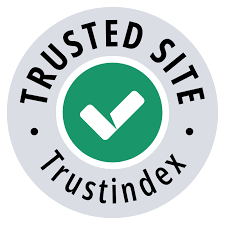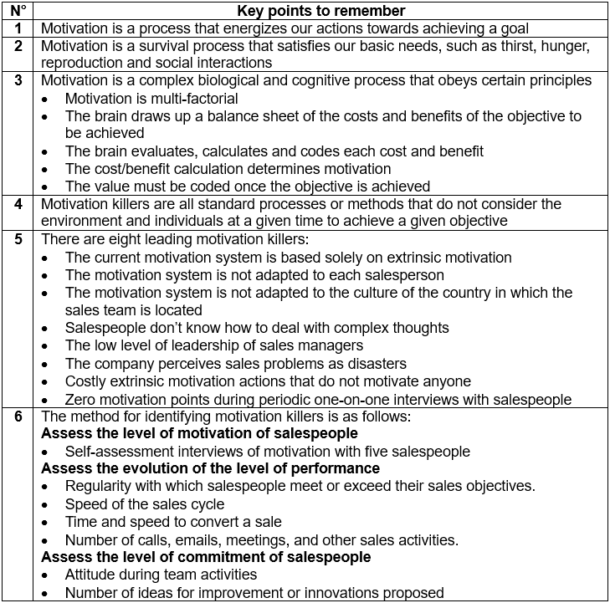Reimagining Sales – WDP1 (Revenue Killers)

The Appleton Greene Corporate Training Program (CTP) for Reimagining Sales is provided by Mr. Dardelin Certified Learning Provider (CLP). Program Specifications: Monthly cost USD$2,500.00; Monthly Workshops 6 hours; Monthly Support 4 hours; Program Duration 12 months; Program orders subject to ongoing availability.
If you would like to view the Client Information Hub (CIH) for this program, please Click Here
Learning Provider Profile

Mr Dardelin is a Certified Learning Provider (CLP) with Appleton Greene. He has a dual business and scientific background, with an MSc in Hospitality Management from ESSEC (Paris) and an MSc in Applied Neurosciences from King’s College (London).
He started his career in the luxury hotel and leisure industry as a sales director and then hotel director, where he acquired solid sales and customer service experience. Then, he specialized in auditing, training, and strategy consulting. He worked in international audit and consulting groups as a senior consultant and then as project director, where he carried out productivity optimization and reorganization missions for multinational companies in the USA, Europe, and Asia.
Mr Dardelin has become an expert in growth strategy, productivity optimization, customer experience, sales strategies, sales training, and disruptive management.
For over 30 years, he created and has managed a growth strategy consulting firm with large European clients. In this capacity, he led consulting projects involving sales teams ranging from 500 to 10,000 people.
Mr Dardelin has developed a unique professional training method that is playful and of remarkable efficiency. This registered method, called RUN TRAINING©, based on repetition and the acquisition of reflexes, allows all types of professionals to acquire or improve the practices that sell in a very short time.
What makes Mr Dardelin strong is helping his clients quickly and efficiently implement winning strategies that overcome operational obstacles and constraints.
Mr Dardelin is multilingual and speaks seven languages fluently.
He has commercial experience in the following countries: Belgium, Brazil, Canada, China, England, France, Germany, Kuwait, Netherlands, Spain, Singapore, Switzerland, United States.
He has industry experience in the following sectors: Automotive, Airlines, Casino and Gaming, Fast moving consumer goods, Energy, Financial Services, Food Industry, Hospitality, Insurance, Leisure, Luxury, Retail
MOST Analysis
Mission Statement
This first workshop is a return to basics. In the fast-paced world of sales, it’s easy to get caught up in future projections and complex strategies. However, it’s important to remember that the foundation of our business is the daily interactions with our customers. What is the point of making assumptions about the turnover we will gain in 12 or 24 months when we can demonstrate that we lose it every day with customers who come to buy and that we have not been able to transform?
The first part of our program will be devoted to identifying among your internal sales processes those that are not in line with your growth objectives. By addressing the causes of unidentified turnover leaks, we can pave the way for significant growth.
We understand the complexity of your sales organization. Decade after decade, companies determine internal processes that are supposed to be the right answer to win and retain more customers. Often, these processes are added to existing ones without simplifying them. We’re here to help you navigate this complexity.
Never in the last ten years have sales organizations been under such pressure to change and adapt to all the challenges that companies face: digital transformation, the need to innovate, successive economic crises, sustainable development and many more.
This adaptation to constantly changing market conditions pushes the company’s functional departments (HR, finance, marketing, IT, etc.) to generate more and more tools to use, data to collect and processes to apply.
We often arrive at a situation that is out of control or, starting from a sincere objective, to help the sales department gain market share, flood the sales teams with rules, information, and data. We thus create monsters that slow down growth or kill turnover. Sales teams need more time to get used to a new method or procedure before integrating another. This “always more efficient” situation often masks the negative impact on productivity, customer experience, and the desire to do well for the sales teams, which usually results in a loss of turnover.
You will learn to observe and analyse your organization to identify and value the turnover you lose every day, the main cause of which is the application of unsuitable processes. These unsuitable processes, which we refer to as ‘turnover killers ‘, are those that lead to the loss of potential sales or customers. Their financial impact has never been calculated, making them a significant but often overlooked issue in sales management.
You will understand the difference between your main KPIs and these turnover killers. The former is calculated automatically by your computerized management systems; the latter can only be identified empirically and by observing the daily activity of your organization. Turnover killers are hidden everywhere at the level of your customers and distributors, as well as in the recruitment and integration of your salespeople or the coaching or management methods of the latter. Some turnover killers are easy to correct; others require a medium-term solution.
You will know who in your organization has the best profile to identify your turnover killers and prepare the recommendations to present to your executive committee. The result to be achieved is to:
1. Perfectly understand all your sales processes and how they are used
2. Know how much turnover you lose daily because of some of these processes. You will thus earn sums ranging from a few thousand dollars to several millions. It is not about making more sales but about recovering those that you lose each day because of certain inefficient or outdated aspects of your sales organization
Objectives
01. Introduction: What is the definition of a revenue killer? Understand revenue killers with examples. Why identify revenue killers? What skills to identify revenue killers? How do we identify revenue killers?
02. Client killers: What is a client killer? Understand client killers with examples. Method to identify client killers in B2C. Method to identify client killers in B2B.
03. Distributor killers: What is a distributor killer? Understand distributor killers with examples. Method to identify distributor killers.
04. Productivity killers: What is the definition of a productivity killer? Understand productivity killers with examples. Method to identify productivity killers.
05. Recruitment killers: What is the definition of a recruitment killer? Explain recruitment killers with an example. Identify a method to identify recruitment killers.
06. Onboarding killers: What is an onboarding killer? Understanding onboarding killers with an example. Method for identifying onboarding Killers.
07. Sales coaching killers: What is a sales coaching killer? Understanding sales coaching killers with an example. Method to identify Sales Coaching Killers.
08. Sales management killers: What is a sales management killer? Understanding sales management killers with examples. Method to identify sales management killers.
09. Reporting killers: What is a reporting killer? Understand reporting killers with an example. Significance of the method to Identify reporting Killers from the finance department. The importance of the technique in Identifying reporting killers from the sales department.
10. Resources killer: What is a resources killer? Understand resource killers as an example—the significance of the method to identify resource killers.
11. Motivation killers: What is a motivation killer? Understand motivation killers with examples. Significance of the method to Identify Motivation Killers.
12. Evaluation killers: What is a motivation killer? Understand motivation killers with examples. Significance of the method to Identify Motivation Killers.
Strategies
01. Introduction: Determine which aspects of your company’s sales approach you will focus on to identify revenue killers
02. Client killers: Your customers are not just buyers; they are integral to your sales approach. Involve them in identifying and analyzing customer killers to make them feel valued and integral to the process.
03. Distributor killers: Strengthen your distributor relationships by empathizing with their challenges and constraints
04. Productivity killers: Improve productivity by viewing the development of turnover as a structured mathematical equation
05. Recruitment killers: Involve your customers and salespeople in evaluating your recruitment processes
06. Onboarding killers: See the onboarding of future salespeople as a real business plan
07. Sales coaching killers: See real-time sales coaching as a strategic tool to make your salespeople better than your competitors
08. Sales management killers: See sales management as a systematic and mandatory process regardless of the personality of the sales managers
09. Reporting killers: Transform your vision of the reporting system into a solving system to improve the performance of the sales team
10. Resources killers: Resolve the paradox between obtaining quick results and medium-term investment for the sales team
11. Motivation killers: To ensure the best results, develop and implement a scientific approach to motivating your sales team, providing reassurance and confidence in your methods.
12. Evaluation killers: Base the performance evaluation system on future achievements instead of a review of the past
Tasks
01. Introduction:
1. Identify the people within your organization with the skills to analyse killer customers.
2. Adapt the method for identifying killer customers in your organization.
3. Decide where, when, and what to observe so that the results represent what is being done today within the sales organization.
02. Client killers:
1. Prepare the sample of customers who will participate in the analysis.
2. Prepare the tools and questionnaires that are useful for collecting the analysis data.
3. Prepare the program and the sequence of observations and customer interviews.
03. Distributor killers:
1. Prepare the sample of distributors who will participate in the analysis.
2. Determine what and how to observe your distributors without disrupting their daily activity.
3. Prepare the tools and questionnaires that are useful for collecting the analysis data.
4. Prepare the program and the sequence of observations and distributor interviews.
04. Productivity killers:
1. Prepare the observation reports.
2. List the tasks that do not generate revenue.
3. Analyse how the sales team optimizes its productivity between systematic and unplanned activities.
05. Recruitment killers:
1. Prepare the tools and questionnaires that will help collect data from the analysis.
2. Involve candidates and sales managers in evaluating your recruitment process.
3. Evaluate the recruitment process of a future salesperson step by step.
06. Onboarding killers:
1. Obtain feedback from salespeople and sales managers on the current onboarding process.
2. Identify unsuitable processes or steps in your current onboarding process.
3. Calculate the direct and hidden costs associated with an unsuitable onboarding process.
07. Sales coaching killers:
1. Observe sales managers in real situations, coaching their salespeople.
2. Obtain feedback from salespeople and sales managers on the current coaching system.
3. Make a quantitative and qualitative assessment of the current sales coaching system.
08. Sales management killers:
1. List the essential and useless tasks of your sales managers.
2. Observe a sample of your sales managers in real management situations.
3. Assess whether the current sales management mode aligns with your business strategy.
09. Reporting killers:
1. Calculate the time spent by sales and finance teams preparing reporting.
2. Assess the quantity and usefulness of the KPIs measured.
3. Make a quantitative and qualitative assessment of the solutions implemented following regular reporting of results.
10. Resources killers:
1. Analyse the productivity of the sales process.
2. Compare the company’s sales resources with those of competitors.
3. Analyse the internal budget decision-making system.
11. Motivation killers:
1. Assess the level of motivation of salespeople, the evolution of their performance level, and their level of commitment.
12. Evaluation killers:
1. Assess the loss of productivity linked to evaluating salespeople.
2. Assess the internal perception of the evaluation process.
3. Assess the added value of the evaluation process.
4. Measure the progress of KPIs per salesperson over three to six months to see the correlation between the evaluation and performance improvement.
Introduction
What are revenue killers?
We are starting this program with a term rarely used in business: Revenue Killers. At a time when all companies, regardless of their size and sector of activity, are looking for performance as quickly as possible, identifying revenue killers allows you to generate a surplus in turnover or a reduction in costs as soon as possible without having to make assumptions about the potential return on investment. A revenue killer is a process, practice, or unsuitable sales tool that causes your company to lose turnover daily. A revenue killer can result in a loss of productivity for your salespeople, for example, with preparation time for a sales visit and reporting taking longer than the duration of the customer meeting. It can also result in the retail sector salespeople who have never been trained to sell quickly and well during peak customer traffic, resulting in customers who come to buy and leave without buying. A revenue killer can also be a process that has no direct impact on turnover but on the ability of your salespeople to work faster, more fluidly or be more innovative and creative than your competitors’ salespeople. By identifying and addressing these revenue killers, your company can look forward to a potential increase in turnover and a brighter future.
Where are revenue killers coming from?
Revenue killers do not appear in your company overnight. They are generated over several years and are the result of several situations.
• A culture of control: Your vision is that everything must be controlled, especially what concerns the commercial aspect. You have set up processes and methods to check, analyse and explain everything. Your salespeople spend more time explaining and justifying what they do rather than devoting the maximum time to caring for the customer and selling.
• A lack of investment: Your salespeople have been left to their own devices for several years with sales methods and tools from the industrial era that are unsuitable for dealing with the challenges of the digital economy.
• A lack of continuous improvement: Methods and processes are the answers to working in a homogeneous manner at the desired level of quality and productivity. Processes are like medicines; they have a limited use-by date. 50% of the sales processes you defined and implemented 3 or 5 years ago no longer provide any added value today if they have not been updated yearly.
• A self-centred culture. Your company is one of the recognized leaders in the market. You are sure of your products, vision and methods that have guaranteed your success. This self-centred culture has the consequence of developing internal resistance to change and to anything external to your company. The action guide of your sales team becomes: “We’ve always done it this way”. A too strong culture resists innovation and leads to processes unsuited to market needs.
• A strategic gap. For example, you have defined a development strategy based on customer orientation. Still, specific functional departments work autonomously and in a compartmentalized manner and produce processes that prioritize other objectives and negatively impact the power of action of your sales department.
Why it is important to identify revenue killers?
In an economic environment of lasting crises, sudden changes and uncertainties are the new paradigms. Companies can define 5-year strategies, but who can predict that these strategies will still be relevant in 12 or 24 months? A company that wants to remain or become a leader in its market can make assumptions but must be ready to change course as quickly as necessary to follow or anticipate market developments or reductions. Eliminating revenue killers not only allows you to gain speed and commercial agility but also opens a world of potential growth and agility. The sales department can thus adapt more quickly to changes in customer behaviour, loss of market share, new legislation, and others. The sales team can rapidly develop new markets or defend itself against new competitors, paving the way for a brighter future.
Identifying revenue killers is a powerful tool that allows you to measure the extent to which your main competitor is yourself. You are losing customers or market share because you let your competitors advance based on your commercial weaknesses, whether it is poorly or poorly trained salespeople, insufficient resources, or a sales management style inherited from another century that only generates frustration. By identifying these revenue killers, you can take back control and steer your business towards success.
The sales department is often the ‘lost department’ in terms of budget and resource allocation. By ‘lost department ‘, we mean that it is often overlooked or underfunded compared to other departments. Our vision of the sales department is that sales are a question of motivation and aggressiveness. Companies with a weak sales culture tend to conclude too quickly that if sales results are insufficient, salespeople need to prospect more or be sufficiently motivated. The Management Committee will be quick for a single second to invest millions of dollars in any technological change requested by the finance or IT department. Still, it will refuse the Sales Department the creation of one or two necessary sales positions. Identifying revenue killers allows us to calculate the turnover lost due to bad budgetary decisions accurately.
Finally, identifying revenue killers will enable you to calculate the daily turnover accurately lost due to unsuitable processes and recover the IRT or immediate return on turnover. We remember a meeting with the CEO of a large retail group who was sceptical about our approach and did not see how to increase his company’s turnover by 15% with equal resources when no one in his company, including him, had managed to do so. We replied that we agreed with him and that increasing turnover by 15% was impossible. The objective is to recover the 15% of turnover lost each day with customers who come to buy and leave the store without being able to buy.
Understanding the symptoms of your revenue killers:
Since revenue killers are the causes of a drop in turnover, productivity, or increased costs, they can only be identified when the situation is analysed. However, certain symptoms can put you on alert and are the manifestation of hidden revenue killers:
• A drop in your customer conversion rate
• A longer sales cycle than that of your competitors
• A drop in sales of certain families of your products at your distributors
• A drop in the number of new customers
• Sales managers who keep repeating that they are overwhelmed
• Difficulties in recruiting new salespeople
• An increasing turnover rate of your salespeople
• Difficulty in correcting declining KPIs
• Low motivation and involvement of the sales team
Where to identify revenue killers?
We have identified 11 areas where your revenue killers may be hiding, each with the potential to significantly impact your business. These have been divided into two categories. The first category is for revenue killers with a direct link to the loss of daily turnover. The second category is for those with an indirect link to turnover leakage.
Revenue killers with a direct link to the loss of turnover
1. Client killers
2. Distributor killers
3. Productivity killers
4. Reporting killers
Revenue killers with an indirect link to the loss of turnover
5. Recruitment killers
6. Onboarding killers
7. Sales coaching killers
8. Sales management killers
9. Motivation killers
10. Resource killers
11. Evaluation killers
Remember, you are not required to audit all 11 areas. Instead, based on your experience, the feedback from your sales team, and the different symptoms that you perceive, you should select from these 11 areas that seem to you to be priorities. However, we strongly advise that you focus your analysis on the first 4 areas that have a direct link to turnover loss.
How do we identify revenue killers?
1. Select a domain
2. Choose the internal auditor
3. Collect written or digital data
4. Conduct qualitative interviews
5. Observe at the point of sale
6. Make a photo report
7. Summarize and prioritize the data collected
8. Write the presentation report for the Management Committee
1. Select a domain
Select as a priority from the 11 recommended domains those that seem most relevant to the audit. It is essential to prepare clear communication before the audit with all the interlocutors who will participate in the data collection or various interviews.
2. Choose the internal auditor
The profile of internal auditors is described in the introduction module of the course manual. The number of auditors will depend on the size of your company and its local, national, or international geographical presence. If you are a global company with subsidiaries in several countries, it is possible that your revenue killers are not hidden in just a few countries. Since identifying revenue killers is a methodical job that requires much concentration, we advise you not to ask the same people to audit all the selected areas but to limit the role of each auditor to one or two areas.
3. Collect written or digital data
The first step of the audit is to collect all the documents relating to the audited area. The number and type of documents to be collected are based on the chronological path to complete the tasks in the audited area successfully. For the sales management field, for example, the chronological path could be as follows:
• Onboarding interview
• Setting objectives
• Initial training
• End of trial period interview
• On-site coaching
• Performance review
• Regular feedback
• Help with resolving customer problems
• Motivational action
• Evaluation
For each stage of the sales management path, the auditor will ask the sales department to provide all the written and digital documents used. The quality and completeness of the document collection will also depend on the auditor’s curiosity.
4. Conduct qualitative interviews
As auditors, their role in conducting various types of qualitative interviews with customers, distributors, sales managers, and other contacts is crucial. Their confidence and competence in these interviews are directly influenced by your rigorous preparation. Here are our recommendations, illustrated with an example of a qualitative interview with a B2B client:
Define the objective of the interview: You must determine what you want to learn or understand through this interview?
Example: What is the customer’s opinion on our current sales approach?
Identify the interview topics: Now you need to break down the objective into several themes of questions to be addressed with the customer:
Example: Sales visits, relationship with the salesperson, quality of service, response to urgent or specific requests, comparison with the competition, suggestions for improvement
The wording of the questions to ask: Questions must be worded to encourage the customer to talk about their experience. Avoid biased questions that do not lead to any answers (e.g., ‘Are you satisfied with our sales department?’).
The internal auditor must approach the interview like a forensic investigator, collecting all the clues and details necessary to understand the customer’s perspective. The aim here is to have complete, fair, and factual answers. Questions must be simple, in less than ten words. Technical jargon must be avoided. Any interlocutor must be able to understand the question. The questions must start with broad topics and then arrive at specific points.
• Example of an experience-based question: Can you tell us about your experience with our sales department?
• Example of an opinion-based question: What do you no longer want to see in the business relationship with a supplier?
• Example of a reflective question: What has changed the most in your customers’ expectations since COVID-19?
Before conducting the survey, it’s essential to test the questionnaire in a pilot interview. This step allows you to assess the clarity and understanding of the questions, ensuring that they are straightforward and comprehensible to the customer. As the internal auditor, their role in refining the questionnaire based on the feedback from the pilot interview is crucial and greatly appreciated.
5. Observe at the point of sale
Whether in a customer’s office, a store, or a supermarket, observing salespeople and in a sales situation is one of the main ways to identify several killer revenues. The following rules must be respected for practical observation:
Define the objectives: What do you want to understand as a priority?
Example: Observe the ability of retail salespeople to sell in less than 10 minutes at times when customer traffic is highest
Inform the sales teams: Reassure the salespeople by explaining the observation objectives and that it is not an assessment and will not lead to any consequences.
Choose the time of observation: choose times when the sales situation is representative of the objective
Example: Observation from 4:00 p.m. to 7:00 p.m. when customers finish work and come to shop.
Define the observation method: for a face-to-face observation in B2B sales, you must accompany the salesperson to their customer. In retail sales, it is preferable to equip the salesperson with a microphone for remote observation. You can use recorded calls on the phone.
Observe from sales standards: It is preferable to observe the practices of salespeople by comparing them to a sales reference. If this sales benchmark does not exist, creating it before the observation is preferable.
Example of observation criteria for a salesperson visiting a distributor
• The salesperson has made a quick and factual analysis of the quantitative indicators that have progressed or declined since the last visit
• The salesperson has prepared a visit objective linked to the numerical analysis
• The salesperson has observed the store’s activity to complete his quantitative analysis with facts
• The salesperson has sold the objective of the visit associated with a benefit for the distributor
• The salesperson makes the distributor talk to get his opinion on what has changed in the store since the last visit
• The salesperson encourages the distributor to set his objectives first
• The salesperson proposes an order volume more significant than that proposed by the distributor
• The salesperson argues with factual and precise levers
• The salesperson has reflex responses to the distributor’s main tactics to avoid ordering
• The salesperson defines with the distributor a priority sales action with means and deadlines
• The salesperson negotiates and obtains the distributor’s commitment to implement the priority sales action
• The salesperson obtains the three mandatory results of the visit
6. Make a photo report:
The most compelling evidence that often requires no commentary is visual. Each auditor’s role in this is crucial, as they will need to capture the essence of the sales representatives’ offices, screen prints, store windows or stockrooms, or even the sales representative’s company car. These images will serve as a powerful tool in our audit process.
7. Synthesize and prioritize all the data collected:
As auditors, your role in accumulating information for each area is vital. This information must be carefully sorted, kept, eliminated, and organized. The process of data synthesis and prioritization is a key step in our audit, as it allows us to make sense of the information we’ve gathered.
You must familiarize yourself with the data and reread the qualitative interviews several times. You take notes in the margins during this first reading. You apply codes to the relevant information you develop as you go along, allowing you to put similar data in the same category—examples of code: Competition, disputes, deadlines. You then group all the data with the same codes in a category and identify relationships between each piece of information or data. We then build themes and sub-themes that represent these different relationships, and that will be the first draft of the final report plan.
8. Write the presentation report for the Management Committee
The final report is a culmination of our audit process and is of utmost importance. It must be written in a way that can be presented in less than 30 minutes to the Management Committee and the sales department. Your role in this is significant, as the report must be concise, yet comprehensive, and must effectively communicate our findings and recommendations.
1. An introduction that recalls the objectives of the audit on revenue killers as well as the topics that will be presented. The introduction must highlight the amount of turnover that can be recovered by eliminating revenue killers to arouse interest immediately. This sets the stage for the audience, making them aware of the audit’s purpose and potential benefits.
2. The current context of the sales department with its structure, the size of the team, the results, and a comparison with the industry standard
3. The summary of the audit findings highlights the sales department’s strengths and weaknesses. It also identifies points of alignment and non-alignment with market challenges, lists the main revenue killers identified, and calculates the daily turnover lost.
4. The detailed report area by area with what was observed, the killers identified, and turnover lost
5. The recommendations: Which revenue killer should be eliminated as a priority and why? The new processes to implement and those to eliminate or simplify and the implementation plan
6. The conclusion will include the presentation’s main points, findings, recommendations, and the next steps. This section is crucial as it provides a concise summary of the audit, the key findings, the recommended actions, and the proposed timeline for implementation, ensuring a clear understanding and facilitating decision-making.
Executive Summary
Companies, much like human bodies, require constant care to stay healthy. Some treatments are beneficial, while others can be detrimental. The key is to diagnose the issues accurately and act swiftly. Over time, companies may lose sight of the effects of these ‘treatments’ on their daily operations.
The larger the company, the more it is a process factory whose objectives are all to provide solutions. Year after year, these processes accumulate, are not questioned, and no longer provide any added value. They slow down the operation and, more particularly, the sales organization. Salespeople apply complex procedures or methods, waste time, or are no longer adapted to the constantly changing challenges of the market. The consequences are turnover leaks that no one suspects since they are neither identified nor measured.
Opportunity being addressed
The objective of this workshop is to identify all the turnover killers in your sales organization. These turnover killers all directly or indirectly impact a daily turnover leak that can amount to millions of dollars over a year. Turnover killers can be complex processes that cause a loss in productivity or are not customer oriented. They can be sales habits or practices that no longer meet market needs. They can also be tools or technologies that slow down the work of salespeople. Finally, they can be a vision of the company that goes against customer and commercial logic, all of which have a significant impact on your company’s bottom line.
This workshop is a crucial part of our program. It will allow us to assess the exact amount of turnover you lose every day, which can range from 5% to 15% of your annual turnover. Your participation is key to the success of this initiative.
Proposed solution
Our solution is organized into 12 courses that follow one another logically.
Chapter 1: Introduction:
In this course, you will learn what a revenue killer is and the difference between it and margin profitability. Margin analysis and optimization is a much easier task than identifying revenue killers. The reasons are as follows:
1. Margin analysis is mainly based on numerical data that can be easily obtained
2. Most of these data and figures are automatically entered and calculated by the company’s various software and reporting tools
3. The analysis of these data can be done remotely
4. The critical factors of profitability and margin calculation are known to all and the same regardless of the sector of activity and the country of the company
Identifying revenue killers is more complicated and complex for the following five reasons:
1. The logic is not to find solutions to increase turnover but to identify what causes it to be lost daily
2. Certain methods and procedures applied today in your sales organization that have been sources of growth in the past are the cause of today’s losses. They are, therefore not questioned by those who use them
3. Since turnover killers are essentially unsuitable methods and practices, the identification method will be 80% based on observation of the activity and sales teams and little on an analysis of numerical data
4. Turnover killers are different depending on the activity of the company. It is difficult to model them in such a way that we have revenue killers common to all activities
5. Identifying revenue killers is not on the curriculum of most Business Schools
Once identified, you will be able to classify your revenue killers into eight categories according to three criteria:
• Recurrence: The revenue killer is one-off or permanent
• Impact on loss of turnover: direct or indirect
• Ease of correcting the revenue killer: easy or complex to solve
You will know what skills are needed to identify your revenue killers internally, and you will learn to identify your revenue killers using a 5-step method: The context, the question, the revenue killer, the causes, the identification method.
Chapter 2: Client Killers
In this course, you will gain practical knowledge to differentiate between customer satisfaction, a complex and multi-causal concept, and client killers. You will be equipped to identify and address unsuitable processes or methods that result in a customer with a purchase intention not buying.
You will then discover two methods for identifying customer killers adapted to two sales modes: B2C (Retail) sales and B2B sales
For B2C sales, it is mainly a question of observing and analysing whether your stores are capable of:
• Selling quickly and well during times of high customer traffic
• Achieving high sales during times of low traffic
For B2B sales, identifying B2B customer killers is done in several ways:
• Collecting qualitative information by interviewing the company’s customers
• Studying all commercial documents sent to customers
• Observing the practices of salespeople in real sales situations
Chapter 3: Distributor Killers
If you are involved in selling your products through a network of distributors, this course is specifically designed to address the challenges you face.
Distributor killers are very closely linked to the upheavals in recent years in this sales channel. Whether your distributors are exclusive or non-exclusive, having a distribution network means completely delegating the sale of your products to a third party. Selling through a distributor network was relatively straightforward until now. Distributors are now facing difficulties that are lasting and significantly impacting their sales.
• A labour shortage
• Aggressive competition and mainly pure players on the WEB who offer products of equivalent quality at prices that can go up to -40% or -50%.
• Increasingly demanding Customers find out and check the distributor’s Google score and customer reviews before travelling.
• Considering sustainable development and CSR (corporate social responsibility) has become an obligation.
Today’s distributor is overwhelmed by daily life. He manages emergencies, whether at the level of his teams, his customers, or his suppliers. His margins are also reduced. He no longer has time to anticipate the constant changes in his own business. In such a context, everything that the company does not do to help the distributor overcome its own operational constraints and remain efficient generates direct or indirect turnover losses.
In this course, you will learn to identify and ask yourself two questions to identify your distributor killers:
1. Do your salespeople have all the skills and methods to acquire new distributors according to the objectives defined by your growth strategy?
2. Do your salespeople have all the skills and methods to help the distributor analyse its results, identify the causes of performance or underperformance, and implement specific sales actions that generate turnover
Chapter 4: Productivity killers
Understanding the importance of time management is the key to commercial success. This course will not only equip you with methods and skills, but also instil the understanding that effective time management is the true differentiator among salespeople.
Two salespeople start their work week on Monday morning and end on Friday evening simultaneously. They will spend the same hours at work prospecting, making commercial offers, negotiating, and signing new contracts. The difference between the first is that they sign more contracts in a week or a month of work, and the second is that they do not use their time similarly. The real wealth of a sales team is not the turnover but how time is used, rationalized, and optimized to produce this turnover.
You will discover in this course where you can identify the productivity losses that directly impact your turnover. You will analyse as a priority the following areas that are sources of sales productivity leakage:
1. Multitasking
2. Sales time management
3. Lack of processes
4. The quantity and complexity of processes
5. Internal meetings
6. Sales visit reports
7. Cannibalization of agendas
8. Zero organization of daily or weekly activity
9. The skills gap
10. The motivation of the sales team
You will then be able to determine:
• What useless tasks should salespeople no longer do?
• Do the practical tasks, but for reasons of unsuitable processes or any other reason, take too much time?
• The total useless time invested in these tasks multiplied by the hourly cost of a salesperson
Chapter 5: Recruitment Killers
In this course, you will discover the profound significance of the seven essential qualities that are common to all successful sales teams: Having an open mind, being flexible, fast, opportunistic, rigorous, and friendly. These qualities are not just words, but the pillars of a successful recruitment process.
Your sales team’s recruitment process must be consistent with these seven qualities. It would help if you had an open mind because often, the best candidate for you will not necessarily be the one with ten years of experience in your sector but perhaps the one who will have none. Your recruitment process must be flexible and adapt to your current and future market. Is a job profile written more than 12 months ago still relevant? You will need to be able to recruit quickly because good candidates have many opportunities. If you are recruiting, it is because you need more resources. Every day, you lose turnover with one or more salespeople who need to be included. You must have an opportunistic vision, no matter if you doubt that this or that candidate will not stay in your company for more than two to three years. If he is one of your best salespeople, he will collaborate with you the entire time. You must be rigorous in your decision-making and evaluation methods for the qualities of candidates. And lastly, you will have to be friendly because the basis of any business is empathy with your customers, suppliers, and employees. A friendly approach in recruitment is not just a choice, but a necessity in today’s business world.
Recruitment killers are the silent assassins that can cripple your team’s productivity. They are defined by all the beliefs, methods, tools, and tests that do not align with or oppose the seven essential qualities. Identifying and eliminating these killers is not just a task, but a mission to safeguard your team’s productivity.
You will discover in this course where you can identify productivity losses that directly impact your turnover. You will analyse as a priority the following areas that have an indirect effect on turnover leaks:
1. Your company is hermaphrodite
2. You do not have KPIs to measure the performance of your recruitment
3. At what stages is your recruitment process rigid? 4. Do your personality tests have a scientific basis
4. Is your vision of recruiting your salespeople based on myths?
5. Where are the imbalances in your recruitment process
6. Where are your technology gaps in your recruitment journey
You will then be able to evaluate your recruitment killers based on the following factual elements: Time to hire, cost to hire, retention rate, hiring manager satisfaction, candidate rejection reason, cost of a resignation
Chapter 6: Onboarding Killers
You will gain a crucial understanding of onboarding killers. These are the methods, habits, and unsuitable means that prolong the time each salesperson spends between their first day of work and the day they sign their first customers.
The absence of a robust integration process can wreak havoc on your customer satisfaction and the growth of your turnover.
The time required for your salespeople to be ‘ready to sell’ will be extended, leading to increased salaries for reduced productivity and results. This financial strain underscores the need to address onboarding killers to improve sales performance and reduce costs.
Some new salespeople are likely to resign. They do not understand your objectives and what is expected of them. This implies increased costs for their replacement and a direct loss of turnover linked to the position vacancy.
You take risks at the level of your customers. Your new salespeople who are not sufficiently prepared will not bring all the added value your customers seek regarding advice, services and products. You will not be able to prevent your customers from comparing your new salespeople with those of your competitors, and this generates, at best, dissatisfaction and, at worst, the loss of one or more customers.
In this course, you will discover where and how to identify your onboarding killers by digging into eight areas that have an indirect impact on revenue leaks:
1. An absence or weakness of the integration program
2. A failure to highlight the customer experience
3. A program that does not encourage your new salespeople to make efforts to learn
4. Your new salespeople do not sufficiently master the products to be sold
5. Zero or poor feedback during the onboarding program
6. Internal trainers have insufficient skills in adult training
7. Insufficient time spent mastering technical tools
You will then be able to evaluate the cost of your onboarding killers based on the following factual elements:
• The average cost of recruiting a new salesperson multiplied by the current turnover rate
• The loss in productivity
• The loss of revenue linked to dissatisfied customers
• The additional management time to correct post-onboarding shortcomings
• The overall annual costs
Chapter 7: Sales coaching Killers
This course is uniquely designed to provide a comprehensive understanding of Sales Coaching, a strategic tool that aims to empower salespeople to sell more and enhance their sales performance. It stands out from other courses by offering a practical approach immediately applicable to your sales team.
You will see that very few companies see sales coaching as a strategic activity and have implemented a mandatory and regular coaching method for their sales teams. The reason is simple. It isn’t easy to measure the direct impact of sales coaching on growth and turnover in the short term. A sales coaching approach is an approach that only produces results in the medium and long term. In an economic environment where immediate return on investment is the priority, we often ignore all sources of growth that do not meet this criterion, including sales coaching.
All sales can be summed up by what your salespeople say and do out of habit. Some habits are good because they meet what the customer wants or what needs to be done to sign. Other habits are bad because they do not meet the customer’s idea of the sales approach. In a market context where everything is constantly changing, all salespeople, without exception, have bad habits, and the worst is that their bad habits today were their good habits yesterday. It’s urgent to address these bad habits to stay competitive in the market.
Sales today are a competition. The products and competitors are excellent. Prices are calculated as accurately as possible. Customers are experienced. Sales approaches are prepared down to the smallest detail. However, no one finds it abnormal to let salespeople lead this competition, left to their own devices, without any sales trainer to support them in correcting the details that will make the difference compared to competitors’ salespeople.
A sales coaching killer is the absence of a method or the use of unsuitable methods to support, observe, and improve the habits of salespeople that kill turnover in an actual sales situation.
You will know where to focus to identify your coaching killers:
1. General Management often fails to recognize the value and impact of sales coaching
2. The company confuses sales training with sales coaching
3. The company has not formalized its commercial know-how
4. The company’s sales know-how is not regularly updated
5. The wrong person does coach
6. Sales Managers have not been trained in coaching
7. Coaching sessions are irregular
8. Sales Coaching is not part of the variable remuneration of Sales Managers
9. Coaching sessions are not motivating or boring
You will learn how to:
• Make a quantitative assessment of the current coaching system
• Make a qualitative assessment of the current coaching system
• Assess the coaching skills of sales managers
• Get feedback from sales managers on the coaching system
• Get feedback from salespeople on the coaching system
Chapter 8: Sales management Killers
Sales management involves all the actions and processes that help salespeople sell more and be satisfied so that customers buy more and are satisfied themselves. Therefore, it is based on two variables: processes and actions.
Sales management processes are the guiding principles for sales managers. They encompass all the rules, standards, and methods defined and written down so sales managers can apply them to their mission. These processes, which are the result of the company’s collective managerial experience and vision, provide a clear direction for salespeople. They are not universal but are adapted to the business, the customer’s purchasing journey, and the organization of the sales team’s work. In essence, these processes are the roadmap that sales managers follow to lead their teams to success.
You will see that management actions arise from the processes and personality of each sales manager. Management actions are all the sales manager’s face-to-face or remote interactions with his teams. A monthly feedback interview between the sales manager and each of his salespeople is based on both the company’s processes in terms of substance and the sales manager’s personal impact in terms of form.
Based on these simple components of sales management, sales management killers are all the sales management processes and actions that slow down or prevent salespeople from selling more and satisfying their customers. These ‘killers’ could include ineffective sales training, lack of clear communication, or even high turnover rates, all of which can hinder sales team productivity and customer satisfaction.
At the end of your analysis of your sales management killers, you will be empowered to make the necessary changes and improvements to your sales management method, aligning it with your company’s strategy and challenges.
Chapter 9: Reporting Killers
The true essence of reporting lies in its ability to solve. If reporting fails to assist the sales department in dissecting the causes of underperformance and formulating straightforward and swift solutions to rectify them, then it loses its purpose. In essence, reporting should not be termed as such, but rather as a problem-solving tool.
We can distinguish two categories of reporting killers.
The first is all the reporting killers generated by the finance department. Overly complex reporting, an abundance of KPIs, or a lack of automation can have a truly negative impact on the sales team’s performance.
The second category is all the reporting killers generated by the sales department. This underscores the crucial role of the sales team in the reporting process. How are the figures and analyses from the finance department used to correct the discrepancies? Do sales managers can analyse the causes and imagine simple and quick solutions? Do salespeople have the will and the skills to correct these discrepancies?
In this era of continuous challenges, reporting should be more than just a tool. It should be the critical instrument that enables the sales team to outpace your competitors. Reporting killers are all the processes, tools, and technologies that hinder the sales team from swiftly and effectively addressing any alert results.
In this course, you will learn how to identify your reporting killers generated by the finance and sales department and assess whether:
• Your reporting can reveal all the gaps and worrying trends over several periods
• Your sales department make a fair analysis of the causes of underperformance?
• The corrective actions implemented are relevant
• Your reporting allows you to measure the direct impact of corrective actions
• Your reporting allows the sales department to anticipate potential declines?
Chapter 10: Resource Killers
Sales teams need more resources and tools than they did 20 years ago. In today’s fast-paced business environment, salespeople are expected to be highly productive. With company performance now evaluated quarterly, the pressure is on. Shareholders and investors eagerly await the publication of quarterly results to continue investing in the companies in their portfolios. This situation necessitates that the sales team develops sales and acquires new customers as quickly as possible, in line with the pace of the publication of quarterly results. In this competitive landscape, each salesperson’s productivity is crucial. Non-value-added tasks must be automated to optimize their time and focus on high-value-added actions to convert as many sales as possible.
Resource killers can be anything from outdated CRM systems to inefficient lead generation tools. These are the tools that are unsuitable or lacking for the sales team, hindering their ability to save time, make omnichannel sales, and hyper-personalize the sales approach.
In this course, you will learn how to:
1. Analyse the productivity of the sales process:
2. Compare the company’s sales resources with those of competitors:
3. Analyse the internal budget decision-making system
You will then be able to deduce:
• What are the very high value-added sales process stages where salespeople lack tools?
• To what extent do competitors’ salespeople have more resources and means than your company?
• What are the short-and medium-term consequences of this lack of resources?
• Were the decisions taken regarding budget allocation for the sales department in favour of sales development and growth? If not, for what reasons?
Chapter 11: Motivation Killers
As you delve into this course, you’ll come to understand that motivation is not just a simple process, but a complex one with profound implications. It’s the driving force that energizes our actions towards achieving a goal, and in the context of sales, it’s a critical factor that can make or break performance.
Delving into the intricate workings of motivation is a fascinating journey. It’s a complex interplay of biological and cognitive processes, a puzzle that even the most brilliant minds in neuroscience and cognitive psychology are still piecing together.
Here, ‘motivation killers’ refer to standard processes or methods that fail to consider the environment and the individuals involved at a given time when aiming for a specific goal.
Throughout this course, you’ll gain the skills to:
1. Assess the level of motivation of salespeople
2. Assess the evolution of the performance level
3. Assess the level of commitment of salespeople
To then assess the impact of:
• Negative work environment
• Lack of resources and tools
• Inadequate financial package and reward
• Unclear objectives
• Low level of sales manager leadership
• Insufficient career development
• Overwhelming workload
• Inefficient sales processes
• Lack of alignment with personal motivation
Chapter 12: Evaluation Killers
It’s alarming that three out of ten employees feel their voices are stifled during annual performance reviews. Equally concerning is the fact that 95% of managers are dissatisfied with the current system, with 70% deeming it a mere waste of time (source BVA group 2019).
The Reimagining Sales program should enable you to continuously transform your sales organization as changes are made in an economy of lasting crises.
Discover the significant advantages of eliminating any performance evaluation system in this course. In an era of ubiquitous information and knowledge sharing, employees are taking charge of their careers and companies. Hierarchies are flattening, and top-down evaluation processes are proving counterproductive in sales organizations. The benefits of eliminating any evaluation system are numerous:
• One of the key benefits is the empowerment of salespeople. Without the constraints of rigid evaluation criteria, they are free to innovate, be creative, and take control of their own success.
• Less stress: Salespeople no longer feel the weight of control and can focus on developing turnover without the anxiety of the annual review, promoting a more relaxed and focused work environment.
• Better team spirit: The absence of evaluation reduces the sense of individual competition. Instead, the team works in a spirit of shared success, fostering a sense of belonging and camaraderie.
• More excellent responsiveness: Eliminating the evaluation process allows faster adaptation to changes. We do not worry about whether it is within the scope of our skills or not.
• Saving time and money: The gains in productivity and time-related to eliminating the evaluation process are very significant. The Human Resources department can focus on activities with higher added value for sales development, such as coaching in sales situations or ongoing training for salespeople, promoting a more efficient and productive work environment.
• Developing a culture of trust: Zero evaluation means that the company trusts its sales team, creating high motivation and involvement.
Curriculum

Reimagining Sales – WDP1 – Revenue Killers
- Introduction
- Client killers
- Distributor killers
- Productivity killers
- Recruitment killers
- Onboarding killers
- Sales coaching killers
- Sales management killers
- Reporting killers
- Resources killers
- Motivation killers
- Evaluation killers
Distance Learning
Introduction
Welcome to Appleton Greene and thank you for enrolling on the Reimagining Sales corporate training program. You will be learning through our unique facilitation via distance-learning method, which will enable you to practically implement everything that you learn academically. The methods and materials used in your program have been designed and developed to ensure that you derive the maximum benefits and enjoyment possible. We hope that you find the program challenging and fun to do. However, if you have never been a distance-learner before, you may be experiencing some trepidation at the task before you. So, we will get you started by giving you some basic information and guidance on how you can make the best use of the modules, how you should manage the materials and what you should be doing as you work through them. This guide is designed to point you in the right direction and help you to become an effective distance-learner. Take a few hours or so to study this guide and your guide to tutorial support for students, while making notes, before you start to study in earnest.
Self-assessment
Appleton Greene training programs are in all cases post-graduate programs. Consequently, you should already have obtained a business-related degree and be an experienced learner. You should therefore already be aware of your study strengths and weaknesses. For example, which time of the day are you at your most productive? Are you a lark or an owl? What study methods do you respond to the most? Are you a consistent learner? How do you discipline yourself? How do you ensure that you enjoy yourself while studying? It is important to understand yourself as a learner and so some self-assessment early on will be necessary if you are to apply yourself correctly. Perform a SWOT analysis on yourself as a student. List your internal strengths and weaknesses as a student and your external opportunities and threats. This will help you later when you are creating a study plan. You can then incorporate features within your study plan that can ensure that you are playing to your strengths, while compensating for your weaknesses. You can also ensure that you make the most of your opportunities, while avoiding the potential threats to your success.
Implementation
It is not the quality of the content that makes a training program powerful; it is your ability to apply all the techniques or knowledge communicated in the same program. Most training programs fail at the time of implementation because they have yet to be prepared. This is the first step that you must think about and plan before starting your training. To best plan the implementation of each of the 12 training modules of the Reimagining Sales program, we recommend the following actions:
• Who are the people who will be trained? What are their existing skills or knowledge related to the program that we can build upon?
• Before the program, it’s important to identify any significant skills gaps and take steps to address them. This proactive approach will ensure a smoother training process. Ask yourself, is there a significant skills gap compared to the program? What should be done upstream of the program to reduce this skills gap?
• Who will be the key figure responsible for coordinating the implementation and ensuring its success?
• Has the company already implemented similar medium and long-term programs on other subjects? What were the benefits? What were the obstacles? What lessons have been learned from these previous programs for implementing this one?
• Does any new know-how involve internal resistance in the implementation? Which individuals or teams are likely to resist the implementation? What are the reasons? Are the reasons justified or simply a fear of change?
• Before the program starts, it’s crucial to involve and inform the teams that are likely to be the most resistant. This early involvement fosters a sense of ownership and can significantly reduce resistance. Consider, how can we inform and involve these teams before the program starts?
• What are the current strengths and weaknesses of the trained teams?
• What are the training objectives and training goals of the program?
• How and who will measure them?
• How can we ensure that the new know-how will be applied daily? Who will monitor the daily implementation?
• Who will collect feedback on the implementation? Who should provide input? The trained teams? The customers? Others? Their feedback is crucial for the success of the program.
• How can we correct techniques that need to be adapted to specificities or unforeseen events as they go along?
• When will we say that the program is a success?
• What actions will be taken to celebrate success with all those who have invested in its implementation?
Motivation
Success in distance learning, like any other form of learning, is, first and foremost, a question of motivation. You will succeed because you are highly motivated. You will fail because your level of motivation is insufficient. Motivation allows you to stay focused and persevere. It would help if you had a clear idea of what you want or do not want. Learning is integrating new knowledge and practices, which must be a means of achieving your goals, needs, and dreams. Acquiring new know-how incompatible with your professional and personal goals would make no sense. Motivation is also a question of belief. You must be convinced that you will succeed even if you study remotely. You must not fear failure because failure does not exist on the path to knowledge. With 85 billion neurons, your brain can learn anything; it is just a matter of time and repetition. Finally, if you have decided to learn new things, it is because you are changing and want better things to happen. You are what you know, and your life will be the consequence of what you have or have not learned.
Exceptional results need focus and engagement
To excel in your studies, it’s crucial to understand that exceptional results require exceptional efforts. This doesn’t mean working long hours on the same subject, but rather focusing on one thing at a time for an extended period. The program you’ve chosen to pursue is equivalent to a Master of Science, demanding your full attention. Remember, your commitment and focus are the keys to your success. Stay determined and keep your eyes on the prize.
During your learning journey, you’ll need to immediately apply what you’ve learned and repeat, repeat, and repeat. It’s through this experience and repetition that you’ll be able to apply the techniques you’ve learned in a natural and fluid manner, regardless of the professional situation. Remember, genius is simply the practice of the same know-how for at least twenty years. So, don’t be disheartened by initial challenges. With consistent practice, you’ll notice significant improvement in your skills.
Regardless of your initial knowledge on the subject, your commitment lies in the time you’ll invest in the long term. This time is divided into three distinct parts. The first part is to read and understand the program’s content; the second part is to delve deeper into each subject through personal research, whether on the WEB, through articles, books, or interviews with experts in the field. The third part is experience and practical application in a professional situation. Be patient; it’s not because what you apply doesn’t yield immediate results that the technique is flawed; it’s simply that your level of practice is insufficient. According to linguists, it takes an average of 1000 hours to learn and speak a new foreign language fluently. By deciding to reduce the time we spend watching television, we could all learn a new foreign language every year. Success in everything you undertake by following this program is not initially a question of experience or academic training, just a question of mathematics and personal commitment. From the moment you commit to investing this time over time, you cannot fail, and if you fail due to an exceptional combination of circumstances, you will only have yourself to blame. You will have missed one or more motivation/concentration/time/duration elements.
Understand how the brain works in a learning situation.
If you want to learn, understand, and memorize quickly and well, it is essential that you have a minimum knowledge of how your brain works when you are in a learning situation. Our brain weighs about 2% of the total body weight but consumes 20% of all the energy derived from our glucose, making it our primary consumer. Therefore, any cognitive effort over time is exhausting (memory, attention, analysis, obstacle assessment, method research).
Norman Mackworth, a British psychologist, was recruited during the Second World War by the Royal Air Force to study the efficiency of radar operators. He devised a test using the Mackworth Clock to study the effects of concentration over time in signal detection. The test results showed that the vigilance of radar operators decreased sharply after 30 minutes, and detection errors increased by 10 to 15%. You will now understand why all learning methods, remote or physical, suggest taking a 5-minute break every 25 to 30 minutes of intellectual activity.
Learning remotely also means freeing yourself from all the false beliefs that could limit your almost unlimited abilities, what we call neuromyths. The first neuromyth is the belief that we only use 10% of our brains. It is scientifically proven, mainly thanks to neuroimaging, that we use 100% of our brain in most activities.
The second neuromyth is to believe that you are more creative. You use your right brain or rational because you use your left brain. This belief is false and comes from the fact that there is a relative asymmetry in the functioning of the right and left lobes of the brain. Broca’s area, for example, which manages language function, is in the left part of the cerebral cortex, whether you are right-handed or left-handed.
The third neuromyth is believing that you can multitask. Science has already proven that the brain cannot focus on several tasks simultaneously. Multitasking means working more slowly and making more mistakes. The fourth neuromyth is believing in visual, auditory, and kinaesthetic learning styles. Believing that you will learn faster depending on which sense you prefer (vision, hearing, touch) is not based on any scientific basis and will not improve the quality or speed of your learning.
Self-discipline
To achieve your training goals, you must invest time and schedule regular study appointments during your work week. Keeping these appointments regardless of the unexpected is preferable to ensure progressive and easy learning. 100% of learners agree with the idea that you need to determine a learning schedule and stick to it. Many task optimization and productivity software can help you in this regard. However, achieving and exceeding your learning goals is not a question of planning but of self-discipline. No software will force you to sit in front of your computer to study for 90 minutes as written on your schedule when you are tired, you have had a tiring day at work and part of your mind is charming you to relax by watching your favorite TV series. Only a strong sense of self-discipline, a quality that you can cultivate, will be the key to respecting your training schedule. Self-discipline is not just a tool for achieving your training goals, but a key to personal growth and empowerment. You can already assess your sense of self-discipline by asking yourself the following questions:
• I never wait until the last minute to do what I must do.
• I don’t leave any task unfinished.
• I don’t need anyone to remind me of deadlines for submitting my work.
• I don’t need anyone else to motivate me to finish my work.
• I can prioritize what I must do.
• I generally manage my time well between scheduled and recurring tasks and unplanned activities.
• I can think critically.
• I know that I am solely responsible for my learning and that if I am not motivated to succeed, no one else can be motivated in my place.
• I can understand written instructions.
Study environment
Ideally, it is best to study in a quiet room where you can cut yourself off from any external disturbance. You can also establish certain rituals before, during and after learning that will allow you to create a pleasant and relaxing environment. You can only study in this ideal environment 20% of the time. Suppose you want to stick to your work schedule at all costs for 80% of the time. In that case, you will have to learn to study and concentrate in any environment: An airport waiting room, a train, a plane, a hotel room, a coworking space where colleagues, couriers and delivery people pass in front of you every 2 minutes. Assume that the norm will be to develop your ability to learn in noisy environments where nothing is done to stay focused and that the bonus will be to study in peace in your favourite place. We recommend that you try the following rules to select the ones that will give you the best results:
• Keep your phone away from your computer and turn it off as much as possible
• Use earplugs or noise-cancelling headphones
• Music, particularly instrumental genres like classical or jazz, can be a powerful tool to eliminate background noise and help you concentrate. By choosing the right music, you can create a study environment that suits your needs, regardless of the external noise.
• Read the content of your training manual once and classify the subjects into two categories: tasks that seem simple to you and those that seem difficult to you. Organize your time so that you will learn the most straightforward tasks when you know there will be the most noise or other disturbances.
• Eat and drink before studying. The feeling of hunger is created by the absence of food in the stomach and a decrease in the level of glucose in the blood. Through a complex biological process, your digestive nervous system communicates with your brain, which will cause the search for food and decrease your concentration.
• Hydration is key for optimal cognitive function. The brain, which is composed of 80% water, requires adequate hydration to function at its best. Studies show that even a 1% dehydration can lead to a 5% decrease in cognitive functions. Therefore, it’s important to stay hydrated to maintain your focus and memory.
Training objectives and training goals
You will find the training objectives at the beginning of each of the 12 modules. These are standard objectives and do not consider the context of your company, the specific issues, the acquired knowledge, and the initial skills of your teams. However, you, as the manager or trainer, have the responsibility and the power to set your own objectives based on the same content. We advise you to use the following method to set your objectives. First, you must differentiate between training objectives and training goals.
Remember, a training objective is not just a personal goal, but a strategic alignment with the company’s mission. It’s a clear description of what you want to be able to do or know at the end of the training, and it must be consistent with the objectives of your company or department. Your role in setting these objectives is crucial to the company’s success.
They must be concise, formulated in a single sentence and use action verbs (do, identify, question, observe). Anything seen, heard, and done professionally can be considered a training objective.
Here are some examples of training objectives:
• Be able to lead customer feedback interviews in less than 30 minutes
• Lead weekly one-minute coaching sessions with each of my salespeople
• Know and be able to respond to the five most common errors of judgment when defending prices
Here are some examples of erroneous training objectives:
• Have a more aggressive sales team in prospecting
• Improve the attitude of sales managers
• Have a customer relations department that listens more to customers
Keep in mind, whatever your training objectives, simplicity and humility are key. It’s important to be realistic about the number of objectives to achieve. Remember, it takes time for the brain to adapt. Don’t overwhelm with more than two to three training objectives per training module. This approach will help you and your team feel reassured and confident in your training strategy.
A training goal is the result expected by the company in terms of performance. Each training goal must correspond to one or more training objectives. Example of training goal:
• Achieve a Net Promoter Score of 70 by:
• Training salespeople to lead 30-minute customer feedback interviews
• Training sales managers to provide weekly minute coaching to their salespeople
Study forecast
The Appleton Greene Reimagining Sales corporate training program should take 12-18 months to complete, depending upon your availability and current commitments. The reason why there is such a variance in time estimates is because every student is an individual, with differing productivity levels and different commitments. These differentiations are then exaggerated by the fact that this is a distance-learning program, which incorporates the practical integration of academic theory as an as a part of the training program. Consequently, all the project studies are real, which means that important decisions and compromises need to be made. You will want to get things right and will need to be patient with your expectations to ensure that they are. We would always recommend that you are prudent with your own task and time forecasts, but you still need to develop them and have a clear indication of what are realistic expectations in your case. With reference to your time planning: consider the time that you can realistically dedicate towards study with the program every week; calculate how long it should take you to complete the program, using the guidelines featured here; then break the program down into logical modules and allocate a suitable proportion of time to each of them, these will be your milestones; you can create a time plan by using a spreadsheet on your computer, or a personal organizer such as MS Outlook, you could also use a financial forecasting software; break your time forecasts down into manageable chunks of time, the more specific you can be, the more productive and accurate your time management will be; finally, use formulas where possible to do your time calculations for you, because this will help later on when your forecasts need to change in line with actual performance. With reference to your task planning: refer to your list of tasks that need to be undertaken in order to achieve your program objectives; with reference to your time plan, calculate when each task should be implemented; remember that you are not estimating when your objectives will be achieved, but when you will need to focus upon implementing the corresponding tasks; you also need to ensure that each task is implemented in conjunction with the associated training modules which are relevant; then break each single task down into a list of specific to do’s, say approximately ten to do’s for each task and enter these into your study plan; once again you could use MS Outlook to incorporate both your time and task planning and this could constitute your study plan; you could also use a project management software like MS Project. You should now have a clear and realistic forecast detailing when you can expect to be able to do something about undertaking the tasks to achieve your program objectives.
Keeping in touch with Appleton experts
You will have access to qualified and experienced professors and tutors who are responsible for providing tutorial support for your training program. So don’t be shy about letting them know how you are getting on. We keep electronic records of all tutorial support emails so that professors and tutors can review previous correspondence before considering an individual response. It also means that there is a record of all communications between you and your professors and tutors, and this helps to avoid any unnecessary duplication, misunderstanding, or misinterpretation. If you have a problem relating to the program, share it with them via email. It is likely that they have come across the same problem before and are usually able to make helpful suggestions and steer you in the right direction. To learn more about when and how to use tutorial support, please refer to the Tutorial Support section of this student information guide. This will help you to ensure that you are making the most of tutorial support that is available to you and will ultimately contribute towards your success and enjoyment with your training program.
Share with you peers and build your own learning community
The mistake not to make when learning in distance learning is to think that you are alone and to stay alone. We advise you to share your new knowledge with your peers. They can be your colleagues, managers, customers, or suppliers. You will get the following benefits:
1. Your peers will have interpretations of different points of view from the same subject. They will thus give you a more complete vision. They will help you clarify your doubts or unresolved difficulties.
2. You will have access to a way of thinking and working collectively. Pooling ideas will allow you to apply more thoughtful, complete, and practical solutions.
3. You will develop your communication skills. You will be forced to communicate your ideas or questions. You will get used to receiving peer feedback and accepting constructive criticism.
4. You will stay motivated throughout your learning. You will not feel alone.
5. You will have created a learning community. Your peers will help you solve some problems of understanding or implementation. You will share through a virtual or physical community that you have created resources, press articles, and feedback on the program’s topics. Other professionals will spontaneously join your learning community, thus developing your professional network and new opportunities.
Self-assessment of performance
We strongly encourage you to make this self-assessment a monthly ritual. By doing so, you can track your progress, learn from it, and continually strive for self-improvement.
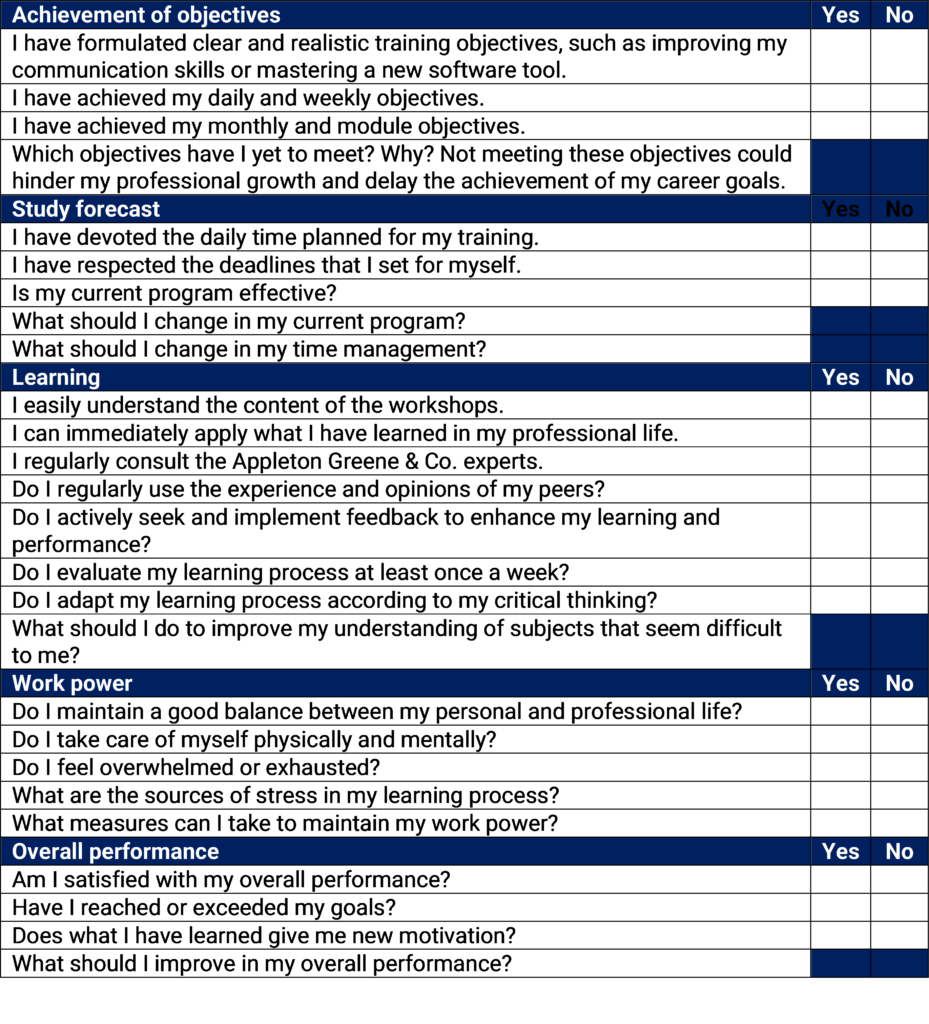
Distance learning checklist
Prepare your study environment, your study tools, and rules.
Undertake detailed self-assessment in terms of your ability as a learner.
Create a format for your study plan.
Consider your learning objectives and goals
Create a study forecast.
Stay focused and disciplined
Assess monthly your study performance.
Re-evaluate your study forecast.
Be consistent when managing your study plan.
Use your Appleton Greene Certified Learning Provider (CLP) for tutorial support.
Make you create your learning community and use your peer’s experience

Tutorial Support
Programs
Appleton Greene uses standard and bespoke corporate training programs as vessels to transfer business process improvement knowledge into the heart of our clients’ organizations. Each individual program focuses upon the implementation of a specific business process, which enables clients to easily quantify their return on investment. There are hundreds of established Appleton Greene corporate training products now available to clients within customer services, e-business, finance, globalization, human resources, information technology, legal, management, marketing, and production. It does not matter whether a client’s employees are located within one office, or an unlimited number of international offices, we can still bring them together to learn and implement specific business processes collectively. Our approach to global localization enables us to provide clients with a truly international service with that all important personal touch. Appleton Greene corporate training programs can be provided virtually or locally, and they are all unique in that they individually focus upon a specific business function. They are implemented over a sustainable period and professional support is consistently provided by qualified learning providers and specialist consultants.
Support available
You will have a designated Certified Learning Provider (CLP) and an Accredited Consultant, and we encourage you to communicate with them as much as possible. In all cases tutorial support is provided online because we can then keep a record of all communications to ensure that tutorial support remains consistent. You would also be forwarding your work to the tutorial support unit for evaluation and assessment. You will receive individual feedback on all the work that you undertake on a one-to-one basis, together with specific recommendations for anything that may need to be changed in order to achieve a pass with merit or a pass with distinction and you then have as many opportunities as you may need to re-submit project studies until they meet with the required standard. Consequently, the only reason that you should really fail (CLP) is if you do not do the work. It makes no difference to us whether a student takes 12 months or 18 months to complete the program, what matters is that in all cases the same quality standard will have been achieved.
Support Process
Please forward all your future emails to the designated (CLP) Tutorial Support Unit email address that has been provided and please do not duplicate or copy your emails to other AGC email accounts as this will just cause unnecessary administration. Please note that emails are always answered as quickly as possible, but you will need to allow a period of up to 20 business days for responses to general tutorial support emails during busy periods, because emails are answered strictly within the order in which they are received. You will also need to allow a period of up to 30 business days for the evaluation and assessment of project studies. This does not include weekends or public holidays. Please therefore kindly allow for this within your time planning. All communications are managed online via email because it enables tutorial service support managers to review other communications which have been received before responding and it ensures that there is a copy of all communications retained on file for future reference. All communications will be stored within your personal (CLP) study file here at Appleton Greene throughout your designated study period. If you need any assistance or clarification at any time, please do not hesitate to contact us by forwarding an email and remember that we are here to help. If you have any questions, please list and number your questions succinctly and you can then be sure of receiving specific answers to each query.
Time Management
It takes approximately 1 Year to complete the Reimagining Sales corporate training program, incorporating 12 x 6-hour monthly workshops. Each student will also need to contribute approximately 4 hours per week over 1 Year of their personal time. Students can study from home or work at their own pace and are responsible for managing their own study plan. There are no formal examinations and students are evaluated and assessed based upon their project study submissions, together with the quality of their internal analysis and supporting documents. They can contribute more time towards study when they have the time to do so and can contribute less time when they are busy. All students tend to be in full time employment while studying and the Reimagining Sales corporate training program is purposely designed to accommodate this, so there is plenty of flexibility in terms of time management. It makes no difference to us at Appleton Greene, whether individuals take 12-18 months to complete this program. What matters is that in all cases the same standard of quality will have been achieved with the standard and bespoke programs that have been developed.
Distance Learning Guide
The distance learning guide should be your first port of call when starting your training program. It will help you when you are planning how and when to study, how to create the right environment and how to establish the right frame of mind. If you can lay the foundations properly during the planning stage, then it will contribute to your enjoyment and productivity while training later. The guide helps to change your lifestyle to accommodate time for study and to cultivate good study habits. It helps you to chart your progress so that you can measure your performance and achieve your goals. It explains the tools that you will need for study and how to make them work. It also explains how to translate academic theory into practical reality. Spend some time now working through your distance learning guide and make sure that you have firm foundations in place so that you can make the most of your distance learning program. There is no requirement for you to attend training workshops or classes at Appleton Greene offices. The entire program is undertaken online, program course manuals and project studies are administered via the Appleton Greene web site and via email, so you can study at your own pace and in the comfort of your own home or office as long as you have a computer and access to the internet.
How To Study
The how to study guide provides students with a clear understanding of the Appleton Greene facilitation via distance learning training methods and enables students to obtain a clear overview of the training program content. It enables students to understand the step-by-step training methods used by Appleton Greene and how course manuals are integrated with project studies. It explains the research and development that is required and the need to provide evidence and references to support your statements. It also enables students to understand precisely what will be required of them to achieve a pass with merit and a pass with distinction for individual project studies and provides useful guidance on how to be innovative and creative when developing your Unique Program Proposition (UPP).
Tutorial Support
Tutorial support for the Appleton Greene Reimagining Sales corporate training program is provided online either through the Appleton Greene Client Support Portal (CSP), or via email. All tutorial support requests are facilitated by a designated Program Administration Manager (PAM). They are responsible for deciding which professor or tutor is the most appropriate option relating to the support required and then the tutorial support request is forwarded onto them. Once the professor or tutor has completed the tutorial support request and answered any questions that have been asked, this communication is then returned to the student via email by the designated Program Administration Manager (PAM). This enables all tutorial support, between students, professors, and tutors, to be facilitated by the designated Program Administration Manager (PAM) efficiently and securely through the email account. You will therefore need to allow a period of up to 20 business days for responses to general support queries and up to 30 business days for the evaluation and assessment of project studies, because all tutorial support requests are answered strictly within the order in which they are received. This does not include weekends or public holidays. Consequently, you need to put some thought into the management of your tutorial support procedure to ensure that your study plan is feasible and to obtain the maximum possible benefit from tutorial support during your period of study. Please retain copies of your tutorial support emails for future reference. Please ensure that ALL your tutorial support emails are set out using the format as suggested within your guide to tutorial support. Your tutorial support emails need to be referenced clearly to the specific part of the course manual or project study which you are working on at any given time. You also need to list and number any questions that you would like to ask, up to a maximum of five questions within each tutorial support email. Remember the more specific you can be with your questions the more specific your answers will be too, and this will help you to avoid any unnecessary misunderstanding, misinterpretation, or duplication. The guide to tutorial support is intended to help you to understand how and when to use support in order to ensure that you get the most out of your training program. Appleton Greene training programs are designed to enable you to do things for yourself. They provide you with a structure or a framework and we use tutorial support to facilitate students while they practically implement what they learn. In other words, we are enabling students to do things for themselves. The benefits of distance learning via facilitation are considerable and are much more sustainable in the long-term than traditional short-term knowledge sharing programs. Consequently, you should learn how and when to use tutorial support so that you can maximize the benefits from your learning experience with Appleton Greene. This guide describes the purpose of each training function and how to use them and how to use tutorial support in relation to each aspect of the training program. It also provides useful tips and guidance regarding best practice.
Tutorial Support Tips
Students are often unsure about how and when to use tutorial support with Appleton Greene. This Tip List will help you to understand more about how to achieve the most from using tutorial support. Refer to it regularly to ensure that you are continuing to use the service properly. Tutorial support is critical to the success of your training experience, but it is important to understand when and how to use it to maximize the benefit that you receive. It is no coincidence that those students who succeed are those that learn how to be positive, proactive, and productive when using tutorial support.
Be positive and friendly with your tutorial support emails
Remember that if you forward an email to the tutorial support unit, you are dealing with real people. “Do unto others as you would expect others to do unto you”. If you are positive, complimentary, and generally friendly in your emails, you will generate a similar response in return. This will be more enjoyable, productive, and rewarding for you in the long-term.
Think about the impression that you want to create
Every time that you communicate, you create an impression, which can be either positive or negative, so put some thought into the impression that you want to create. Remember that copies of all tutorial support emails are stored electronically, and tutors will always refer to prior correspondence before responding to any current emails. Over a period, a general opinion will be arrived at in relation to your character, attitude, and ability. Try to manage your own frustrations, mood swings and temperament professionally, without involving the tutorial support team. Demonstrating frustration or a lack of patience is a weakness and will be interpreted as such. The good thing about communicating in writing, is that you will have the time to consider your content carefully, you can review it and proof-read it before sending your email to Appleton Greene and this should help you to communicate more professionally, consistently and to avoid any unnecessary knee-jerk reactions to individual situations as and when they may arise. Please also remember that the CLP Tutorial Support Unit will not just be responsible for evaluating and assessing the quality of your work, they will also be responsible for providing recommendations to other learning providers and to client contacts within the Appleton Greene global client network, so do be in control of your own emotions and try to create a good impression.
Remember that quality is preferred to quantity
Please remember that when you send an email to the tutorial support team, you are not using Twitter or Text Messaging. Try not to forward an email every time that you have a thought. This will not prove to be productive either for you or for the tutorial support team. Take time to prepare your communications properly, as if you were writing a professional letter to a business colleague and make a list of queries that you are likely to have and then incorporate them within one email, say once every month, so that the tutorial support team can understand more about context, application, and your methodology for study. Get yourself into a consistent routine with your tutorial support requests and use the tutorial support template provided with ALL your emails. The (CLP) Tutorial Support Unit will not spoon-feed you with information. They need to be able to evaluate and assess your tutorial support requests carefully and professionally.
Be specific about your questions to receive specific answers
Try not to write essays by thinking as you are writing tutorial support emails. The tutorial support unit can be unclear about what in fact you are asking, or what you are looking to achieve. Be specific about asking questions that you want answers to. Number your questions. You will then receive specific answers to each and every question. This is the main purpose of tutorial support via email.
Keep a record of your tutorial support emails
It is important that you keep a record of all tutorial support emails that are forwarded to you. You can then refer to them when necessary and it avoids any unnecessary duplication, misunderstanding, or misinterpretation.
Individual training workshops or telephone support
Please be advised that Appleton Greene does not provide separate or individual tutorial support meetings, workshops, or provide telephone support for individual students. Appleton Greene is an equal opportunity learning and service provider, and we are therefore understandably bound to treat all students equally. We cannot therefore broker special financial or study arrangements with individual students regardless of the circumstances. All tutorial support is provided online, and this enables Appleton Greene to keep a record of all communications between students, professors and tutors on file for future reference, in accordance with our quality management procedure and your terms and conditions of enrolment. All tutorial support is provided online via email because it enables us to have time to consider support content carefully, it ensures that you receive a considered and detailed response to your queries. You can number questions that you would like to ask, which relate to things that you do not understand or where clarification may be required. You can then be sure of receiving specific answers to each individual query. You will also then have a record of these communications and of all tutorial support, which has been provided to you. This makes tutorial support administration more productive by avoiding any unnecessary duplication, misunderstanding, or misinterpretation.
Tutorial Support Email Format
You should use this tutorial support format if you need to request clarification or assistance while studying with your training program. Please note that ALL of your tutorial support request emails should use the same format. You should therefore set up a standard email template, which you can then use as and when you need to. Emails that are forwarded to Appleton Greene, which do not use the following format, may be rejected and returned to you by the (CLP) Program Administration Manager. A detailed response will then be forwarded to you via email usually within 20 business days of receipt for general support queries and 30 business days for the evaluation and assessment of project studies. This does not include weekends or public holidays. Your tutorial support request, together with the corresponding TSU reply, will then be saved and stored within your electronic TSU file at Appleton Greene for future reference.
Subject line of your email
Please insert: Appleton Greene (CLP) Tutorial Support Request: (Your Full Name) (Date), within the subject line of your email.
Main body of your email
Please insert:
1. Appleton Greene Certified Learning Provider (CLP) Tutorial Support Request
2. Your Full Name
3. Date of TS request
4. Preferred email address
5. Backup email address
6. Course manual page name or number (reference)
7. Project study page name or number (reference)
Subject of enquiry
Please insert a maximum of 50 words (please be succinct)
Briefly outline the subject matter of your inquiry, or what your questions relate to.
Question 1
Maximum of 50 words (please be succinct)
Maximum of 50 words (please be succinct)
Question 3
Maximum of 50 words (please be succinct)
Question 4
Maximum of 50 words (please be succinct)
Question 5
Maximum of 50 words (please be succinct)
Please note that a maximum of 5 questions is permitted with each individual tutorial support request email.
Procedure
* List the questions that you want to ask first, then re-arrange them in order of priority. Make sure that you reference them, where necessary, to the course manuals or project studies.
* Make sure that you are specific about your questions and number them. Try to plan the content within your emails to make sure that it is relevant.
* Make sure that your tutorial support emails are set out correctly, using the Tutorial Support Email Format provided here.
* Save a copy of your email and incorporate the date sent after the subject title. Keep your tutorial support emails within the same file and in date order for easy reference.
* Allow up to 20 business days for a response to general tutorial support emails and up to 30 business days for the evaluation and assessment of project studies, because detailed individual responses will be made in all cases and tutorial support emails are answered strictly within the order in which they are received.
* Emails can and do get lost. So, if you have not received a reply within the appropriate time, forward another copy or a reminder to the tutorial support unit to be sure that it has been received but do not forward reminders unless the appropriate time has elapsed.
* When you receive a reply, save it immediately featuring the date of receipt after the subject heading for easy reference. In most cases the tutorial support unit replies to your questions individually, so you will have a record of the questions that you asked as well as the answers offered. With project studies however, separate emails are usually forwarded by the tutorial support unit, so do keep a record of your own original emails as well.
* Remember to be positive and friendly in your emails. You are dealing with real people who will respond to the same things that you respond to.
* Try not to repeat questions that have already been asked in previous emails. If this happens the tutorial support unit will probably just refer you to the appropriate answers that have already been provided within previous emails.
* If you lose your tutorial support email records you can write to Appleton Greene to receive a copy of your tutorial support file, but a separate administration charge may be levied for this service.

How To Study
Your Certified Learning Provider (CLP) and Accredited Consultant can help you to plan a task list for getting started so that you can be clear about your direction and your priorities in relation to your training program. It is also a good way to introduce yourself to the tutorial support team.
Planning your study environment
Your study conditions are of great importance and will have a direct effect on how much you enjoy your training program. Consider how much space you will have, whether it is comfortable and private and whether you are likely to be disturbed. The study tools and facilities at your disposal are also important to the success of your distance-learning experience. Your tutorial support unit can help with useful tips and guidance, regardless of your starting position. It is important to get this right before you start working on your training program.
Planning your program objectives
It is important that you have a clear list of study objectives, in order of priority, before you start working on your training program. Your tutorial support unit can offer assistance here to ensure that your study objectives have been afforded due consideration and priority.
Planning how and when to study
Distance-learners are freed from the necessity of attending regular classes, since they can study in their own way, at their own pace and for their own purposes. This approach is designed to let you study efficiently away from the traditional classroom environment. It is important however, that you plan how and when to study, so that you are making the most of your natural attributes, strengths and opportunities. Your tutorial support unit can offer assistance and useful tips to ensure that you are playing to your strengths.
Planning your study tasks
You should have a clear understanding of the study tasks that you should be undertaking and the priority associated with each task. These tasks should also be integrated with your program objectives. The distance learning guide and the guide to tutorial support for students should help you here, but if you need any clarification or assistance, please contact your tutorial support unit.
Planning your time
You will need to allocate specific times during your calendar when you intend to study if you are to have a realistic chance of completing your program on time. You are responsible for planning and managing your own study time, so it is important that you are successful with this. Your tutorial support unit can help you with this if your time plan is not working.
Keeping in touch
Consistency is the key here. If you communicate too frequently in short bursts, or too infrequently with no pattern, then your management ability with your studies will be questioned, both by you and by your tutorial support unit. It is obvious when a student is in control and when one is not and this will depend how able you are at sticking with your study plan. Inconsistency invariably leads to in-completion.
Charting your progress
Your tutorial support team can help you to chart your own study progress. Refer to your distance learning guide for further details.
Making it work
To succeed, all that you will need to do is apply yourself to undertaking your training program and interpreting it correctly. Success or failure lies in your hands and your hands alone, so be sure that you have a strategy for making it work. Your Certified Learning Provider (CLP) and Accredited Consultant can guide you through the process of program planning, development and implementation.
Reading methods
Interpretation is often unique to the individual, but it can be improved and even quantified by implementing consistent interpretation methods. Interpretation can be affected by outside interference such as family members, TV, or the Internet, or simply by other thoughts which are demanding priority in our minds. One thing that can improve our productivity is using recognized reading methods. This helps us to focus and to be more structured when reading information for reasons of importance, rather than relaxation.
Speed reading
When reading through course manuals for the first time, subconsciously set your reading speed to be just fast enough that you cannot dwell on individual words or tables. With practice, you should be able to read an A4 sheet of paper in one minute. You will not achieve much in the way of a detailed understanding, but your brain will retain a useful overview. This overview will be important later on and will enable you to keep individual issues in perspective with a more generic picture because speed reading appeals to the memory part of the brain. Do not worry about what you do or do not remember at this stage.
Content reading
Once you have speed read everything, you can then start work in earnest. You now need to read a particular section of your course manual thoroughly, by making detailed notes while you read. This process is called Content Reading and it will help to consolidate your understanding and interpretation of the information that has been provided.
Making structured notes on the course manuals
When you are content reading, you should be making detailed notes, which are both structured and informative. Make these notes in a MS Word document on your computer, because you can then amend and update these as and when you deem it to be necessary. List your notes under three headings: 1. Interpretation – 2. Questions – 3. Tasks. The purpose of the 1st section is to clarify your interpretation by writing it down. The purpose of the 2nd section is to list any questions that the issue raises for you. The purpose of the 3rd section is to list any tasks that you should undertake as a result. Anyone who has graduated with a business-related degree should already be familiar with this process.
Organizing structured notes separately
You should then transfer your notes to a separate study notebook, preferably one that enables easy referencing, such as a MS Word Document, a MS Excel Spreadsheet, a MS Access Database, or a personal organizer on your cell phone. Transferring your notes allows you to have the opportunity of cross-checking and verifying them, which assists considerably with understanding and interpretation. You will also find that the better you are at doing this, the more chance you will have of ensuring that you achieve your study objectives.
Question your understanding
Do challenge your understanding. Explain things to yourself in your own words by writing things down.
Clarifying your understanding
If you are at all unsure, forward an email to your tutorial support unit and they will help to clarify your understanding.
Question your interpretation
Do challenge your interpretation. Qualify your interpretation by writing it down.
Clarifying your interpretation
If you are at all unsure, forward an email to your tutorial support unit and they will help to clarify your interpretation.
Qualification Requirements
The student will need to successfully complete the project study and all the exercises relating to the Reimagining Sales corporate training program, achieving a pass with merit or distinction in each case, to qualify as an Accredited Process Re-engineering Specialist (APRS). All monthly workshops need to be tried and tested within your company. These project studies can be completed in your own time and at your own pace and in the comfort of your own home or office. There are no formal examinations, assessment is based upon the successful completion of the project studies. They are called project studies because, unlike case studies, these projects are not theoretical, they incorporate real program processes that need to be properly researched and developed. The project studies assist us in measuring your understanding and interpretation of the training program and enable us to assess qualification merits. All of the project studies are based entirely upon the content within the training program, and they enable you to integrate what you have learnt into your corporate training practice.
Reimagining Sales – Grading Contribution
Project Study – Grading Contribution
Introduction – 05%
Client killers – 10%
Distributor killers – 10%
Productivity killers – 10%
Recruitment killers – 05%
Integration killers – 05%
Sales coaching killers – 10%
Sales management killers – 10%
Reporting killers – 10%
Motivation killers – 10%
Resources killers – 10%
Evaluation killers – 05%
TOTAL GRADING – 100%
Qualification grades
A mark of 90% = Pass with Distinction
A mark of 75% = Pass with Merit
A mark of less than 75% = Fail
If you fail to achieve a mark of 75% with a project study, you will receive detailed feedback from the Certified Learning Provider (CLP) and/or Accredited Consultant, together with a list of tasks which you will need to complete, in order to ensure that your project study meets with the minimum quality standard that is required by Appleton Greene. You can then re-submit your project study for further evaluation and assessment. Indeed, you can re-submit as many drafts of your project studies as you need to, until such a time as they eventually meet with the required standard by Appleton Greene, so you need not worry about this, it is all part of the learning process.
When marking project studies, Appleton Greene is looking for sufficient evidence of the following:
Pass with merit
A satisfactory level of program understanding
A satisfactory level of program interpretation
A satisfactory level of project study content presentation
A satisfactory level of the practical integration of academic theory
Pass with distinction
An exceptional level of program understanding
An exceptional level of program interpretation
An exceptional level of project study content presentation
An exceptional level of the practical integration of academic theory
Preliminary Analysis
The Reimagining Sales program is a program that profoundly transforms your sales organization. It is not only about simplifying and improving your sales processes to adapt to the market’s needs. Reimagining Sales is a radical change in your company’s vision and mission of a sales department that aims for permanent transformation. To obtain all the desired benefits, we recommend preparing the following elements before starting the first workshop:
Assess the unwavering will of the Management Committee to make the program succeed:
Your decision to start this program is probably due to an initial observation. Your sales organization needs help coping with rapid changes in the market, customer behaviours and attacks from competitors. The program’s success hinges on the unwavering will of your Management Committee. Their commitment is crucial, regardless of the unforeseen events or turbulence during the implementation. Whether your Management Committee comprises 2 or 15 people, it is essential to assess the commitment of each of its members in this regard.
The Management Committee must take on the role of the sole sponsor of the project. This means they are responsible for ensuring that the reimagining sales project is aligned with the company’s strategy and that the transformation contributes to achieving medium-and long-term objectives.
1. Ensure that the reimagining sales project is aligned with the company’s strategy and that the transformation contributes to achieving medium- and long-term objectives
2. Make quick decisions regarding the implementation of the project and arbitrate any conflicts
3. Regularly monitor the project’s progress, compliance with deadlines, evaluation of actions implemented, and measurement of KPIs.
4. The Management Committee must be responsible for change management. The project will raise many questions. The Management Committee will have to ensure the proper preparation, information and support of the sales teams and other functional departments during the project. This role is crucial and empowers the Committee to guide the company through this transformation.
Define the issues:
We advise you to prepare and write down the issues specific to your company related to implementing the program.
• Revenue challenges: What are your revenue targets? What return on investment do you expect from the program? What additional permanent growth do you hope for once the program is in place?
• Cost challenges: What internal processes do you need to optimize? Where do you think you can streamline expenses without reducing the investments required for business development?
• Innovation challenges: What do you expect in terms of innovation in your sales approach? What have you dreamed of that you have not yet been able to implement?
• Customer experience challenges: What are your ambitions in terms of customer experience? Which aspects of the customer journey do you want to surpass your competitors?
• Technology challenges: What are your current technological advances and delays? How do these delays impact your sales team’s ability to sell quickly and well?
• Human challenges: In which aspects do your salespeople need to evolve to respond to market changes? Are your challenges internal (developing the team)? or external (recruiting new talent)? or both? What are the priorities?
Prepare the sales team:
The project must be perceived positively, and the entire team must be involved. To achieve this result, you will need to explain the objectives and stages of the project to the sales team. It is necessary to reassure by specifying that the company is not looking for faults but to improve the way of working and boost sales performance. The role of each person must be known. If salespeople or sales managers participate in one or more actions in the project, they must know this from the beginning. It is helpful to anticipate a list of possible questions the sales team will ask and prepare the answers in advance.
Select the sample of customers and distributors:
Some of your customers and distributors will be solicited and interviewed as part of the project. Their primary role will be to evaluate your sales approach and take stock of the added value provided by your sales team and your company. The type of customers and distributors to be interviewed should be representative of your relationships with them:
1. Customers and distributors who are convinced and loyal for years
2. Customers and distributors who buy much more from your competitors
3. Customers and distributors with whom you have had disputes
4. Customers and distributors who have left you for the competition
Prepare the benchmarking:
A large part of the program is based on innovation. You will have to look for new ideas that meet the following three criteria: Increase turnover, provide added value to the customer, and optimize costs. In this quest for innovation, it is a question of preparing your business intelligence now with a documentary and WEB research strategy, competitors, and companies in other economic sectors than yours to observe, and internal and external experts to interview.
Save time in collecting data and documents:
Your objective is to save time and prepare all the data and documents used in the sales process before the workshop. We advise you to prepare:
• Examples of commercial proposals and customer contracts. Where are they archived? How are they organized?
• All document templates used for customer invoicing: Delivery notes, invoices, end-of-year discount agreements, customer payment tracking and others
• Preparation of all statistics from the CRM with customer data and the sales pipeline with leads, opportunities, and the status of each deal.
• All reporting documents concerning the turnover generated by the sales department by product or service family, region, and salesperson.
• The evolution of the sales department’s KPIs over the last three years
• The pricing policy and conditions of commercial discounts. The volume of annual commercial discounts
• All internal commercial procedures, whether sales or sales management processes. The update dates for these different processes
• Examples of customer feedback and disputes. The current process for managing and resolving customer disputes. The annual number of disputes. Time to resolve conflicts and responses given.
Selecting internal auditors:
The successful implementation of all post-workshop actions hinges on the selection and preparation of a team of one to five employees. These individuals will play a pivotal role in data collection, observing sales activities, compiling data, and producing the presentation report with recommendations for the Management Committee. The professionals chosen for this mission need not be professional auditors, but they must possess the following essential qualities:
1. Not being involved in the commercial activity: An external and impartial perspective is not just necessary but valued. A sales team member will not have the perspective required to see or factually identify unsuitable processes. Your objectivity is crucial in this process.
2. Know the organization of a company as a whole: The people responsible for identifying your revenue killers do not need to be professionals in the sales function. However, they must have global experience, a good vision of the company, and the implications of the different functions or organizational methods. Some revenue killers may come from your recruitment methods, for example, and not from your sales methods.
3. Curiosity and attention to detail are paramount: These two qualities are essential for identifying all potential revenue killers. The unique nature of most revenue killers and their potential to be hidden within everyday sales habits necessitate a high level of curiosity and attention to detail.
4. Analytical and synthesis skills: Once the data has been collected, categories must be created and classified into these categories. They must be prioritized according to several criteria and hypotheses made on the loss of turnover generated without this being able to be challenged by the members of the Management Committee to whom the report will be presented.
Define the archiving mode of the collected data:
You must now think about how you will organize, archive, and use the data collected, whether digital or on paper media. The goal is that each piece of data can be found intuitively and as quickly as possible after being collected.
Key Resource:
Book: Thinking, Fast and Slow by Daniel Kahneman – Nobel Prize in Economics
Course Manuals 1-12

Course Manual 1: Introduction
Objectives
1. What is the definition of a revenue killer?
2. Understand revenue killers with examples.
3. Why identify revenue killers?
4. What skills are needed to identify revenue killers?
5. How do we identify revenue killers?
1. WHAT IS THE DEFINITION OF A REVENUE KILLER?
As business leaders, your role in identifying revenue killers is pivotal. It’s the starting point of this program. With a clear and precise definition of revenue killers, you will be able to lead the transformation and adaptation of your commercial organization as quickly as your market context requires it.
Revenue killers are all the practices, methods, procedures, standards, and means used daily in your commercial organization that cause you to lose turnover. These could include inefficient inventory management, poor customer service, or ineffective marketing strategies.
We must not confuse what causes the margin and turnover to drop: Margin Killers and Revenue Killers. The levers for identifying the first differ from those used for the second.
Today, all companies have the methods and resources to calculate, monitor, and optimize their margin, whether to rationalize purchases of raw materials or services, optimize production costs, or calculate fair sales prices.
A multinational headquartered in London can know and act in real-time on the margin generated by one of its subsidiaries anywhere in the world. Margin profitability analysis is one of the reasons for being of financial departments and accounting experts. Without compromising their skills, analysing, and optimizing margins is a much easier task than identifying revenue killers. The reasons are as follows:
1. Margin analysis is mainly based on numerical data that is easy to obtain
2. The company’s software and reporting tools automatically enter and calculate most of these data and figures.
3. We can analyse the data remotely
4. The critical factors of profitability and margin calculation are known to everyone and the same regardless of the sector of activity and the country of the company
Identifying revenue killers is a complex and challenging task for the following five reasons:
1. The logic is not to find solutions to increase turnover but to shift our perspective and identify what causes us to lose it daily. This change in approach can inspire new solutions and strategies.
2. Certain methods and procedures applied today in your business organization that were past growth sources are the cause of today’s losses. They are, therefore, not called into question by those who use them
3. Since turnover killers are essentially unsuitable methods and practices, the process of identification will be 80% based on observation of activity and sales teams and little on analysis of numerical data
4. The turnover killers are different depending on the company’s activity. It is difficult to model them in such a way that we have revenue killers common to all activities
5. Identifying revenue killers is not on the agenda of most Business Schools

Exercise 1.1
1. Rephrase the definition of a revenue killer in your own words as if you had to explain it internally to your executive committee.
2. Give three examples of margin killers in any company.
3. Based on what you understand about the difference between a margin killer and a revenue killer, why don’t finance departments systematically identify revenue killers?
2. UNDERSTAND REVENUE KILLER WITH EXAMPLES.
These are not just theoretical concepts, but real threats to your business’s financial health. To make this perfectly concrete, we give you three examples of revenue killers below:
Example N°1: Too much reporting kills turnover
A sales force of 100 people spends an average of one hour per day per salesperson doing their qualitative reporting for the day. 2000 hours per month are thus devoted to providing information that no one at head office has the time to read and analyse in full. These 2000 hours correspond to full-time, equivalent to 12 salespeople. Each salesperson brings in an average of $600,000 in turnover. This reporting method causes the company to lose between $6 and $7 million in annual revenue, a significant impact on the company’s financial health.
Example N°2: Generally, we do it
Consider this: insurance agents at one of the world’s largest companies are missing out on a significant opportunity. They do not see the need to offer all their professional clients legal protection insurance, a product designed to anticipate, support, and finance legal costs during any legal dispute the company may face. This systematic non-proposal results in a 15% loss of turnover in this product family, a figure that could have been a potential revenue gain of 15% if the agents had offered the contract.
Example N°3: When opening, we tidy up and set up
Consider this: a chain of stores is experiencing a 9% drop in turnover despite no decrease in customer traffic. The reason? Most of the chain’s big spender customers prefer to visit in the morning when the store opens, allowing for personalized service and avoiding rush hours. However, all stores schedule new or less qualified salespeople during these crucial opening hours, prioritizing store readiness over customer service. This neglect of customer needs is not just a minor inconvenience, but a direct and significant impact on turnover.
Revenue killer categories
Although it is difficult to have an exhaustive list applicable to all revenue-killer professions, we have defined six criteria to classify revenue-killers
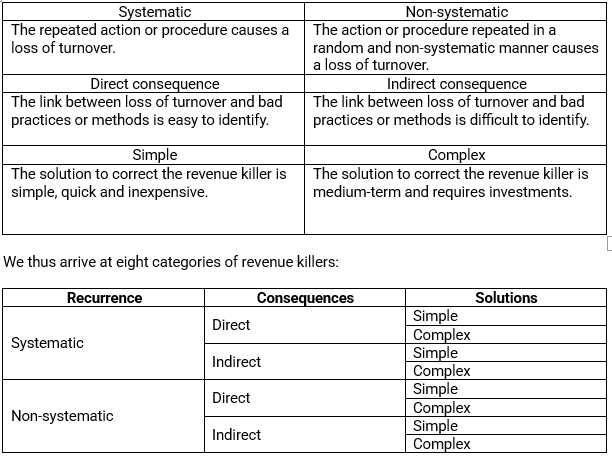

Exercise 1.2
1. Based on your knowledge of your company and its organization, what could be your potential revenue killer?
2. Can you place your revenue killers in each category?
3. Which revenue killers should be fixed first?
3. WHY IDENTIFY REVENUE KILLERS?
With over thirty years of growth strategy consulting in hundreds of companies of all sizes, all activities, and from different continents, our expertise is unparalleled. We have found that the main reason it is necessary to identify revenue killers is often the company’s lack of awareness of them.
Revenue killers, which do not correspond to any known data recorded in companies’ financial statements, are a significant threat. The lack of identification, measurement, or correction of these issues results in the loss of trillions of dollars of potential growth each year.
Revenue killers are often complex because they are multi-criteria. Many quantitative and qualitative elements must be evaluated simultaneously. They affect areas such as productivity, commercial practices, schedules, customer experience, and the company’s beliefs and certainties about its commercial organization.
Another compelling reason to identify revenue killers is the potential for cost-effective revenue recovery. In a time when all companies are striving for growth and cost optimization, the identification of revenue killers, often simple to implement, can be a significant source of revenue recovery at a lower cost. This practical benefit should inspire optimism about the value of our approach.
Finally, the last reason why it is necessary to identify revenue killers is that this brings everyone into agreement on priorities in terms of strategy, organization, resources, and commercial means. Very curiously, in many companies, when the financial director, IT, logistics or other functional department asks for money to invest in new projects or resources, only some managers will question and challenge the request. Conversely, when the Commercial Division does the same, all the decision-makers in the company, including the directors of the functional departments, proclaim themselves experts on how the commercial division should operate. Requests from the Commercial Division are often refused or postponed because they are considered less strategic.

Case Study – Optical Center
The Context:
As the tenth-largest optical group globally, Optical Center operates over 700 stores across 8 countries, selling and distributing a wide range of optical products.
Observing opticians’ practices in real sales situations has shown the following:
• Customer traffic is significant and uninterrupted from store opening to closing
• Opticians take an average of 50 to 60 minutes to sell a pair of glasses
• Stores lose customers at times when customer traffic is highest. The cause is the unavailability of opticians who are already busy with other customers
• It is not possible for reasons of profitability and store area to increase the number of opticians
The situation causes at least one $500 sale to be lost per day per optician. The average size of a store team is four opticians. Optical Center, therefore, lose $2,000 per day in turnover, or $600,000 annually.
The killer revenue and its solution:
The hypothesis was: How can we ensure that opticians save time and can sell in 30 to 40 minutes during periods when customer traffic is highest?
Opticians waste much time choosing eyeglass frames, which can last up to 20 minutes. The reason is that the optician chose a first frame to have the customer try on. In 50% of cases, the customer did not like it. Consequently, the customer could subsequently try on between 15 and 20 different frames.
The error is in the way of choosing the first frame. The optician chose the first frame to offer it to the customer. If the customer does not like the first frame, he no longer trusts the optician to select other frames and wants to try everything in the entire store.
We have changed that. The optician now asks the customer to choose the first frame. After this first choice, there are two solutions:
1. The customer likes this first frame and tries on 2 to 3 others to be sure of his decision
2. The customer does not like the first frame he chose, and he agrees to be advised by the optician, who will have him try on a maximum of 3 to 4 frames
The results:
The results of this new approach are promising. Optical Center saved twenty minutes per sale, enabling opticians to increase their sales from two in two hours to three during peak customer traffic. This simple yet effective change has corrected a significant loss of daily turnover that was previously unnoticed.
4. WHAT SKILLS ARE NEEDED TO IDENTIFY REVENUE KILLERS?
Since revenue killers are mainly methods, practices or procedures identified by observing commercial activity, it is not necessary to be a specialist audit consultant, a data analyst, or a financial manager. The person(s) responsible for identifying and analysing revenue killers must have the following skills or qualities:
Not be involved in commercial activity:
An external and impartial perspective is crucial in identifying revenue killers. A sales team member, for instance, may not have the necessary objectivity to spot these issues. Their familiarity with a process, developed over years of application, could lead them to overlook revenue killers that are costing the company millions.
Understand the organization of a company in its entirety.
The inspectors of the famous Michelin Guide, who award stars to the most prestigious restaurants in the world, are a real key to developing notoriety and filling reservations. They do not need to be professional cooks or catering technicians. They know a hotel or restaurant’s organization, operating, and production methods. They can evaluate the establishment in every detail, not from a professional point of view, but from the point of view of the customer experience in terms of welcome, service, flavours, creativity, atmosphere, and sense of perfection.
The individuals responsible for identifying revenue killers need not be sales professionals. However, they must possess a comprehensive understanding of the company’s operations and a global perspective. They should be able to see the implications of different functions or modes of organization. For instance, some revenue killers may stem from recruitment methods rather than sales methods.
Curiosity and attention to detail:
Curiosity and attention to detail are key in identifying revenue killers. Most of these issues are not easy to find and are often unique to the company or its sector of activity. A keen eye for detail is also essential, as a significant loss in turnover can sometimes be hidden in a seemingly insignificant sales habit. The Optical Center case is a prime example of this.
Spirit of analysis and synthesis:
Once the revenue killers have been collected, categories must be created and classified into these categories. It is necessary to prioritize these revenue killers according to several criteria and make assumptions about the loss of turnover generated without this being able to be called into question by the members of the company to whom the balance sheet will be presented.
5. HOW TO IDENTIFY REVENUE KILLERS?
The method for identifying revenue killers is empirical and mainly based on observing real-world practices. The table below explains the method’s five elements.
Key Points
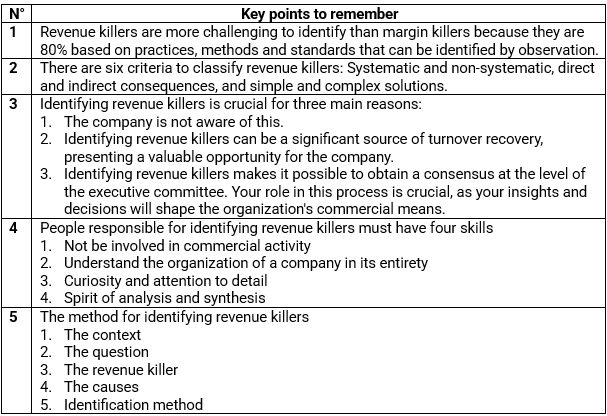

Course Manual 2: Client killers
Objectives
1. What is a customer killer?
2. Understand customer killers with examples.
3. Significance of the method for identifying customer killers in B2C?
4. Significance of the method for identifying customer killers in B2B?
1. WHAT IS A CUSTOMER KILLER?
Understanding what a customer killer is empowers us to make informed decisions. It’s crucial to distinguish two concepts: customer satisfaction and productivity and processes.
In terms of customer satisfaction, the company can gain or lose customers because, at some point in the customer’s purchasing journey, the company does not meet the customer’s expectations. Three main KPIs measure the adequacy of the service given to the customer regarding expectations: The customer satisfaction score (CSS), the customer effort score (CES), and the net promoter score (NPS). It is not a question here as part of our program of improving customer satisfaction, which is multi-causal and complex: quality of products, quality of service, personalization of service, clarity of communication, ease, and simplicity during the customer journey. Purchase, company image, quality/price ratio…
In addition, these KPIs measure the quality of service perceived by the customer but do not indicate the causes behind the dissatisfaction.
Since the emergence of the digital era, the customer has carried out 70% of their purchasing journey alone. He arrives at the last 30% of his trip when he meets a salesperson or salesperson: The closing. The objective is to identify in this previous 30 % the reasons why, in the commercial approach, the customer did not purchase even though their purchasing intentions were strong. It involves identifying what prevents the total turnover from being achieved, not because the customer is unsatisfied but because the company needs to identify unsuitable internal practices and processes at the last stage of the customer purchasing journey.
2. UNDERSTANDING CUSTOMER KILLERS WITH EXAMPLES
Example N°1: Commercial demonstrations that don’t sell
B2B sales demonstrations all aim to explain a product or service’s benefits and operating methods to a prospect actively searching for solutions. The prospect makes an online appointment, generally thirty minutes, with a sales representative to conduct the demonstration.
The first step of the demonstration should be used to get the prospect talking about himself, his company, his challenges, and the reasons that led him to look for new products or services. In the second step, the salesperson should only explain clearly and briefly the most important aspects of the product or service that interest the prospect. The end of the demonstration should finally be devoted to getting the customer to talk about how he envisages collaboration with his future supplier and what more he expects compared to these previous experiences. Finally, the salesperson should finish by asking the customer what he thought of the demonstration and what he thinks the chances of signing might be because if the customer does not have a 70% desire to sign after the demonstration, he will never sign.
Commercial demonstrations should be more prolonged. They are almost all calibrated to formats of 30 to 45 minutes because they are solely intended to explain the product or service. In our desire to automate, industrialize, and always go faster, we completely ignore what motivates the customer to sign: that he talks about himself first and that we tell him about the solution after. Automation and personalization are consistent.
Most demonstrations are done remotely via Zoom, Skype, or Teams. Salespeople are sometimes late, and not all look impeccable. Most are unaware of the halo effect, a cognitive bias that is our tendency to attribute qualities or faults to a person we do not know. It is based solely on their appearance and behaviour in all circumstances—first seconds of meeting.
Salespeople speak too fast. They present the products and services at full speed without asking the customer questions to check what they have understood or agree with them. They overwhelm the client with too much information, causing their working memory to saturate after just a few minutes of demonstration. The demonstrations follow one another throughout the salesperson’s day, and all follow the same agenda without any adaptation. At any time, the company questions what the salesperson is doing or wonders if the transformation rate is correct?
Example N°2: Give me a quote, and I will think about it
A network of kitchen design stores notes that the conversion rate between the number of quotes made and those confirmed is low. 70% of quotes are made during the weekend, the time of the week when customer traffic is highest. Potential customers arrive in-store, explain their needs to an advisor who builds a kitchen project with them and establishes a quote. Appointments last, on average, two hours, so the advisor cannot deal with other clients waiting and leaving. The advisor spends his time establishing quotes, which, for the most part, will not be confirmed and misses sales.
After analysing the situation, the advisors prepare a kitchen project before qualifying the clients. They invest more than two hours without identifying what stage of their purchasing journey the customer is at. Some customers are at the beginning and come to the store to get information on kitchen styles and types of equipment, while other customers are at the end of the process. They know precisely what they want and come to confirm their project. The solution implemented was to train all advisors to qualify each customer to spend 10 to 15 minutes maximum with customers at the start of the purchasing journey and to invest two hours with customers with completed projects.

Exercise 2.1
1. Based on the definition of customer killers and the examples above, who might be the leading customer killers in your business?
2. Do these customer killers directly or indirectly affect the loss of turnover?
3. Are the solutions to correct these killer customers simple or complex?
3. SIGNIFICANCE OF THE METHOD FOR IDENTIFYING CUSTOMER KILLERS IN B2C
Our method for identifying killer customers is specifically tailored for the Retail sector, with a deliberate exclusion of digital sales, which operate under different paradigms.
Retail brand stores worldwide are generally open six days a week from 9 a.m. to 7 p.m. A store is open on average sixty hours per week. Often, traffic is not linear. There are peaks of activity that correspond to weekends, lunchtimes, or the end of the customers’ working day, such that stores achieve around 70% of their turnover during 20 hours per week and the other 30% for the remaining 40 hours. Ideally, stores should have two different sales methods:
• Mode N°1: Sell quickly and well during high-traffic hours
• Mode N°2: Achieve high sales at low-traffic hours
Identify customer killers during high-traffic hours:
The context:
Customers all come to the store at the same time for two reasons:
• The first reason is the store’s proximity to the workplace. The customer works not far from the store and takes advantage of his lunch break or the end of his working day to make his purchases. He doesn’t have a lot of time and knows what he wants. He can buy self-service, and if he needs advice from a salesperson, the latter must be immediately available and advise quickly and well.
• The second reason is to group several purchases at the same time. When the customer is on the weekend or taking a day off, he draws up his shopping list, takes his car to a shopping centre or commercial area, and visits different shops.
The question:
• Does the store’s current sales method make it possible to sell quickly and well and achieve all the turnover when customer traffic is highest?
The customer killer:
• Some customers to purchase leave without purchasing
Possible causes:
• Salespeople do not see customers arriving in the store
• Salespeople are not available when the customer needs them
• Salespeople are not able to sell quickly and well at times when customer traffic is high


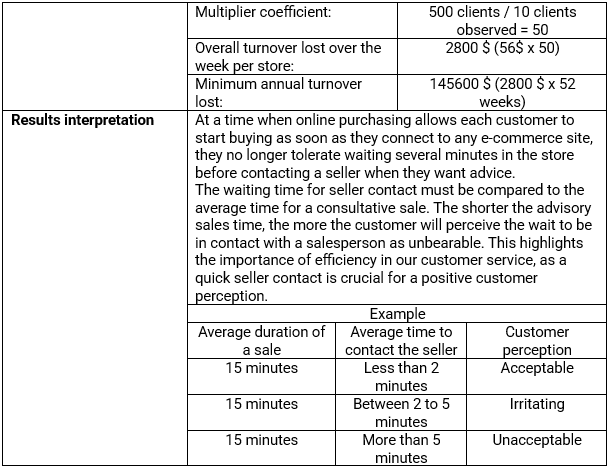
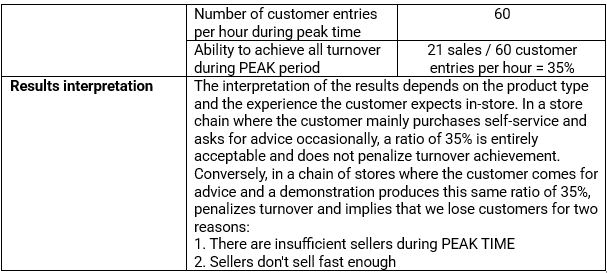
Identify customer killers during low-traffic hours:
The context:
• Customers who visit the store during off-peak hours, avoiding the crowds, are seeking personalized attention from the sales team. They arrive with a clear intention to make a purchase, valuing the purchasing experience above all. The sales team plays a crucial role in providing this superior in-store experience, which can lead to additional purchases or consideration of products they might not have otherwise. It’s worth noting that stores often achieve their highest sales per customer during these quiet periods, underscoring the importance of the purchasing experience.
The question:
• Does the quality of the customer experience make it possible to achieve the best sales per customer at times when traffic is low?
The customer killer:
• Customers with high purchasing power do not buy or only buy what they asked for
Possible causes:
• Less experienced sellers are scheduled during low-traffic hours
• Salespeople are busy with other tasks (storage, re-shelving, labelling, etc.)
• The purchasing experience is banal and without any difference compared to the competition
• Sellers do not adjust their selling time to low-traffic hours and do not spend more time than during high-traffic hours

Case Study – L’Oréal Luxe
The context :
L’Oréal Luxe is a division of the L’Oréal group, one of the leading players in the global beauty market with a turnover of 44 billion dollars. L’Oréal Luxe has brands such as Lancôme Paris, Biotherm, Shu Uemura, Kiehl’s…
The revenue killer and its solution:
The brand noted a remarkable difference in results at the level of a KPI between its brands in one of its European subsidiaries. While the shopping cart for all brands was 2.2, the item basket for the Kiehl’s brand was an impressive 5. This success story of Kiehl’s, selling five items per sale while all the others had a performance more than two times lower, is truly inspiring.
After analysis, L’Oréal Luxe realized that Kiehl’s had implemented a sales standard which had become systematic at the sales team level. This standard involves advising and offering products to the customer until they say: STOP.
Offering as many products as possible to the same customer might be counterproductive, and the latter could see it as a forced sale. In practice, Kiehl’s subsidiary started from the principle that a customer who takes the time to go to the store instead of buying online comes to purchase the product he knows but is also open to trying others. Products he wouldn’t have thought of.
The results:
This approach not only increased the number of items sold per sale but also enhanced customer engagement. While other L’Oréal Luxe brands were content to respond to customer requests, Kiehl’s sales teams were prepared and trained to dare to offer customers products they would not have imagined.
4. SIGNIFICANCE OF THE METHOD FOR IDENTIFYING CUSTOMER KILLERS IN B2B
Identifying customer killers in B2B is done in several ways:
• Collecting qualitative information by interviewing the company’s customers
• Study of all commercial documents sent to customers
• Observation of salespeople’s practices in an actual sales situation
The context:
• Remember, B2B customers are the best source for identifying B2B customer killers. They have their own sales teams and a wealth of experience, which is 10 to 20 times greater than that of your company’s salespeople. This experience is enriched every day by ten salespeople who prospect them to try to work with them. Their insights will guide us to success.
The question:
• Is the quality of your commercial approach aligned with what your customers expect and superior to your competitors?
The customer killer:
• The average conversion rate of your commercial offers is less than 30% (to be adapted according to your market and your sales cycle)
Possible causes:
• Prospect qualification is incomplete
• The process of knowing the prospected company is insufficient
• Salespeople do not know how to get buyers or decision-makers to talk
• Salespeople have certainties inherited from their past successes
• Salespeople do not know how to respond to opportunities expressed by prospects during the need’s identification phase
• Salespeople use ready-made marketing arguments
• Salespeople try to influence or persuade the customer instead of building the purchase with them
• Sales practices are inferior in quality to those of your competitors

Exercise 2.2
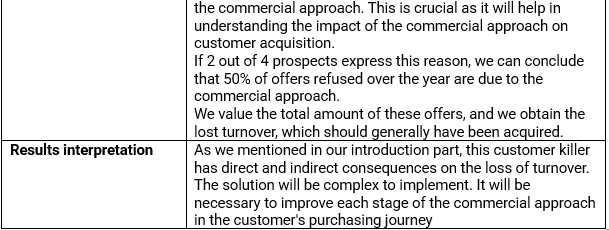
DONT FORGET
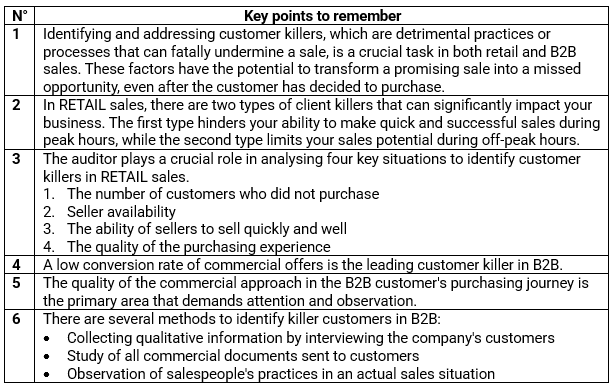

Course Manual 3: Distributor killers
Objectives
1. What is a distributor killer?
2. Understand distributor killers with examples.
3. Significance of the method for identifying distributor killers
1. WHAT IS A DISTRIBUTOR KILLER?
Distributor killers are strongly linked to the upheavals in recent years in this sales channel. Whether your distributors are exclusive or non-exclusive, having a distribution network means completely delegating the sale of your products to a third party. A few years ago, this solution offered many advantages:
• Be present in different markets and regions without investing in local points of sale or offices.
• Benefit from the distributor’s experience in developing sales in its markets and regions
• Reduce storage, logistics and transport costs
• Save time by focusing on your core business by delegating sales to the distributor
Managing a network of distributors used to be a straightforward process; it involved:
1. Recruit distributors
2. Offer products that meet customer expectations
3. Pay the distributor a satisfactory remuneration
4. Have salespeople who frequently visit the distributor to strengthen the relationship and remind them to sell your products rather than those of competitors
5. Make promotions to help the distributor reduce their stocks or order more
6. Motivate distributors by organizing events to reward the best, like the cinema Oscars.
However, distributors are now grappling with persistent challenges that are significantly impacting your sales.
• There is a labour shortage. Distributors encounter difficulties recruiting and retaining their technical or sales personnel teams.
• Distributors face aggressive competition, mainly from ‘pure players on the WEB-online retailers who operate solely on the internet-who offer products of equivalent quality at prices of up to -40 % or -50 %.
• Customers are becoming increasingly discerning, often checking the distributor’s Google score and customer reviews before making a purchase.
• Considering sustainable development and CSR (corporate social responsibility) has become an obligation.
Today’s distributor is overwhelmed by everyday life. He manages emergencies at the level of his teams, customers, or suppliers. Its margins are Increasingly reduced. He no longer has time to anticipate the constant developments in his own profession. In such a context, anything that the company does not do to help the distributor overcome its own operational constraints and remain efficient generates direct or indirect losses in turnover.
2. UNDERSTAND DISTRIBUTOR KILLERS WITH EXAMPLES
Example N°1: Godless and Lawless sales
One of the world’s largest energy distribution groups subcontracts the sale of its electricity and gas contracts to individual customers to electrical equipment distributors. Distributor salespeople attack entire geographic areas by selling door-to-door. To quickly gain market share, the energy group gives a very high commission to distributors for each contract sold. The company achieved more than 15% market share two years after implementing this distribution method. However, it also faced many problems. Its direct competitors are suing it for unfair competition. It receives numerous complaints from its new customers who are dissatisfied with how they were sold electricity and gas contracts. They talk about forced sales, a practice where distributors use aggressive tactics or misleading information to make a sale. This not only damages the company’s reputation but also leads to legal issues. Comments on Google and the company’s online reputation are in free fall. An internal audit and observing how distributors sell in the field confirm that they engage in forced selling and use any argument to sell. Following the observation, the company separated itself from distributors with dishonest practices. It has established rigorous processes to monitor and control how the remaining distributors sell. Account managers travel regularly to distributors. They check sales methods, coach salespeople and managers, and help the distributor achieve as many sales as possible within an ethical and legal framework.
Example N°2: A contractual commitment that commits you to nothing
An automobile parts distribution company negotiates each year with its garage customers preferential discounts on simple products with high sales volume, such as tyres or engine oil. The customer benefits from discounts ranging from 5% to 15% in return for a purchase volume. The agreement is formalized by a written contract signed by both parties. At the end of each year, the company notes that barely 60% of distributors respect their commitment. The main consequence is a loss of margin. The company sells products at reduced prices in return for volume targets that still need to be met. After analysis and observation, the following distributor killers were identified:
1. Garages are overwhelmed by their daily activity; they rarely take regular stock of their order volume concerning these contracts
2. The distribution company’s salespeople, who visit the garages at least twice a month, almost never update the garage on the volume of orders placed for products that fall within the scope of the contractual agreement. This point is only made at the end of the year, in November and December, when it is too late.
3. The Sales Department does not apply contractual penalties in the event of non-achievement of purchasing volumes for fear that garage customers will leave to compete.
Example N°3: To sell or not to sell is the question.
The business world could be more original. I no longer remember who determined one day that to attract a new prospect, it was necessary to prepare a pitch with a brief history of the company and its mission, the unique selling proposition, the quality, and benefits of the products and finally, figures and data that proves that the products are ideally suited to the market. This way of presenting your company is perfectly correct, but let’s imagine that the prospected distributor wants to hear something else because everyone is telling the same story.
When a distributor has never worked with a company, the only product to sell is the commercial. The salesperson and he alone represent his company and make the distributor want to join your network. The key is not to explain the unique selling proposition of your company but that of each of your salespeople because selling to a distribution network is 70% interpersonal relationship and only 30% sales. This example highlights the need to tailor sales strategies to individual distributors, empowering the sales team to build strong interpersonal relationships.
3. SIGNIFICANCE OF THE METHOD FOR IDENTIFYING DISTRIBUTOR KILLERS
Identify distributor killers when prospecting for new distributors
The context:
• The only way to gain market share in mature markets with aggressive competition is to take distributors from the competition. Salespeople are used to making 3 to 4 prospecting visits to the same distributor. They wrongly interpret that he will never buy if the distributor has not decided to buy after 3 or 4 trips. This error of judgment slows down the acquisition of new distributors and hurts market shares.
• A distributor who does not yet work with a company already works with some of its competitors and has often done so for many years. Regardless of the quality of salespeople’s arguments, distributors prefer to keep the same. They will prefer to continue working with competitors out of habit. The distributor’s time is not the salesperson’s time. There will be a time in the year when competitors will make a mistake, fail to deliver on time or fail to provide a solution. It is at this precise moment when the distributor will be open to discussing a collaboration with the sales representative who will be present and will continue to visit him throughout the year instead of running out of steam after the third or fourth visit.
The question:
• Do your salespeople have all the skills and methods to acquire new distributors according to the objectives defined by your growth strategy?
The distributor killer:
• Salespeople do not achieve their prospecting objectives in terms of new distributors
Possible causes:
• Salespeople are not motivated to prospect for new distributors; they prefer to develop sales with their existing customers
• Salespeople lack prospecting skills
• Remember, persistence in prospecting is not just a strategy, it’s a mindset. The number of visits made to each potential new distributor should be sufficient, demonstrating a commitment to the process. This commitment is what will set your team apart and lead to successful acquisitions.
• The company’s role is pivotal. It is your responsibility to define and implement an efficient process for prospecting and acquiring new distributors. This not only provides a sense of reassurance but also instils confidence in the strategy among your sales team.
![]()
Identify distributor killers in terms of your salespeople’s business coaching skills
The context:
• The role of distribution network salespeople has changed. He moved from order taker to business coach to help the distributor achieve more sales.
The question:
• Do your salespeople have all the skills and methods to help the distributor analyze its results, identify the causes of performance or underperformance, and implement specific commercial actions that generate turnover?
The distributor killer:
• Salespeople do not achieve their sales goals
Possible causes:
• Salespeople try to sell their products without asking the question of how the distributor will sell them
• The market context of the distributor has changed; numerous competitors attack it and no longer have the time to react
• Your company’s vision regarding the sales approach to distributors is obsolete and does not respond to the support that must be provided to distributors
• Salespeople are left to their own devices; they have not been trained and coached to become business coaches for your distributors
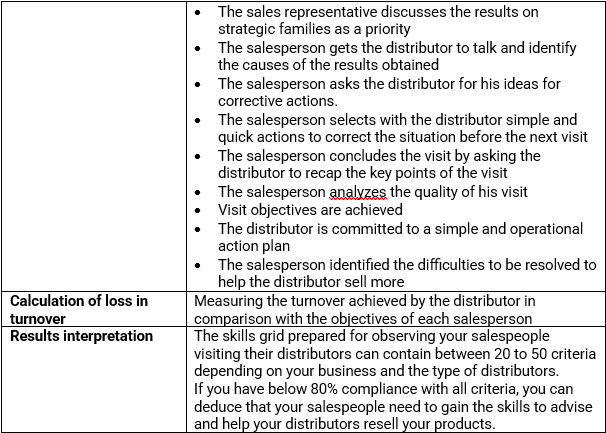

Exercise 3.1
1. Preparing for the visit
2. Arrival at the distributor and observation of his activity
3. Presentation of reciprocal visit objectives
4. Discussion with the distributor to see what has evolved or changed since the last visit
5. Presentation of results
6. Identifying the causes of the results
7. Identification of opportunities to sell more in the responses made by the distributor
8. Choosing an action plan
9. The conclusion of the visit
10. Post-visit analysis

Case Study – Parts Holding Europe
The context:
Parts Holding Europe (PHE) is a leader in the independent distribution of spare parts for light and heavy vehicles in Western Europe, and it is present in France, Belgium, the Netherlands, Luxembourg, Italy, and Spain. PHE operates on the BtoB market to distribute spare parts to repair professionals via Autodis and on the BtoC market for the online distribution of spare parts via DAPH (Digital Auto Parts Holding) and its subsidiary, Oscaro.com.
PHE is a group that integrates purchasing, logistics, and data management functions, allowing it to efficiently distribute its products through different sales channels and brands and thus address all automotive after-sales customers.
The revenue killer and its solution:
PHE adopts a premium positioning in terms of prices and services offered to its garage customers, whether in terms of product availability, speed and frequency of delivery, ease of ordering or returning products, and support services such as technical training. Or products and commercial monitoring.
PHE’s pure-player competitors offer auto parts of equal quality at prices 30 to 40% lower. Salespeople feel powerless in the face of their distributors’ price objections.
After accompanying salespeople on a sales visit, it became clear that they play a crucial role in explaining the value of PHE compared to pure-player competitors who focus solely on price.
The solution consisted of promoting all the PHE services offered free of charge to its distributors (each delivery costs, for example, $15), making an annual calculation of all of the services provided to show and prove to the distributor that:
1. He cannot do his job well without the services provided by PHE
2. When we value all the free services, the price of PHE coins is the same as that of pure players who do not offer any services.
The results:
By equipping the sales force with the necessary techniques to articulate the value of the services and defend the prices, PHE has not only achieved its turnover objectives but also underscored the pivotal role of the salespeople in its success.
DONT FORGET

Course Manual 4: Productivity killers
Objectives
1. What is the definition of a productivity killer?
2. Understand productivity killers with examples.
3. Significance of the method to identify productivity killers
1. WHAT IS A PRODUCTIVITY KILLER?
What sets apart a salesperson who consistently meets and exceeds their goals from one who struggles to keep up? The key factor that allows us to compare these two individuals is not their personality, initial training, or experience: it’s time. Both salespeople start their work week on Monday morning and end on Friday evening at the same time. They invest the same hours at work prospecting, making commercial offers, negotiating, and signing new contracts. The difference lies in how they use their time. The true wealth of a sales team is not just the turnover, but how time is managed, rationalized, and optimized to produce this turnover.
It’s intriguing to see the multitude of KPIs used to measure turnover: Transformation rate, average turnover per customer, customer lifetime value, turnover achieved in relation to budgetary turnover, and turnover per salesperson. However, it’s rare to find organizations that have robust systems in place to measure what truly produces revenue: the time invested to produce it. The need for such systems is not just a luxury, but a necessity for any sales team striving for optimal productivity.
A salesperson can be likened to a financial product. The company invests money, which is reflected in the salesperson’s salary, potential company car, travel expenses, and additional costs (mobile phone, computer, etc.). The salesperson’s time is the currency spent to develop turnover. Just like a trader, the company anticipates a return on investment as swiftly as possible. The crux of the matter here is not just the amount invested, but the time it will take to recoup this investment. This comparison underscores the significant role a salesperson plays in the company’s financial health.
A productivity killer is defined very simply. How many hours are spent unnecessarily by each of your salespeople in developing your sales?
2. UNDERSTAND PRODUCTIVITY KILLERS WITH EXAMPLES
Example N°1: An overpriced sales visit
A sales team has worked the same way for decades. Each salesperson has around 100 clients to develop and spread across the same geographical region. The size of each region is approximately 300 kilometres from north to south and east to west. The primary responsibility of salespeople is to visit their distributors to develop sales of their products. Each visit lasts, on average, 3 hours, so a salesperson can make up to two visits daily. Adding up the cost of his salary, his car, and travel expenses, a salesperson costs the company $1,000 per day. At the rate of two customer visits per day, one visit costs $500. The questions to ask yourself are:
1. Is the margin the salesperson generates at the end of each visit sufficient to absorb the cost?
2. Is a three-hour visit essential?
3. What can be optimized?
After observing salespeople visiting distributors, we note that:
• Salespeople spend on average almost 2 hours training the distributor’s salespeople in product knowledge. This training is useless due to the high turnover rate of distributors’ sales teams. Product training must be repeated 3 to 4 times per year.
• Salespeople spend approximately 45 to 60 minutes with the distributor not to advise them on developing their sales but to argue why more products should be sold.
After analyzing productivity, the following actions were implemented:
1. Salespeople no longer do product training. An online training module is offered to distributor salespeople, saving two hours during the sales visit, and responding to the turnover requirement for distributor salespeople.
2. A new visit process has been implemented, with visits lasting a maximum of 60 minutes and focused on advice and action plans to help each distributor resell the products.
The benefits were as follows:
• Salespeople saved time; they went from two to four visits per day
• Distributors have saved time and see real added value in the new sales call process
Example N°2: Visit preparation that prepares for chaos
The clients of a sales team are supermarkets and hypermarkets. Before each visit, these salespeople must prepare figures for the results to date in comparison with the budget and the period of the previous year. Salespeople have all the data available, but it is in several different company databases. Salespeople are forced to manually extract figures from three different databases and then “cobble together” a relevant and customer-friendly presentation of the results on an EXCEL grid. Salespeople regularly make mistakes when manually copying data, and it takes them an average of 45 minutes to prepare for a customer visit that lasts a maximum of 60 minutes.

Exercise 4.1
3. SIGNIFICANCE OF THE METHOD TO IDENTIFY PRODUCTIVITY KILLERS
Identifying productivity killers is a simple task. It consists of observing salespeople in a work situation, listing the tasks carried out, evaluating the time spent to complete each task, and then asking whether the task can be done differently, or the time invested can be optimized. When you are not a specialist in productivity studies of an organization, you especially need to know what to observe and what potentially contributes the most to low productivity.
Domain N°1: Multitasking
Many salespeople boast of being able to multitask. They are even encouraged to do so by their sales department. It is not uncommon to attend meetings where most participants respond and send text messages, leave the meeting for a few minutes to answer an “urgent” call or discuss a topic other than that of the meeting. Everyone feels like they are “more productive” and optimizing their time.
A cognitive psychology professional or neuroscientist will explain that multitasking is a myth and that the brain does not have the capacity to multitask biologically. When we believe we are multitasking, we move quickly from one task to another.
We are not more efficient when we try to chain several tasks together. The brain that has been focused on one task suddenly has to change, and this requires much more effort and energy than necessary. Salespeople accustomed to “multitasking” work more slowly, make more mistakes, and tire more quickly than those who focus on one task at a time for a given period.
Domain N°2: Sales time management
For a salesperson to get into the habit of being economical with their time, time management must be an integral part of the regular meetings with the sales manager. In regular one-on-ones between the salesperson and their line manager, discussing different subjects such as commercial results, current proposals, customers, and one-off problems is customary. We rarely address the aspect of time the salesperson invests in their weekly or monthly activity about their results.
Domain N°3: Lack of process
One of the leading causes of wasted time in achieving results is the need for more processes. Salespeople spend too much time doing things themselves that could be standardized or industrialized once and for all. For instance, the creation of commercial documents, customer reports, sales interview guides, IT tools, or results reporting could be streamlined to save time and resources.
Domain N°4: The quantity and complexity of processes
The opposite of lack of process is process complexity. Year after year, the company has implemented an impressive number of processes whose initial objective was to simplify the work of salespeople. Consequently, salespeople spend almost more time doing commercial administration than caring for customers and sales development.
Domain N°5: Internal meetings
In the era of participatory and caring management, we often feel that the more participants we involve in a meeting, the more we guarantee their commitment and the effectiveness of implementing the actions decided during the meeting. However, it’s important to strike a balance. Too many participants can lead to inefficiency and reduced productivity. We need to consider the value each participant brings to the meeting.
We often see the same phenomena in most internal meetings, whether commercial or otherwise. Only 1 to 2 participants speak and express themselves 80% of the meeting time. Half the participants must learn why they were invited and did not participate.
If all companies worldwide saw internal meetings primarily from a financial perspective, we are convinced that their numbers would be reduced, and their quality would be improved. By understanding the cost of each meeting, we can make more informed decisions about when and how to hold them. This can lead to significant cost savings and improved productivity.
• We suggest you do the following calculation:
• A two-hour meeting with 8 participants
• Each participant costs the company, on average, $6,000 per month or $40 per hour
• The meeting will, therefore, cost at least 640 dollars.
The questions to ask yourself at the end of this meeting are as follows:
• Was this meeting necessary?
• Could the number of participants be smaller?
• Does the added value of this meeting justify spending $640 in margin?
Domain N°6: Post-sales call novels
One potential solution to this issue is to implement a more structured reporting system that encourages salespeople to provide concise, yet comprehensive, information. All salespeople worldwide must prepare a famous visit report at the end of a customer visit. It is often white or black. It is not uncommon to see sales teams that do not draw up any report at the end of a visit and others who must write a veritable novel with so much detailed information that no one at the level of sales management will have time to read, analyze, learn from, and give feedback to salespeople on the valuable information provided.
Domain N°7: The cannibalization of diaries
Sharing calendars using Outlook email or any other tool allows anyone in your organization to schedule an appointment or meeting on a salesperson’s calendar. This “wild” appointment scheduling cannibalizes schedules and kills commercial productivity.
Domain N°8: Zero organization of daily or weekly activity
It is necessary to identify whether the entire sales team works in a reactive or anticipatory manner. Working reactively means that salespeople organize their work week very well. Customers, emergencies, and unforeseen events dictate their agendas. Working in an anticipatory manner means that each week, the salesperson plans his activities for the coming week. Recurring and predictable activities take up 70% of the week; the salesperson spends 30% of his free time each day responding to emergencies or unforeseen situations. The salesperson plans his activity only to do the same strategic task simultaneously and for 90 and 120 minutes to concentrate, avoid errors and obtain maximum results. Invested. The sales representative regularly meets with his sales manager to analyze the return on time invested for each action.
Domain N°9: The Skills Gap
It’s no secret that since the 2000s, there have never been so many changes in business practices, whether the cause is technological, social, or environmental. The skills needed to succeed are evolving rapidly, and only some companies have the time or sufficient resources to address the skills gap. A recent study, however, shows that companies that realize that training and skills development is strategic, display 11% higher profitability than those that have not yet done anything in the area (Source: Gallup). To remain pragmatic, when it comes to identifying productivity killers, we need to ask ourselves the following questions:
When was the last training your salespeople attended?
• Do the training content help salespeople fill a skills gap in market needs?
• Are salespeople accompanied on sales visits to help them improve their skills in an actual situation?
• How often are they accompanied? By whom?
• How do we monitor and measure the development of skills?
• Can we translate this evolution of skills into increased turnover and the number of customers?
Domain N°10: Motivation of the sales team
Regardless of the efficiency and skills of your salespeople, the sales job is one of the most demoralizing jobs in the world because a salesperson faces refusals 70% of the time. No other profession experiences this situation. For example, if you run a restaurant tomorrow, 100% of the customers who enter your establishment will say YES and have lunch or dinner with you. As a restaurateur, you have other operational problems to manage, but not that of facing 70% refusals at entry.
Maintaining the motivation of your sales team throughout the year is an essential factor influencing sales productivity. Internal auditors who will be responsible for identifying productivity killers in the motivation aspect of the sales team will need to ask themselves the following questions in particular:
• Are there regular challenges that reward the best performances?
• Can salespeople progress within the company?
• Are everyone’s objectives clear and understood?
• Do salespeople receive regular feedback on their activity?
• Do we consider the differences of each salesperson to adapt and personalize the motivation system? (What motivates salesperson A is different from what motivates salesperson B)
• Do we consider the opinions of salespeople to build the motivation system?
![]()

Exercise 4.2

Case Study – Sephora
The context:
Sephora is a French multinational retailer of personal care and beauty products. It offers nearly 340 brands alongside its own private label, the Sephora Collection. Its product range includes cosmetics, skincare, fragrance, nail colour, beauty tools, body lotions, and hair care items. Sephora is owned by the luxury conglomerate LVMH.
The revenue killer and its solution:
SEPHORA, like many retailers, initially operated under the belief that beauty advisors should be multitasking. This meant they were responsible for a wide range of tasks, from restocking products to providing customer advice. However, this approach was found to be a revenue killer, leading to a loss of performance and customers. As a result, a large-scale project was initiated to address this issue within the stores.
The results showed, at the time, a loss of performance and customers coming to buy linked to this multitasking vision of the advisor’s role. A large-scale project has been launched to study this problem within stores.
The project led to the creation of two distinct teams within the stores. The first team, known as the ‘quality team’, was tasked with all pre-sale’s activities, ensuring products were always available for purchase and each department was ready for sales. The second team was comprised of sales advisors, whose sole focus was on customer interaction, from welcoming and advising to selling and retaining.
The results:
By implementing this new team structure and eliminating the multitasking roles of advisors, SEPHORA not only addressed the revenue loss but also exceeded its performance targets. This success story demonstrates the effectiveness of the solution and the potential for similar improvements in other retail settings.
DONT FORGET

Course Manual 5: Recruitment killers
Objectives
1. What is the definition of a recruitment killer?
2. Understand recruitment killers with examples.
3. Significance of the method to identify recruitment killers
1. WHAT IS A RECRUITMENT KILLER?
We deliberately address the themes of recruiting and onboarding your salespeople in our program because sales teams are different teams compared to all other departments in a company for two reasons:
1. They are on the front line and have the responsibility to generate turnover
2. The sales profession is demanding. A salesperson must live with the idea of hearing and accepting the word “NO” daily.
Recruiting salespeople is not a task to be taken lightly. Unlike recruiting for other roles like a management controller or a production manager, the methods used for salespeople must be different. This is because the mission they are entrusted with is not only different but also one of the most challenging in your company.
Irrespective of their professional background, what do we expect from a salesperson to ensure their success? We have identified seven qualities that are not just important, but essential for all sales teams: an open mind, flexibility, speed, opportunism, rigorousness, and friendliness.
Logically, your sales team’s recruitment process must comply with these seven qualities. It would help if you had an open mind because often, the best candidate for you will not necessarily be the one with ten years of experience in your sector but perhaps the one who will have none. Your recruitment process must be flexible and adapt to your current and future market. Is a job profile written more than 12 months ago still relevant? You will need to be able to recruit quickly because good candidates have many opportunities. If you are recruiting, it is because you need more resources. Every day, you lose turnover with one or more salespeople who miss you. You must have an opportunistic vision, no matter if you doubt that this or that candidate will only stay in your company for up to two to three years if he is one of your best salespeople for the entire time, he will be working with you. You must be rigorous in your decision-making process and in the methods used to evaluate the qualities of candidates. You will need to be friendly because the basis of any business is empathy with your customers, suppliers, and employees.
Recruitment killers encompass all beliefs, methods, tools, and tests that do not align with or contradict these seven essential qualities. They can significantly hinder the recruitment process and should be avoided at all costs.
2. UNDERSTAND RECRUITMENT KILLER WITH AN EXAMPLE
Example N°1: The desperate manager
A RETAIL store chain delegates the recruitment of future salespeople to its store managers. This decision is logical and realistic for two reasons:
1. The chain has hundreds of stores nationwide; recruitment must be done locally.
2. The managers who will work every day with future salespeople are the ones who have the best vision to determine the needs of their stores.
Network management notes a high turnover rate within the sales teams and a high resignation rate of salespeople within six months of hiring. An analysis of the causes reveals that almost no store managers have been trained to conduct recruitment interviews. They need to learn to ask questions and dig into the answers, talking 30% of the time and letting the candidates express themselves. They do not have any precise interview guide. A key tool that can help with this is a standardized interview guide. This guide ensures that the same topics are covered in each interview, promoting fairness and consistency. Most store managers need more salespeople and prefer to recruit any candidate rather than wait to find candidates who will better meet the position profile. There is no assessment or practical test to verify candidates’ ability to work and sell in an organized and rapid manner in stores that are subject to significant customer flows. The direct cost of this unsuitable recruitment process was valued as follows:
3. SIGNIFICANCE OF THE METHOD FOR IDENTIFYING RECRUITMENT KILLERS
Below are the areas of investigation to identify your recruitment killers. Some areas will allow you to accurately assess the cost of inappropriate recruitment practices, while others with an indirect link will not allow you to translate this into financial loss. Identifying these recruitment killers is crucial as they can significantly impact your recruitment process.
Domain N°1: Your company is hermaphrodite
Only those who know your business and already have many years of experience in your sector of activity can succeed and be operational very quickly. However, the disadvantages far outweigh the advantages. Your future salespeople need more ideas. They will undoubtedly have the skills you want, but they will not have those you lack when initiating a change or adopting a new commercial strategy is necessary. Most of your prospects will not see any difference between your salespeople and those of your competitors because, after a few years of this type of practice, everyone will have worked with all the players in the market. It is not because you recruit a salesperson who comes from your sector of activity that he will be operational more quickly. Your competitors probably have different visions and cultures; you have yet to guarantee that your new salespeople will soon adapt to your vision and corporate culture. Salespeople from your sector of activity will have many certainties and show much more resistance to change than candidates from other sectors. This underscores the need for adaptability in your recruitment process.
Domain N°2: Zero KPIs to measure the performance of your recruitment
Just as salespeople have qualitative and quantitative objectives to achieve, you, as the key decision-makers, must set performance objectives regarding recruiting your sales force. The number of KPIs to measure must be adapted to your activity and the number of salespeople you recruit each year:
• Time to hire: The average number of days between the moment you publish your recruitment advertisement and the moment the position is filled
• Cost to hire: The total cost of the recruitment process (advertising, sourcing, recruiter salaries) divided by the number of salespeople recruited annually
• Retention rate: The ratio between the number of new salespeople who leave your company and those who stay during the first year of employment
• Hiring manager satisfaction: The satisfaction rate of your sales managers regarding the quality of the candidates recruited
• Candidate rejection reason: The main reasons why candidates perceived as good candidates refuse the job or leave the recruitment process
• Cost of resignation: all costs (recruitment, training, salaries) linked to the resignation of a salesperson in the first year of taking up a position
Domain N°3: A rigid and immovable recruitment process
Your recruitment process was defined once and for all several years ago by your Human Resources department and no one questions it. Your methods are proven but no longer correspond to an economic situation of lasting crises where living with change and imbalance are the paradigms.
Your job descriptions have not been updated for long and no longer meet current needs. You only use one interview method instead of having multiple methods tailored to the situation or type of candidate. Your hiring criteria are not flexible; you want to fit your salespeople into your criteria instead of bringing your criteria into the market of available salespeople. Your recruitment involves too many internal contacts, implying a complex and time-consuming decision-making process. The dates and slots for meetings with future candidates are adapted to your organization rather than to the availability and possibilities of the candidates. In conclusion, your process corresponds only to your vision rather than to that of your future salespeople and your market’s current and future challenges.
Domain N°4: Personality tests without any scientific basis
One of the fashionable words in recruitment for several years has been “soft skills,” which can be summarized as certain personality traits essential for success at the commercial level, such as curiosity, optimism, the ability to solve problems, and others.
Therefore, “Soft skills” result from a person’s behaviour. Many personality tests exist on the market to “assess these soft skills.” The real problem is that most of these tests or methods have no scientific basis and do not come from any rigorous cognitive psychology research.
These tests are sold and used because companies want to move quickly and lack critical thinking. The DISC method, for example, claims to evaluate our personality traits and classify humanity into four categories (Dominance, Influence, Steadiness, and Conscientiousness) but is not based on any research or scientific proof. Using this method is unethical and as reliable as if tomorrow you recruited an astrologer to predict which of your future salespeople will gain the most clients.
Domain N°5: A vision of recruiting your salespeople based on myths.
Are you struggling to find the “right” salespeople, or do you feel like today’s sales force is a far cry from the salespeople of yesterday? It’s possible that your company’s vision of salespeople is based on some common myths.
Myth N°1: A salesperson must be charismatic
This myth is based on the belief that only extroverted, seductive people who know how to tell great stories make good salespeople. The sales profession no longer relies solely on oral communication and the power of influence. You must make quick decisions, analyze figures and facts, respect processes, learn quickly, persist in prospecting, and get the customer to talk and understand their challenges. A discreet, introverted person will have these qualities and sometimes carry out their mission much better than the “seducer”.
Myth N°2: Being a salesperson cannot be learned
This myth is based on the belief that being a salesperson is a gift. Some people are made to be salespeople, and others are not. However, research shows that successful salespeople often undergo extensive training and development, suggesting that salespersonship is not a gift; it’s a profession, and like all professions, it can be learned.
Myth N°3: Our profession is so specific that we need salespeople who already have experience in our sector to sell our products
Except in cases where you sell very high-tech products and your salespeople must first be engineers, everything can be learned, and it is optional that your future salespeople come from your profession. With 85 billion neurons, the brains of your future salespeople will understand your job, your products. They will even have an additional skill essential for a salesperson: the ability to learn.
Myth N°4: Good salespeople love money
Some companies believe that they will recruit the best profiles because they offer financial conditions superior to those of competitors. Motivations vary from one salesperson to another. The money will attract some, others by the freedom and the last by the flexibility between the hours spent in the office and those spent at home teleworking. The world has changed; the best salespeople are no longer just looking for “more money” but for a company that will allow them to flourish professionally, learn new things and maintain a private/life balance—adapted professional life.
Myth N°5: Good salespeople must be aggressive
This vision from the industrial era needs to be updated. Commercial aggressiveness is the last quality to highlight in a digital world where the customer carries out 70% of their purchasing journey alone. Commercial success is primarily based on the ability to:
• Develop a lasting relationship of trust
• Understand the client, their business, and their issues
• Advise the client and provide value
Domain N°6: An imbalance in your recruitment process
Most candidates have become recruitment professionals and sometimes prepare better than recruiters for the different selection stages. Even an experienced recruiter can be fooled by a manipulative and well-prepared salesperson. A faulty recruitment process is one where 80% of the process is made up of interviews intended to get the candidate to talk, and only 20% comprises tests and assessments. Humans are creatures of habit, and the best way to see them is to put them into practice with ½ days or days of immersion in an actual commercial situation or customer sourcing tests, prospecting, oral presentation or other.
Domain N°7: A lack or absence of technology in your recruitment journey
Your goal is not only to recruit suitable candidates but to recruit them as quickly as possible. A lack of technology can prevent you from wasting precious time throughout your recruitment journey. Artificial intelligence allows you to review all resumes and identify the best candidates according to defined criteria. Virtual reality will enable candidates to take a virtual tour of your headquarters to give them an idea of the atmosphere of their future work environment. Recorded video interviews allow candidates to answer your questions and record them at their chosen time. This saves valuable time for recruiters who can later review these interviews.

Exercise 5.1
1. Can certain questions be answered automatically and using a technological tool?
2. Which questionnaire has the most questions? For what?
3. Which questions are the same in both questionnaires?
4. Which questions are different?
5. What weight does the answer to these questions have in your decision to hire a candidate?
6. Could we recruit a candidate without asking any questions or with very few questions? Justify your answer


Case Study – Coface
The context:
With over 75 years of experience and a comprehensive international network, COFACE is a global leading player in credit insurance and risk management.
COFACE is also a recognised expert in Business information, bonding, political risk, debt collection and factoring. We help our clients to secure their activities to build more successful companies, with complete confidence.
The revenue killer and its solution:
COFACE used to recruit sales specialists in credit insurance, mainly from its main competitors. Competitors adopted precisely the same practices. The belief was that credit insurance is a very technical product and that it was necessary to know the product well to sell it. This belief materialized in long and tedious sales meetings where the biased objective was not to sell but to educate the customer about credit insurance. The salesperson spoke 80% of the time and left meetings without understanding the prospected company’s needs, decision criteria, and challenges. The ratio between the number of sales meetings and the number of offers signed was low.
A new hypothesis was proposed, shifting the focus from product knowledge to sales expertise. The priority is no longer to have sales specialists in credit insurance but specialists in sales to large companies regardless of their sector of activity. COFACE will provide them with the necessary product training to answer customer questions during the purchasing process.
The results:
The results of this new approach have been promising. By recruiting sales professionals from various sectors, COFACE has significantly increased the conversion rate of commercial offers.
DONT FORGET

Course Manual 6: Integration killers
Objectives
1. What is the definition of a recruitment killer?
2. Understand recruitment killers with an example
3. Significance of the method to identify recruitment killers
1. WHAT IS AN ONBOARDING KILLER?
If you are recruiting new salespeople, you need them. Whether replacing salespeople who are leaving their positions or creating new positions, your objective is for these new salespeople to be operational as quickly as possible to generate turnover.
An onboarding killer could be, for instance, a lack of clear job role definition, inadequate training, or a poor cultural fit. These are a set of methods, habits, and unsuitable means that increase the time each salesperson spends between their first day of work and the day they sign their first clients.
A lack of integration can have destructive effects on your customer satisfaction and the development of your turnover.
The time it will take for your salespeople to be “ready to sell” will be longer. You will have to pay more wages for reduced productivity and results. The sales performance of your new salespeople will be lower because they will have little or no initial training and probably less self-confidence.
Furthermore, the costs associated with replacing these salespeople and the direct loss of turnover due to the vacant position can be significant, underscoring the need for cost-effective solutions.
By not adequately preparing your new salespeople, you risk disappointing your customers. This could lead to potential dissatisfaction and even the loss of customers to your competitors, a threat that cannot be ignored.
2. UNDERSTAND ONBOADING KILLER WITH AN EXAMPLE
Example N°1: Learning by doing
A RETAIL store chain started from the hypothesis that the most effective in terms of integration is to apply the “Learning by doing” method. New store managers are sent to a store from the first day and for one month. The store manager will train, coach, and monitor them during their first month of integration. New managers will be able to learn on-the-job sales processes, management situations, management, merchandising standards and all other responsibilities of the manager role. The brand notes that onboarding is a failure:
• A high rate of resignation in the first three months
• The average performance of new managers
• Dissatisfaction of regional directors with the quality of integration
An internal audit is carried out. Three causes contribute most to failure. The first cause is that there needs to be an integration process or program. Onboarding relies solely on the store manager welcoming the new store manager. Therefore, onboarding is heterogeneous from one manager to another, depending on their skills, available time, and commitment to helping their new colleague succeed.
The second cause is that new managers are perceived as temporary helpers to whom they have delegated tasks that they have no time to do. New managers take on menial tasks like putting away supplies instead of learning to be the best managers.
Onboarding managers were selected solely based on seniority in the company. The hypothesis is that the oldest is the most legitimate in communicating corporate culture.
The company is implementing a 4-week integration program with weekly evaluations and feedback to resolve the situation. This structured approach not only provides a clear roadmap for the new managers but also ensures their continuous growth and development. The managers responsible for integration are selected according to several criteria: The evolution of the store’s turnover, the customer satisfaction rate, compliance with internal procedures, and the low turnover of the sales teams. They have a bonus corresponding to the time and energy spent training the new manager and their daily tasks. They are appointed for 12 months and are renewed depending on whether the criteria evolve.
Furthermore, a system of weekly telephone feedback is established between the new manager and the human resources department. This ensures that the new manager is being trained for their managerial responsibilities, not just for tasks that others may not have time for. This regular feedback mechanism provides a safety net, reassuring the new manager that they are not alone in their journey.

Exercise 6.1
• Direct costs:
o The average cost of recruiting a new salesperson multiplied by the current turnover rate
• Indirect costs:
o Loss of productivity
o Loss of revenue linked to dissatisfied customers
o Additional management time to correct post-onboarding shortcomings
3. SIGNIFICANCE OF THE METHOD TO IDENTIFY RECRUITMENT KILLERS
Below are areas of investigation to identify your onboarding killers.
Domain N°1: Absence or weakness of the integration program
Most company onboarding programs for salespeople often overlook the importance of a comprehensive integration program. This program, which should ideally span over six months to a year, provides a structured approach to learning and adapting to the sales role. It can be structured in 6 steps, starting from preparation before the arrival of the new salesperson to the period after six months or one year.
Depending on the complexity of the sales process, an integration program for a new salesperson must occur over six months to a year. This program can be structured in 6 steps:
1. Preparation before the arrival of the new salesperson
2. The first day
3. The first week
4. The first month
5. The first three months
6. After six months or one
Domain N°2: The customer is not the cornerstone of the onboarding process
Your onboarding program is technical and does not highlight the importance of the customer in commercial success. New salespeople are unaware of how customer satisfaction is measured, the current customer satisfaction rate, and positive and negative customer feedback. The salespeople should have been briefed on the company’s historical customers and met any customers. Salespeople must know the internal challenges organized to reward the best customer service. They could not assess how their company differed from its main competitors in terms of innovation aimed at improving the customer experience. The customer service theme is not part of your onboarding program. Salespeople have yet to be put in the customer’s shoes by carrying out and evaluating your customer journey. After integrating the consequences of excellent customer service, they need to gain exhaustive knowledge. No top executive from your company intervened during their integration program to discuss the customer and its importance.
Domain N°3: New salespeople are not encouraged to put in the effort to learn
Most companies ‘vision regarding onboarding and internal training could be better. The company invests much money in onboarding and training its sales teams and believes they need to give their all without demanding an attitude from their salespeople like that of university students who attend class and provide work—intense staff to memorize, integrate and apply as best as possible and be the best.
Regardless of the quality of your onboarding process, it should not be delivered so that your new salespeople simply sit there and listen to what they are told. An onboarding journey must be rigorous, provide value and be designed so that participants put in a lot of personal effort before, during and after each topic seen.
Domain N°4: Poor product knowledge
It is not a question of asking your new salespeople to master your products like those who designed them. Still, at the end of their onboarding program, they must be able to answer all the recurring questions asked by customers on the use of your products and their added value compared to those of the competition. If your products must be the objective of a technical demonstration, your new salespeople must be able to carry out this demonstration flawlessly. Finally, when possible, they must also be personal users of your products (when the type of product allows it). A salesperson who already uses the products he sells, explains them, and translates them into customer benefits twice as well as one with only technical knowledge.
Domain N°5: Too much is too much
Because onboarding requires time and money, the company is systematically tempted to communicate as much information as possible in as little time. The company is then satisfied because everything has been communicated to the salespeople, so now it’s up to them to manage to apply. Certain companies organize onboarding weeks of 5 or 6 days where we do everything (products, customers, culture, tools, reporting, methods, etc.). Salespeople come out of this type of week with a high level of stress, the fear of being unable to remember everything and the difficulty of applying in an actual situation facing the customer. Therefore an excellent onboarding program must be carried out over a minimum period of three months to disseminate information and techniques gradually, giving each salesperson time to apply, provide feedback, correct and improve.
Domain N°6: The salesperson is not part of the family after onboarding
The emotional integration of the new salesperson is as important for their success as their sales skills and knowledge of your company, its market, and your products. Your onboarding program plays a crucial role in this, as it should not only impart knowledge but also foster a sense of belonging. For instance, your salesperson must develop his customer network because we only work with those we know, your onboarding program must allow any new salesperson to develop his network of people who will help him and allow him to succeed in his business. He must know and be known by all your departments. Each department must have a resource person with whom to communicate any questions. Assigning a sponsor or mentor with whom your salesperson can speak freely in the event of problems is a must. The onboarding program must also include moments to start connections, such as breakfasts or lunches with other teams in the company, to reinforce the sense of being part of a larger team.
To draw a parallel with another field, which is that of psychiatry, all scientific studies prove that the therapeutic alliance. The link between the person who consults and his therapist and the confidence he has in him, account for 50% of the success of the therapy. Likewise, the absence or presence of strong emotional ties between your new salesperson and a dozen or so ‘internal friends’ will contribute largely to their success or failure. These emotional ties are not just a nice-to-have, but a crucial factor in the success of your new salespeople.
Domain N°7: Zero or poor feedback during the onboarding program
The absence of feedback during the onboarding program is akin to piloting an aeroplane without a flight instrument. It leaves us unable to land or land in the right place. How can the new salesperson achieve their learning objectives without our observation in a real situation and our debrief on their strengths and areas for improvement? How can we ensure they are progressing at the desired pace without regular assessment of their knowledge? Their motivation is at stake if they cannot share their difficulties. The success of our company is directly tied to the quality of our onboarding program. It’s crucial for the company to improve its onboarding program by encouraging the main stakeholders to exercise critical thinking about its quality, strengths, and flaws.
Domain N°8: Internal trainers have insufficient skills in adult training
Generally, the internal trainers responsible for onboarding new salespeople are former salespeople of your company. They were chosen for their exemplary results, customer orientation and knowledge of your corporate culture.
Adult education is a complex field because it does not address individuals but the brains of these individuals who function in a certain way on a biological, cognitive, and emotional level. Because it is not what the trainer says that is important but what the salesperson will do next in an actual situation, very few internal trainers deliver the onboarding program with in-depth knowledge of what makes one listen, memorize, repeat the action in a fluid and natural way while loving what you do. For instance, many internal trainers lack the skills to create engaging and interactive training sessions, or they may not understand the principles of adult learning, such as the importance of relevance and practical application.
Domain N°9: Insufficient time spent mastering technical tools
Companies often underestimate the time it takes to discover, understand, and use the functionality of a sales CRM or any other application needed in the sales journey. This can lead to improper use of the CRM, resulting in your new salespeople losing time using its features. Customer datas may be incomplete or false, there may be many duplicates, and not all customer follow-up actions will be listed. This can lead to lost sales opportunities and leave your new salespeople stressed or frustrated. More importantly, it can damage the company’s reputation and customer relationships. It’s crucial to address this issue to ensure a smooth onboarding process.

Exercise 6.2

Case Study – Courir
The context:
COURIR is part of the Equistone Partners Europe investment fund. Founded in 1980, the company has 300 stores in Europe and is also present in the Maghreb and the Middle East.
COURIR, originally a running shoe retailer, demonstrated remarkable adaptability and foresight by making a strategic shift in the 2000s to emerge as a leading force in the ‘fashion’ sneakers market. This transformation, coupled with a unique online and in-store experience, has solidified COURIR’s distinctly feminine identity. The brand’s concept stores, tailored to women’s preferences, and exclusive collaborations have positioned it as the go-to destination for women.
The revenue killer and its solution:
COURIR needed an onboarding and training policy for its in-store salespeople. It was impossible to carry out onboarding at the head office due to a lack of training resources and the geographical disparity of the stores. It was decided to prepare and train two sales coaches selected from among the store managers in each region of 10 to 12 stores. New sellers would be integrated and trained in a hybrid manner. The coaches carry out the onboarding in-store for two days, and then the store managers are responsible for monitoring and post-onboarding development for 8 to 12 weeks after the onboarding.
The results:
Not only has the hybrid onboarding program led to a decrease in turnover and an increase in turnover, but it has also injected a new sense of motivation and dynamism among the store managers. This positive change bodes well for COURIR’s future.
DONT FORGET

Course Manual 7: Sales coaching killers
Objectives
1. What is a sales coaching killer?
2. Understand sales coaching killers with an example
3. Significance of the method to Identify Sales Coaching Killers
1. WHAT IS A SALES COACHING KILLER.
First and foremost, let’s clarify what we mean by Sales Coaching. It’s the crucial process of observing and developing salespeople in real sales situations. This involves a unique dynamic where three key players are present: The client, the salesperson, and the sales coach. The sales coach, often the direct line manager or sales manager, plays a pivotal role in guiding and improving the salesperson’s performance, making their role crucial in the sales process.
Regrettably, only a handful of companies have a structured and regular coaching method for their sales teams. Measuring the immediate impact of sales coaching on growth and turnover is challenging. However, it’s important to remember that a sales coaching approach yields results in the medium and long term, contributing to sustained growth. In an economic climate that prioritizes immediate return on investment, we often overlook these sources of growth, including sales coaching. It’s crucial that we recognize the need for a structured and regular coaching method for the sales teams to ensure sustained growth.
All sales can be summed up by what your salespeople say and do out of habit. Some habits are good because they respond to what the client wants or what needs to be done to sign. Other habits are bad because they do not respond to the customer’s idea of the commercial approach. A few decades ago, we could legitimately conclude that only junior salespeople or those who did not achieve their objectives did not have the proper sales habits. In a market context where everything is constantly changing, all salespeople, without exception, have bad habits, and the worst is that their bad habits today were their good habits yesterday.
Every salesperson does not necessarily have this ability to self-analyze and correct their bad habits. To draw a parallel with sport, no one questions that for a high-level athlete to win a competition, he needs the best coach to prepare, correct, and push him to exceed his limits. Selling today is a competition. The products and the competitors are excellent. Prices are calculated as accurately as possible. Customers are experienced. Commercial procedures are prepared down to the smallest detail. However, no one finds it abnormal to let salespeople lead this competition, left to their own devices, without any sales coach supporting them to correct the details that will make the difference against competitors’ salespeople.
Salespeople approach customers daily, conduct sales interviews, and defend commercial proposals. How many details of business activity could be better managed? Which of these details leads the customer to sign or refuse the offer made to them? The salesperson can’t know what he needs to correct without regularly having a credible expert to help him answer these questions. Serving lukewarm coffee in the morning in a luxury hotel is a detail that will not jeopardize the hotel’s turnover; this poorly managed detail may make the customer want to choose another establishment for their next stay.
In the same way, a salesperson who needs to spend more time getting the customer to talk is a detail that will not call into question the commercial development of his company. Still, the salesperson risks preparing his commercial proposal based on information that needs to be completed and has a low transformation rate. He will justify his poor results in an increasingly competitive market. Still, he will never question himself since he will not be aware that this habit of not making the customer speak enough is the leading cause.
A sales coaching killer is the absence of a method or the use of unsuitable methods to support, observe and perfect the habits of salespeople, which kills turnover in an actual sales situation.

Exercise 7.1
1. Understanding the significant impact of the absence of Sales Coaching on your company’s turnover is crucial. How could you calculate this impact based on what has been explained?
2. Are there any good sales practices in your company that kill sales?
3. Could you estimate the annual financial impact of not applying these best practices in dollars?
2. UNDERSTAND SALES COACHING KILLERS WITH AN EXAMPLE
Example N°1: 30/70 or 70/30?
Many salespeople talk too much when facing the customer. Whether during the first meeting when they introduce themselves and present their companies or during the following meetings when they present their products and offers. The reason is that most of them need to learn the 30/70 rule, and sales coaches have yet to observe or correct them. 30/70 is a simple rule. The salesperson must ask questions and speak 30% of the time during the sales interview, and the customer must say 70% of the time. Thus, the sales interview is good when the customer talks a lot, and the salesperson speaks little.
Salespeople talk a lot because they think it’s the right thing to do to sell. This habit is inherited from sales approaches from the industrial era when digital technology did not exist. At that time, the salesperson was the customer’s only source of information to get an idea of prices, products and the different benefits of their needs. The customer had a passive attitude towards his purchase and expected everything from the salesperson in front of him: product expertise, use, comparison with the competition and market innovation. In this context, each salesperson spoke a lot because he had to be a mini-Google and flood the customer with information that the latter could not obtain himself.
With the emergence of the digital era, the customer becomes an actor in his purchase. He makes his own discovery by learning about the different offers on the WEB and selecting products and companies. He prepares a short list of two to three potential companies and calls them when he is ready. He carries out 70% of his purchasing journey alone.
In this context, the salesperson must speak little and ask questions to discover all the information the customer has collected during their purchasing journey. He must understand the client’s criteria and how he selected potential companies. The customer already has all the arguments in his head; the salesperson’s role is limited to listening to them and using them to finalize the sale.
It is expected to observe salespeople with many years of experience who speak 70% of the time during the sales interview and thus miss the information that could make a difference. The main reason is that they have never been observed or coached in a sales situation and have duplicated the habits of the salespeople who preceded them, thinking that this is what they do because everyone does it.
3. SIGNIFICANCE OF THE METHOD FOR IDENTIFYING SALES COACHING KILLERS
Unlike customer killers, where we do not always know what to observe and identify depending on the type of company and its sector of activity, sales coaching killers are easy to identify. They are common to all companies, and we always observe the same ones. There are ten of them.
Domain N°1: Zero coaching
Salespeople are left to their devices and never accompanied in a sales situation to help them perfect or correct their sales-killing habits. The short-term consequence is that salespeople build their know-how from limited empirical experience. Sometimes, the customer will sign even if the salesperson has bad habits. The salesperson risks deducing that these habits are good since he signed. The long-term consequence is that when market conditions require a profound change in the sales approach, the sales team, which has not been used to questioning, will not understand why it is necessary to change and will put up fierce resistance. The change will take longer than expected, and the company will lose growth and competitiveness. This lack of adaptability is a serious issue that needs to be addressed urgently.
Domain N°2: The Management Committee does not see the usefulness of sales coaching
This killer, the Management Committee’s lack of understanding of the usefulness of sales coaching, can hinder the company’s growth. A successful sales force is more than just recruiting suitable profiles, providing the right tools, and motivating performance-based compensation. A comprehensive view that includes coaching is necessary.
Domain N°3: The company confuses sales training and sales coaching
The company provides sales training to its salespeople in the form of one- to two-day seminars at the rate of training every 12 to 24 months. The company is sure that this is enough to professionalize its sales team. Training and sales coaching are two completely different things. The training makes it possible to communicate the fundamentals and sales techniques adapted to the profession to salespeople. Sales coaching provides agility and teaches salespeople how to apply or adjust techniques to different, complex or unforeseen sales situations.
Sales training is like a workout before a basketball game; sales coaching helps the team play, adapt and score during the game.
Domain N°4: The company’s failure to formalize its commercial know-how in writing
The prerequisite for Sales Coaching is to write down all sales fundamentals at each stage of the customer’s purchasing journey. These fundamentals are the synthesis of the company’s cumulative commercial experience. Some fundamentals are standard to all companies and all professions, while others are specific to the company, its profession, and its customers. The fundamentals are communicated upon integration when a new salesperson takes the position. They are mandatory and must be applied because they have proven their effectiveness in selling better and more. The objective of Sales Coaching is threefold:
1. Check that the fundamentals of the company’s sales framework are applied
2. Help the salesperson adapt the fundamentals to difficult and unforeseen situations
3. Update the framework based on new situations observed in sales coaching
If the company does not have a sales framework familiar to the entire sales team, sales coaching will be done based on the experience and opinion of the sales manager alone. Salespeople will receive different messages depending on the Sales Managers who coach them, and the results will be heterogeneous.
Domain N°5: The company’s commercial know-how is not being regularly updated
Just like any business process, the sales framework needs to be updated regularly, ideally every 12 months. Failure to do so can lead to outdated practices and frustration among salespeople.
Domain N°6: Coaching is done by the wrong person
The legitimate and natural coaches of salespeople are their sales managers. Sometimes, the company uses external or internal coaches. A person who has made sales coaching their profession will theoretically have more skills than sales managers in terms of sales coaching. The main disadvantage is that these coaches will be disconnected from the department’s context and clients’ knowledge. They will ask salespeople to apply the fundamentals academically, and they will lack the contextual intelligence that only sales managers are equipped with.
Domain N°7: Sales Managers have not been trained in coaching
The company is implementing a coaching approach for its salespeople. They need to see the point of training their sales managers in coaching. They know the company, the profession and the customers, and they can generally follow their salespeople in a sales situation. Sales coaching in an actual sales situation is a technique that can be learned like all other techniques. When sales managers are not trained in sales coaching, we see the following effects:
• The coaching session is confusing
• The coaching session lasts too long
• The Sales Manager does not know how to set improvement objectives following coaching
• The Sales Manager does too much and wants to correct all the techniques instead of setting priorities
• The Sales Manager lacks pragmatism; he explains what he observed using vague and interpretative terms
• The Sales Manager only communicates what is harmful and forgets to validate what is positive
• The Sales Manager spends too much time on debriefing and not enough on correcting and repeating the correct technique
Domain N°8: Coaching sessions are irregular
Sales Managers need more time and the management of unforeseen events as reasons for not running coaching sessions regularly. The leading cause is that sales managers are often jack-of-all-trades managers who carry out their tasks as sales managers, and all those given to them no longer have much to do with turnover development. After a few years at this pace, we end up with sales managers far from their teams and sales. Our reimagining sales program is based on several principles, two of which are:
N°1: Salespeople must spend 80% of their time selling
N°2: Sales Managers must devote 80% of their time to helping their salespeople sell
Domain N°9: Sales Coaching is not part of the variable remuneration of Sales Managers
Sales Coaching is a strategic activity. It is critical to developing turnover. 10 to 20% of the variable remuneration of Sales Managers must be paid according to quantitative and qualitative objectives concerning sales coaching:
• Number of coaching sessions conducted monthly
• Evolution of the rate of application of the sales benchmark by salespeople
Our cumulative experience shows that when Sales Managers have part of their variable remuneration linked to Sales Coaching, the coaching activity becomes regular and solid and produces twice as many results.
Domain N°10: Coaching sessions are not motivating or boring
Some Sales Managers might view their coaching role too seriously or austerely. They respect and apply perfectly what they have asked but lead their coaching sessions in a cold, austere manner without dynamism, humour or lightness.

Exercise 7.2
1. From the list of 10 Sales Coaching Killers, we need a comprehensive list of questions to ask. Example: Is sales coaching part of the variable remuneration for sales managers?
2. One key element will be observing your Sales Managers in a sales coaching situation. You will need to evaluate the quality of coaching as practised today. We ask you to design a quality criteria grid that will allow us to determine the current effectiveness of Sales Coaching. Example of criterion: The Sales Coaching session does not last more than 30 minutes after observing the sale

Case Study – Ferrero
The context:
With a turnover of 17 billion euros, FERRERO is the third largest manufacturer of chocolate confectionery in the world, with over 35 iconic brands sold in more than 170 countries. The Ferrero Group produces treats and snacks, including Nutella®, Kinder®, Tic Tac®, and Ferrero Rocher®. Ferrero is today active in more than 50 countries, with 32 production sites spread across five continents. Ferrero and its associated companies employ more than 47,000 people of more than 120 nationalities. FERRERO’s distributors are mainly supermarket and hypermarket chains.
The revenue killer and its solution:
FERRERO has set up a sales coaching process for salespeople in real sales situations. This process was perceived as a constraint by both sales managers and salespeople. The results in terms of contribution to improving sales were fragile. The sales manager accompanied each of his salespeople on a sales visit to a supermarket. Around 60 minutes were spent rehearsing negotiation scenarios with the sales representative and the supermarket department manager(s) before the sales visit. The prior rehearsal of these scenarios was useless because no negotiations occurred the way it was prepared with the department head.
The coaching lasted a whole day, which was too long. During the sales interview, the sales manager couldn’t help but intervene and make the sale instead of the salesperson.
The initial coaching process was ineffective due to a lack of training for sales managers in coaching in sales situations and a weakness in the coaching method. This led to the implementation of a new solution.
The new coaching method involved limited coaching sessions of 3 hours per salesperson, including on-site travel. It also eliminated the preparation of negotiation scenarios before the sales visit, trained sales managers in coaching in sales situations, and introduced regular assessment of sales managers in a coaching situation by an external master coach, who is a seasoned professional with extensive experience in sales coaching.
The results:
The time spent on coaching has been reduced by 50% by reducing the duration of the sessions. This streamlined approach has not only saved time but also improved sales performance, with salespeople achieving an 80% sales standards application rate, demonstrating the efficiency of the new coaching method.
DONT FORGET

Course Manual 8: Sales management killers
Objectives
1. What is a sales management killer?
2. Understand sales management killers with examples
3. Significance of the method to Identify sales management killers
1. WHAT IS A SALES MANAGEMENT KILLER.
Amidst the myriads of theories and books on management and sales management, each CEO, Human Resources Director, and Sales Director brings their unique vision to the table. This vision shapes their understanding of sales management and what it takes to be an excellent sales manager. Our definition of sales management is straightforward. It encompasses all the actions and processes that empower salespeople to sell more and be satisfied, thereby encouraging customers to buy more and be satisfied themselves. This definition is rooted in two key variables: processes and actions, all of which are aimed at achieving the ultimate goal of customer satisfaction and increased sales.
Sales management processes are all the rules, standards, and methods defined and written down so that sales managers can apply them as part of their mission. These processes result from the company’s collective managerial experience and its vision concerning the direction to follow in leading salespeople. These processes are not universal. They are adapted to the profession, the customer’s purchasing journey and the organization of the sales team’s work. The sales management processes in a catering company that generates its turnover during two or three high points of the day (breakfast, lunch and dinner) can differ from those of a B2B sales team whose sales cycle can take up to 12 months.
Management actions arise from each sales manager’s processes and personality. Management actions are all face-to-face or remote interactions that the sales manager has with his teams. A monthly feedback meeting between the sales manager and each of his salespeople is based both on the company’s processes at the substantive level and on the personal impact of the sales manager at the formal level. We will not address here the leadership of the sales manager, which is a too complex parameter to be treated here. There are as many definitions of leadership and a good leader as there are countries, cultures, economic contexts, and generations. What was asked of the manager in the industrial era in terms of leadership differs from what is asked of him in the digital age.
Based on these simple components of sales management, sales management killers are the set of sales management processes and actions that slow down or prevent salespeople from selling more and satisfying their customers. It is the responsibility of the CEO, Human Resources Director, and Sales and Sales Director to identify and address these killers, ensuring that the sales team can operate at its full potential.
2.UNDERSTAND SALES MANAGEMENT KILLERS WITH EXAMPLES
Example N°1: Annual goals missed at the start of the race
A large international group has implemented a reliable, extremely secure, but complex system to compile all commercial results. The direct consequence is that when the company closes its accounts on December 31, it can only determine the commercial objectives to be achieved before March of the following year.
Salespeople are starting the new business year without a clear direction. When they receive the goals in March, there are only nine months left to achieve them. The task is more difficult, which negatively impacts the morale and motivation of the sales team. This is further exacerbated by the questionable and unreliable performance measurement and reward systems, which can leave the team feeling undervalued and demotivated.
Example N°2: The annual evaluation that kills
All companies carry out an annual performance evaluation of their employees each year. In some companies, the annual performance evaluation is perceived by salespeople and sales managers as a constraint rather than as a career development tool. This can create a feeling of being boxed in, rather than being supported and guided in their career development. The evaluation of a salesperson must be an ongoing process with different meetings between the sales manager and the salesperson: weekly feedback, monthly performance review, on-the-job coaching, product and sales skills assessment and others. When the company has set up these meetings systematically, the annual evaluation is just an unsurprising summary of what was said throughout the year.
When the company has not set up periodic meetings during the year, the annual evaluations take the following form:
• The sales manager wastes time preparing the evaluation of these salespeople since nothing has been done during the year. He must devote several weeks of his time to accomplish this task without being able to do anything else.
• Assessment interviews last more than two hours. We are obliged to address all the subjects that have never been discussed during the year
• The manager fills in the score grids solely from his opinion and not from facts observed from January to December
• Salespersons often disagree with evaluations because they are based on opinions, not facts.
• We take pleasure in respecting a mandatory process but without any added value for the career development of salespeople

Exercise 8.1
1. Recruitment
2. Onboarding
3. Setting goals
4. Performance reviews
5. On-the-job coaching
6. Support in complex business situations
7. Challenges and rewards
8. Career development
9. Offboarding
• What the sales manager must do obligatory
• Frequency and duration
• Who are the people concerned?
• The method
• The sales manager systematically conducts an individual performance review interview each week lasting a maximum of 30 minutes with each of his salespeople.
3. SIGNIFICANCE OF THE METHOD TO IDENTIFY SALES MANAGEMENT KILLERS
Domain N°1: The sales manager manages too many salespeople
As companies grow rapidly, it’s not uncommon for sales teams to expand from 5 to 15 salespeople per manager. However, such a large team can lead to the sales manager having very little time to devote to each salesperson individually. This can result in a superficial management style, with the manager feeling high levels of stress and potentially experiencing a deterioration in behavior towards the team. The ability to make decisions and act to satisfy customers may also be compromised.
Domain N°2: The role of the sales manager is unclear
While the primary mission of a sales manager is to dedicate as much time as possible to his salespeople to help them achieve and exceed objectives, the role can often be unclear. The sales manager may find himself overwhelmed by a multitude of meetings and tasks that do not directly contribute to his primary mission. When we audit the sales manager’s role, we often find that a significant portion of his time is spent on tasks not directly linked to the development of turnover. This lack of clarity can lead to situations where sales managers express a desire to support and coach their salespeople, but feel they need more time to do so.
Domain N°3: The company has not defined sales management standards
Without standards, sales management is heterogeneous. It is based solely on the experience and personality of the sales manager. From one manager to another, salespeople will not have the impression of being in the same company. The results will differ from one team to another depending on the sensitivity of the sales manager. The priorities will be different: turnover, customer satisfaction, motivation of the sales team, and innovation. Resistance to change will be significant if the company changes its strategy in the face of a crisis or adapts to new market conditions.
The function of management standards is to define what must systematically be done by each sales manager at each stage of the management of a salesperson, from recruitment to promotion or departure. These are minimums defining the level of quality expected in sales management. The process is dynamic and can be updated whenever the context requires it. Defining and applying management standards brings the following benefits:
• Salespeople are managed in the same way and according to the same criteria
• The sales manager saves time. He did not invent a new method each time for repetitive tasks
• The sales team works better and faster; it can focus on strategic tasks.
Domain N°4: Sales managers have never received sales management training
Often, the salespeople who obtain the best results in terms of turnover and customer satisfaction are promoted to the sales manager position. The company wrongly thinks that because they are the best salespeople, they do not need training once they reach the sales manager position. They do not participate in any training intended to give them the fundamentals of commercial management. They thus lead their team only empirically according to their intuition. Sometimes it works, and often it fails. The company does not understand with the only conclusion: “Yet he was the best of our salespeople”. There is as much difference between a salesperson and a sales manager as between a flight attendant and a pilot. They are both on the same plane but do not have the same job. Companies must prepare their salespeople several months or even years in advance to be future sales managers. The vision of sales manager training is curative. We train sales managers in sales management episodically and only when the company is in a crisis. This is what we call “Panic management.”
A sales manager who needs to be more trained in sales management will have internal legitimacy problems. Its ability to analyse the results and take corrective measures will be limited. He must learn how to assess his skills and coach his team.
Domain N°5: The sales manager is a multi-tasker. He sells and manages at the same time
Except in cases where the sales team is tiny (less than three people), having a sales manager who sells and manages his sales team simultaneously is the worst possible configuration. Some sales managers like to keep their customers and keep selling. They take care of strategic clients and leave the “small fish” to their team. Salespeople are frustrated and need to progress in the management of strategic customers. The sales manager thinks he is efficient and productive. Still, he will prioritize sales and the relationship with his strategic customers and will not devote time to managing his team.
Domain N°6: The sales manager does little or no coaching of his teams
Just like top athletes, there are no good or bad salespeople. There are only salespeople who are well, moderately, poorly trained or never trained. Given the current complexity of the sales function and the need to constantly adapt to customers and competitors, a salesperson can only remain at the best level with the guidance of their sales manager, who observes them in an actual sales situation, at customers. This coaching role is crucial in empowering the sales team and making them feel capable.
Some sales managers accompany their salespeople on a sales visit, but instead of observing and improving them at the end, they take the lead and sell in the salesperson’s place. Others never accompany their salespeople or only once or twice a year. Salespeople are left to their own devices. They have certain bad habits that kill sales but are unaware since no one can correct these harmful practices.
Domain N°7: The sales manager controls everything
The sales manager needs to trust himself and his sales team more. His lack of delegation and control over even the most insignificant task of his team, is overwhelming. This management method not only costs time but also stifles the team’s initiative and independence. Salespeople should be able to take the initiative and make decisions without the constant oversight of the sales manager. This trust and independence will improve the responsiveness and speed of the service provided to the customer.
Domain N°8: The sales manager puts pressure on the numbers instead of monitoring the productivity of his team
The sales manager puts daily pressure on his team on commercial results (turnovers, margin, and others). He was probably managed the same way when he was a salesman, and because it influenced him, he thinks it will have the same effect on his team. Putting pressure on the figures without worrying about the time that salespeople invest to achieve sales is like wanting to cook gourmet food without worrying about the quality of the raw materials purchased.
Domain N°9: The support provided to the sales department by the support functions (HR, IT, finance) is insufficient or unsuitable
Support functions are essential in helping the sales team achieve its objectives. They can put in place processes that slow down sales development. The reporting requested by the finance department should take less time. The finance department provides very little feedback; it simply sends negative messages if the results are out of line with the budget without giving relevant analysis to help find solutions. The IT department develops and updates the CRM without calling on salespeople. The IT tools need to be fixed; the response times need shorter. Some features cannot be used offline. The HR department needs help to source suitable candidates when it comes to recruiting new salespeople. Onboarding and initial training procedures should focus less on the administrative aspect and more on helping the new salesperson be ready to sell as quickly as possible.

Case Study – Skiset
The context:
With over 800 stores across 450 ski resorts, SKISET is the leader in SKI equipment rental in Europe. SKISET was created in 1994 by several entrepreneurs and former alpine ski champions. SKISET welcomes more than two million customers annually and achieves a turnover of more than 400 million euros.
The revenue killer and its solution:
SKISET operates as a network of stores legally and financially independent of the brand. In return for a commission on their turnover, affiliated stores benefit from a significant contribution of customers and all the support services of a head office (marketing, digital, IT, management system, training and others).
The difficulty in this type of organization is the processes’ homogeneity, particularly in sales and sales management. The customer satisfaction rate is the critical element of development, which guarantees that customers will reserve their ski equipment rental from one year to the next. 90% of SKISET’s turnover is achieved between December and April when the ski resorts are open. As customers often book their stay for a week from Saturday to Saturday, 90% of turnover is generated on Saturdays. Stores do not have a second chance to correct turnover. An audit found that one of the leading causes of customer dissatisfaction is a low-quality customer experience. This situation is the cause of a need for more sales management on the part of store managers.
Recognizing the need for change, SKISET embarked on a comprehensive transformation. Over several years, the company dedicated itself to training all salespeople at the start of each season in the fundamentals of in-store customer experience. Store managers were also not left behind, receiving training in the essentials of Saturday sales management. This included sales briefings, customer orientation, and coaching. The thoroughness of this transformation instils confidence in SKISET’s ability to adapt and improve.
The results:
Thanks to these efforts, in just three years, the overall customer satisfaction rate has soared from 70% to over 90%. This significant improvement is a testament to the effectiveness of SKISET’s transformation and bodes well for the company’s future.
DONT FORGET

Course Manual 9: Reporting killers
Objectives
1. What is a reporting killer?
2. Understand reporting killers with an example
3. Significance of the method to Identify reporting Killers generated by the finance department
4. Significance of the method to Identify reporting Killers generated by the sales department
1. WHAT IS A REPORTING KILLER?
Let’s start by understanding the purpose of reporting. While some financial departments may view it as a mere submission of figures to the Management Committee, the true essence of reporting lies in problem-solving. If reporting fails to assist the sales department in dissecting the root causes of poor performance and devising straightforward solutions, it loses its significance. In essence, reporting should be synonymous with problem-solving.
We can distinguish two categories of reporting killers. The first is all the reporting killers generated by the finance department. Overly complex reporting, an abundance of KPIs or a lack of automation can negatively impact the sales team’s performance. However, it’s important to note that the sales team plays a crucial role in addressing these issues. The second is all the reporting killers generated by the sales department. How are the figures and analyses from the finance department used to correct discrepancies? Do sales managers can analyse the causes and imagine quick and straightforward solutions? Do salespeople have the will and the skills to correct these discrepancies?
The real problem with many reporting processes is that they are limited. They are designed to identify gaps rather than to provide solutions. We have never yet encountered a company that measures the effectiveness of its reporting process:
• Number of KPIs measured?
• Ease of use of the reporting tool?
• Time to prepare the reporting?
• Deadlines for reporting?
• Ease of reading?
• Number of KPIs decreasing?
• Identification of the causes of poor performance?
• Number of solutions proposed?
• Number of solutions implemented?
• Rate of progress of post-solution KPIs?
In the current landscape of perpetual crises, reporting should be the primary tool to empower the sales team to outpace the competition. The urgency of addressing reporting killers, which encompass all processes, tools, and technologies that hinder the sales team from promptly and accurately addressing any alarming results, cannot be overstated.
2. UNDERSTAND SALES REPORTING KILLERS WITH AN EXAMPLE
Example N°1: Salespeople do little or no preparation for their sales visits
A company equipped its sales team with a reporting application and iPad so that they could have a report on the results of their distributors. This reporting should be used to help salespeople prepare for their visit. The presentation of the results is very visual. Families of increasing products and results appear in green, and those decreasing in red. Preparing for the visit takes at most 5 minutes. The sales representative can thus present to the distributor the efforts to be made on declining products and argue with the figures to date.
Salespeople don’t use the tool to prepare for visits. Sales are based solely on the quality of the relationship developed year after year with distributors. Sales are declining, and one of the leading causes is that salespeople need to link their ability to analyse results and sales with distributors.
A detailed analysis of the situation will show that the problem is multi-cause.
1. Some salespeople have 25 years of seniority in the company. They do not want to change their habits and do not use the reporting tool. Communication and training were not offered to them when the tool was launched.
2. The results available on the reporting tool should arrive earlier. The results at the end of January are posted online on the tablet with a one-month delay at the end of February. As salespeople need up-to-date results, they do not see the tool’s usefulness and do not use it.
3. The company’s commercial policy is focused on promotions. Salespeople must sell promotional products ranging from 10% to 50% to distributors each month. During the visit, salespeople concentrate on selling promotions and not on selling declining products or product families.

Exercise 9.1
1. What are the KPIs measured?
2. Is the number of these KPIs appropriate?
3. Do these KPIs relate only to revenue or other critical areas of sales performance (customer satisfaction, sales team productivity, or other)?
4. What are your current processes when one of the KPIs is in decline?
5. How long does the sales team take to improve the declining KPI?
6. What are your initial conclusions about your current business reporting system?
3. SIGNIFICANCE OF THE METHOD TO IDENTIFY REPORTING KILLERS GENERATED BY THE FINANCE DEPARTMENT
The finance department, as the origin of the first category of reporting killers, often creates a disconnect. This disconnect is the exact cause of the problem: The reporting process is not aligned with its purpose, which is to assist the sales department in swiftly and accurately addressing turnover leaks.
Domain N°1: Zero reporting objectives
The reporting system, including the establishment of KPIs and the compilation and analysis of data, is often left to the complete discretion of the finance department. However, most reporting killers stem from a reporting system that lacks a specific objective and is solely focused on financial aspects.
A business reporting system has three main objectives:
1. The first objective of a business reporting system is strategic. The results and analyses provided to the Management Committee play a crucial role in defining or updating the commercial strategy, making investments, and allocating resources.
2. An objective of improving results: Reporting must precisely identify declining KPIs. It must help the sales department find the causes, provide solutions, and measure changes after implementing corrective actions.
3. A performance communication objective: Reporting allows everyone to evaluate their results about the set objectives. It allows you to trigger the payment of variable remuneration based on achieving goals.
Commercial reporting can also have secondary objectives, such as comparing it with the competition or measuring the quality of the onboarding and training system.
Domain N°2: Too many KPIs kill KPIs
The reporting is too much detailed, and the number of KPIs measured needs to be more significant. The sales team no longer knows the difference between what a priority is and what is not. When we measure too many indicators, the consequence is that we need to figure out what to do with the figures.
Domain N°3: Bad timing
When salespeople receive the results for the past month two to three weeks late, it hampers their ability to take proactive action. Timely reporting is not just a matter of convenience, but a crucial factor that can empower the sales team to provide solutions in the current month, rather than losing up to two months before implementing concrete corrective actions.
Domain N°4: Zero productivity reporting
As we previously explained in the Productivity Killers chapter, sales development is a question of the relationship between the time spent and the number of commercial actions carried out per salesperson. Most reporting systems report the turnover, and the margin achieved but rarely the commercial activity necessary to produce this turnover. Should salespeople call five or twenty prospects before having a first meeting? How many meetings do you need with the same prospect to sign a contract? Revenue is like customer satisfaction. The latter results from a certain number of actions that were well-managed by the company in the customer’s purchasing journey. Business success is all about math. An excellent reporting system must measure this relationship between the total monthly hours available and the commercial activity (telephone calls, sales meetings, proposals sent, new customers acquired, etc.)
Domain N°5: Reporting comes from several different sources
Salespeople only have some of the results on a single tool. The company comprehensively measures business performance, but the results are spread across different databases. To have an overall vision of the performance achieved, salespeople must extract the results from each database and “cobble together” a summary in Excel. Salespeople waste time. The interpretation of the results is heterogeneous from one salesperson to another since each model has a results report.
Domain N°6: The visual presentation of the results is indigestible and inconsistent
The absence of an objective in the reporting process has the direct consequence of an indigestible and inconsistent visual presentation of the results. The results must be more detailed or complex, depending on the report’s target audience. More information and easier-to-interpret graphics are often required on each page. In some cases, the report’s author wanted to create visual effects with colours, symbols or typographies that prevent us from capturing what is essential. The report of results, which should allow a limited reading time to understand where the problem is, only complicates it.
4. SIGNIFICANCE OF THE METHOD TO IDENTIFY REPORTING KILLERS GENERATED BY THE SALES DEPARTMENT
The second category of reporting killers comes from the sales department. This category mainly concerns how the sales team uses the figures and analyses provided to improve performance.
Domain N°1: Salespeople are afraid of reporting
Salespeople are afraid of reporting when it is used as a repressive tool. Some data is selected solely to highlight errors. The company tends to exaggerate the consequences of declining results. Analysing the causes of results comes down to a single variable: It’s the salespeople’s fault if the results are wrong. This situation occurs when the company has not defined a process so that reporting is a tool for permanent improvement of commercial performance with:
• Communication equally of positive results and those to be improved
• Realistic objectives and deadlines to correct the situation
• Sharing possible best practices identified through reporting
• Organizing meetings with the sales team to get feedback and work on solutions
Domain N°2: Reporting is not suitable for salespeople
The reporting and results report are the same regardless of the target: Management Committee, Sales Management, Sales Representatives. Certain information that interests the Management Committee will not interest salespeople, thus generating a lack of interest in the results.
Domain N°3: Sales managers do not know how to analyse the causes of the drop in a KPI
Analysing the causes of the drop in a KPI is a fundamental skill. It is rare for this subject to be part of the initial training of a sales manager. The consequence is that we will implement one or more solutions, which will not affect the correction of the KPI. Correcting a KPI without doing a root cause analysis is like trying to change coffee suppliers because a restaurant’s customers are not satisfied with the quality of the coffee. Several causes can impact the quality of a coffee: The water, the machine, the dosage of the coffee, the product, the time at which the coffee is produced, the restaurant staff and even the detergent product used to wash coffee cups. You will never correct the situation if you change your coffee when the real cause is the detergent.
A sales manager should typically:
• Watch the evolution of the KPI over the last twelve months
• Compare the KPI with what is observed in the company’s sector of activity
• Review the causes that could impact the KPI: sales processes, adaptation of resources, performance of the sales team, possible changes in methods, software, or other, changes in customer expectations, the arrival of new players on the market, the change in legislation that affects performance…
• Be able to link significant changes and the internal or external cause(s)
• Make hypotheses with the sales team on possible solutions and test the solution(s)
Domain N°4: The solutions imagined are too complex
The KPI are not corrected because the solutions imagined are too complex to implement. The sales team can only implement the solution if it takes less time. The solution requires an additional budget, which the Management Committee must validate. The solution needs the help and skills of functional departments with other priorities.
Once the cause of the problem has been identified, sales managers must draw inspiration from Ockham’s razor, a principle applied in many fields, particularly in science. It can be summarized as ‘The most straightforward hypotheses should be preferred ‘. In the context of sales performance, this means that when multiple solutions are available, the simplest one is usually the best. This principle can guide sales managers in choosing the most effective and efficient solutions to correct KPIs.
A great solution is a micro-solution that has the following four criteria:
• The solution does not require more than two person-days to implement
• The solution does not require additional budget or resources
• The solution does not require help from other functional departments
• The solution can be implemented and tested within a maximum of one month and before the following reporting
Domain°5: Salespeople lack the skills to improve
One of the leading causes of declining KPIs is changing customer expectations. These evolved much faster than the company had imagined. The solution is a transformation of sales methods and the sales team’s behaviour. When the company has yet to anticipate the evolution of customer expectations, it is often too late because it will not have time to transform its sales team at the pace imposed by the market. The ‘Reimagining Sales’ program is a key part of our strategy to ensure we are always prepared for such changes, providing reassurance and confidence in our future.

Case Study – Galeries Lafayette
The context:
As a leading fashion specialist, the Galeries Lafayette group, nestled in the heart of cities, is a beacon of French Art de Vivre through its iconic brands. With a staggering 60 million visitors annually across 290 stores and e-commerce sites, the group boasts a turnover of over 4.5 billion euros, a testament to its international recognition.
The Group now benefits from international recognition based on iconic brands: Galeries Lafayette, La Redoute, Mauboussin, Royal Quartz Paris, Louis Pion and Bazar Chic.
The revenue killer and its solution:
The culture of the Galeries Layette group is a culture of buyers. The purchasing department has the power and makes all the group’s strategic decisions with the general management. The group’s success has been due to the creative sourcing of new suppliers and the lowest possible purchase prices in return for a commitment to volumes and a high margin rate. Only managers who had been buyers could claim a career development within the group and become Store Managers. The various developments in the retail sector changed this paradigm, and the group’s results declined. The less the stores made a turnover, the more the finance department asked the store managers for increasingly detailed numerical analyses to justify the losses. The finance department’s hypothesis on the possible causes of the drop in turnover was not the poor management of the store managers. Coming from the purchasing sector, store managers needed to gain the skills to develop sales, which include customer relationship management, product knowledge, and sales techniques, which is an entirely different job.
Under the proactive leadership of the General Management, an ambitious sales development project was initiated. The goal was to empower each Director to become the primary salesperson in their store. This proactive shift in focus from justifying losses to sales development has given the team a sense of empowerment and control over our future.
The results:
The three-year sales development project has significantly increased the leading commercial indicators:
• Turnover
• Number of customers
• Average sale per customer
• Number of items sold per customer
• Loyalty rate
DONT FORGET

Course Manual 10: Motivation killers
Objectives
1. What is a resources killer?
2. Understand resources killers an example
3. Significance of the method to Identify resources Killers
1. WHAT IS A RESOURCE KILLER?
Sales teams need more resources and tools than they did 20 years ago for the following reasons:
Understanding the digital purchasing journey is not just a trend, it’s a necessity. With prospects and customers now completing 70% of their purchasing journey digitally, salespeople must adapt to this shift. Identifying new leads, collecting email addresses, engaging prospects, and conducting initial meetings remotely are not just options, but the new norm. The digital channel, being the first point of contact for most prospects and customers, makes it essential for salespeople to be proficient in tools like LINKEDIN, TEAMS, ZOOM, and CALENDLY. The time to adapt is now.
Customer data is money: A local baker knows all his customers. They come to buy the same bread and pastries every day. He knows their habits and a certain amount of information about their private lives over the years. What a local baker can do with a portfolio of 100 customers, a sales team can only do on a national or international scale with customer data management tools, including CRM. In the era of hyper-personalization, a CRM is the tool that will allow all customer data to be recorded. CRM is the unlimited equivalent of our brain’s semantic and episodic memories. Access to and use of this data will allow us to decide on the right commercial actions, to hyper-personalize the entire commercial approach from the first contact to renewal and to automate many tasks.
Salespeople must be able to sell quickly and satisfactorily. Nowadays, company performance is no longer evaluated annually but quarterly. Shareholders and investors eagerly await the publication of quarterly results to continue investing in the companies in their portfolios. This situation implies that the sales team must develop sales and acquire new customers as quickly as possible at the publication rate of quarterly results. In this race for performance, each salesperson must be as productive as possible. Tasks without added value must be automated so that the salesperson can optimize their time and devote it to actions with high added value to convert as many sales as possible.
Resource killers are tools or processes that hinder sales team productivity, making it difficult to save time, make omnichannel sales, and hyper-personalize the sales approach. These obstacles can significantly impact the performance of a sales team. Identifying and eliminating these ‘resource killers’ is crucial for maintaining a high-performing sales team
2.UNDERSTAND RESOURCES KILLERS AN EXAMPLE
Example N°1: How to kill sales in 3 minutes flat
A large insurance group subsidiary sells its insurance products to 3,000 insurance agents. The products protect against simple risks, and the annual insurance premiums are less than $100. For the insurance agent to agree to promote and sell these products to his end customers, he and his salespeople must be able to sell them in less than 3 minutes face-to-face and on the phone.
An external consultant designs an effective selling method in less than 3 minutes. The conversion rate is 70%.
The subsidiary has a limited sales force of 14 salespeople for 3,000 agents. The salespeople can visit and promote the products to 50% of the agents, or approximately 100 agents per salesperson.
To accelerate the understanding and deployment of the 3-minute sales method, the sales department imagines the production of an explanatory video broadcast to all agents. The video scenario is simple and engaging, allowing you to self-train using the method. The budget to make the video is $5,000. Since it is a communication tool, the marketing department must cover my expenses. The latter refuses and does not see its use. After 12 months, we see a two-speed insurance agent network. Those to whom the salespeople explained the method and those without communication.

Exercise 10.1
1. Identify chronologically the different stages of the sales process, from prospect sourcing to the signing of the contract by the new customer
2. For each stage, list the 3 to 4 main tasks
3. Classify these tasks into two categories: Low value-added tasks and high-value-added tasks
4. Evaluate the average time it takes to complete these tasks.
5. Which tasks take the most time?
6. Are the tasks that take the most time for salespeople automated? If not, why not?
7. What are your first deductions in terms of killer resources? We value your insights and look forward to hearing your thoughts.
3.SIGNIFICANCE OF THE METHOD TO IDENTIFY RESOURCES KILLERS
Domain N°1: Budgetary restrictions
Companies face many financial challenges in prolonged crises. They must limit costs. They often make the wrong choices by prohibiting the sales department from any additional expenses. Less investment implies fewer tools, training, travel expenses, or bonuses for salespeople. A drop in motivation is to be expected, while the will to succeed should be the first thing to keep intact in difficult times. Face-to-face presence with customers decreases because travel expenses have been reduced. The company offers competitors the opportunity to take its customers.
Domain N°2: The company has a weak sales culture
Companies with a technical or technological core business tend to think that investments and innovation should focus on the core business rather than sales and marketing.
Managers, often from this profession themselves, underestimate the impact that the sales team can have on the company’s success. They will prefer to invest in research and development and product innovation rather than sales to make a difference against competitors.
Domain N°1: The company has a short-term vision
Most of the resources and tools requested by the sales department provide a medium-term return on investment. (Training, CRM, recruitment or other). The Management Committee faces constant pressure from shareholders to achieve quarterly objectives. Any investment or allocation of resources that cannot show an ROI in less than a few weeks will often be refused. This short-term vision allows for rapid cost reduction to the detriment of medium-term development, guaranteeing the company a solid sales mechanism capable of dealing with competitive attacks or market chaos.
Domain N°1: Past successes and failures of the sales department
The sales department’s past successes and failures make the company reluctant to invest in the future. If the sales department has managed to achieve its sales objectives in the past without the need to invest, it will be very difficult to justify the need for new investments, even if market conditions have changed. Conversely, if the company has invested in sales development and failed, it will be practically impossible to ask for more investments and resources.
Domain N°5: Brand awareness
Some companies wrongly believe that sales success is based much more on developing strong brand awareness than on investing in the sales department. This situation is quite common in the luxury sector, which invests millions of dollars in brand identity and almost nothing in the development of sales teams. This results in a customer experience that does not live up to the expectations generated by the brand image.
Domain N°6: Sales managers play the trust card with the CEO
Some sales managers are used to using emotion to get a client to sign or to direct their salespeople. What is effective with clients and salespeople is ineffective with the CEO. Sales managers sometimes wrongly think that the CEO must trust them. If they ask for resources, it is because they need them. They present an incomplete project with very little numerical data that will be automatically refused. Sales managers are unable to put themselves in the shoes of the CEO, who expects from them:
• The link between the request for resources and the company’s strategy
• Translating the investment into indicators that speak to the CEO, such as ROI (Return on Investment), NPV (Net Present Value), IRR (Internal Rate of Return), and the payback period.
• Risk assessment because CEOs are allergic to risks
• The request explained in the form of a business case with a clear statement of the problem, the solution, the expected results (revenue growth, cost savings, market share increase, or improved operational efficiency) and the contribution to the competitive advantage
Domain N°7: Internal competition
Resource allocation is not a straightforward process, but rather a competition between departments. It’s a result of a complex political game where effective communication is the key. The department that can best articulate the strategic importance of its request and highlight the risks of not investing will likely secure the budget. This process is rarely decided based on business and objective reasons, but rather on influence and alliances within the company.
Domain N°8: Salespeople don’t have a lead generation tool
Lead generation is one of the activities in which salespeople waste the most time. With lead generation tools, each salesperson can search to obtain contact information (email, address, telephone) to convert a stranger into a customer. Manual lead research has many disadvantages:
• Poor quality leads that are not targeted as the tool could do with specific criteria regarding industries, geography, company size and others.
• Inability to adapt to business growth. As the company grows, it won’t be possible for salespeople to source more and more leads manually. Acquiring a large volume of data necessarily requires an automated process.
• A high lead acquisition cost due to the time spent by the salesperson manually qualifying each lead
• No statistical analysis on leads to make better decisions
• A loss of competitiveness to competitors. Because salespeople don’t have automated follow-ups, they can’t respond to prospects quickly.
Domain N°9: Salespeople lack sales training
In some countries and for some professions (insurance, medicine, and others), continuing professional training is a legal obligation. Why? Because professions are evolving very quickly, updating knowledge and improving practices is a necessity. The profound changes in the global economy over the last ten years mean that continuing sales team training is becoming necessary.
Digital transformation. Salespeople have been forced to move from a telephone and face-to-face sales approach to 70% online.
They are strengthening data-driven decision-making. Companies now rely much more on statistical data to understand trends and customer behaviour than on the experience and intuition of salespeople.
Hyper-personalization of the customer approach. The quality of the experience has become one of the decision-making criteria in purchasing any product or service. The time the salesperson has regained thanks to technology must be invested in hyper-personalized advice and customer relations. Not all companies have supported and trained their salespeople in this regard.
Influencer marketing and influencers have surpassed the role of salespeople in their ability to convince and get customers to buy. Relaying influencer messages in sales has become an essential skill for any salesperson.
Social sales: Few salespeople today know how to use Instagram, Facebook and TikTok to reach their customers who are already used to buying through social networks.
Ethical practices: when salespeople could argue that anything and everything to sell is over. They must be able to have ethical commercial behaviour and discuss how their company considers the reduction of its carbon footprint or promotes fair and non-discriminatory working practices.
Adapting to lasting crises. The COVID crisis has required an immediate change in business practices (remote working, digital sales tools, new business standards). The only certainty is that salespeople must no longer have any certainties. It must be fast and intelligent and know how to adapt and accept change if crises require it. Experience no longer necessarily prepares for current challenges. Any company that has not yet prepared its sales team to adopt an authentic culture of questioning will be doomed to disappear.
Domain N°10: CRM is unsuitable
The company provides salespeople with a CRM developed internally or externally but no longer suited to the current challenges of commercial prospecting and customer loyalty. It is heavy and not easy to use. It does not allow or barely allows to customize the fields and the visual presentation. Some essential features, such as the sales pipeline or the automatic sending of reminders and commercial follow-ups, need to be included. It is not accessible from a mobile phone. Integrating other software is difficult or impossible (e-commerce platform, invoicing software or other). The reporting and statistical analysis is not customizable and does not allow real-time results.
Domain N°11: Zero proposal management
When companies respond to calls for tenders and the content of the proposal is one of the differentiating elements in the face of competition, it is imperative to have a process for creating, writing, formatting, and controlling the quality of the offers produced by the sales department.
When the company has not deemed it necessary to implement proposal management, salespeople face the following difficulties:
• They waste time because they cannot draw inspiration from all the existing proposals organized and indexed in digital form
• They do not have a commercial proposal template for the quality of the visual presentation
• They have difficulty working collaboratively with each internal expert responsible for writing part of the proposal
• There are omissions and errors in the updates of the different versions of the proposal
• Proofreading and quality control is essentially manual
• It is difficult to improve performance without reliable statistics such as the time spent writing, the number of updates and others.


Case Study – Club Med
The context :
Club Med is a French travel and tourism operator headquartered in Paris, specializing in all-inclusive holidays. Founded in 1950, the company has been primarily owned by the Chinese conglomerate Fosun Group since 2013. Club Med either wholly owns or operates nearly eighty all-inclusive resort villages in holiday locations around the world.
The revenue killer and its solution:
CLUB MED is a company with a robust internal culture. Traditionally, all the people who work inside a holiday village are called GOs (friendly organizers) and the customers are called GMs (lovely members). Sports and entertainment are the two activities that made CLUB MED successful. The path to a career within CLUB MED and to hope to one day be a Village Director or an executive at the head office was to have been responsible for entertainment or sports. A CLUD MED village also has many product centres with bars, an excursion service, shops, golf clubhouses, a spa and others. The management of CLUD MED found that the results of the profit centres were at a different level than the expected return on investment or market standards.
The leading cause identified is that the staff of the profit centres came from the internal promotion of the villages without any experience in management or management of a retail point of sale. It was expected to have a store manager who was previously a windsurfing or yoga instructor. CLUB MED tried to train its staff in RETAIL sales several times. Projects that always failed. CLUB MED’s problem was its inability to open and accept professionals from outside its core business into its team. CLUB MED had yet to realize that RETAIL is a real profession and that more is needed to have the spaces within the villages and friendly staff for it to work. The solution came when CLUB MED considered creating an actual RETAIL department within the villages with the necessary human, financial and technological resources, such as experienced retail managers, adequate funding for retail operations, and modern retail technology for efficient management and customer service.
The results:
An average increase of 15% in retail turnover in the villages
DONT FORGET

Course Manual 11: Resources killers
Objectives
1. What is a motivation killer?
2. Understand motivation killers with examples
3. Significance of the method to Identify motivation Killers
1.WHAT IS A MOTIVATION KILLER?
I am fascinated by the certainties about the motivation of many authors specializing in management or other experts in the business world. When you search on GOOGLE by typing the keyword “Motivation of a sales team”, the results are an escalation of extraordinary techniques and methods such as “12 proven techniques to motivate your team” or “Sales Motivation Techniques to Keep Your Sellers Inspired” or “The Only 10 Sales Motivation Techniques That Work” and others. You can throw these contents in the trash, proving that their authors do not base themselves on severe scientific research to affirm their certainties. All motivation is on an individual basis; we cannot apply the same recipes by claiming that they work for everyone without considering many criteria which make the richness and the difference of everyone: Age, gender, personal history, experience, culture, and others. Motivation is a simple and complex process. The definition of motivation is simple. It is a process that energizes our actions towards achieving a goal. Motivation is a survival process that satisfies our basic needs, such as thirst, hunger, reproduction, and social interactions.
The quest to understand motivation is an ongoing, dynamic process. It’s a biological and cognitive puzzle that even the most knowledgeable scientists in neuroscience and cognitive psychology are still piecing together. Here, we’ll delve into the primary mechanisms of motivation in our brain, a field that’s constantly evolving with new discoveries and insights.
Step N°1: Motivation is multi-factorial
Motivation is a complex interplay of many factors. It’s influenced by the body’s internal physiological states, the current environment, and most importantly, the unique history and past experiences of everyone. This recognition of the individual’s role in their own motivation is a key aspect of understanding this complex process.
Step N°2: The brain takes stock of the costs and benefits of the goal to be achieved
The costs associated with the actions necessary to achieve the goal may include physical and mental effort, time, discomfort, danger, and loss of opportunity.
The benefits associated with achieving the goal can be the satisfaction of physiological and psychological needs, protection against danger or the avoidance of certain costs (time, future efforts, and others)
Step N°3: The brain evaluates, calculates and codes each cost and benefit
The brain’s calculation process is not known today. Many neural circuits intervene at the biological level (endocrine, circadian cycles, Pavlovian mechanisms). We do not know what weight or scale the brain attributes to each cost and benefit to deduce the amount and duration of the planned effort (motivation) to achieve the goal.
Step N°4: Cost/Benefit Calculation Determines Motivation
After effective coding of all relevant costs and benefits, the cost/benefit calculation will determine the strength with which the individual will act to achieve the goal.
Step N°5: Value must be encoded once the goal is achieved
The value of the action or reward must be clear because the brain will encode it once the goal is achieved. Once stored in memory, it can be retrieved and re-evaluated when the same goal is needed. The diagram below from the work of Simpson and Balsam in The Behavioural Neuroscience of Motivation summarizes this process.
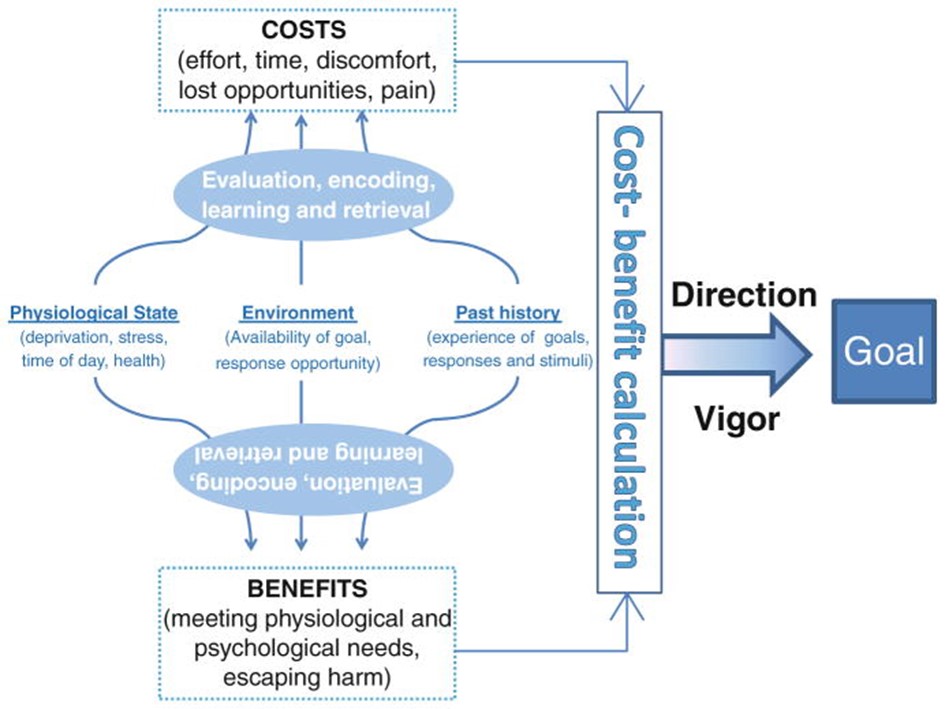
What lessons can be learned about motivating a sales team and identifying motivation killers based on this scientific research?
N°1: All motivation is individual; it takes into account many factors such as personal history, experience of achieving previous objectives, physiological conditions and others that are unique to each individual
N°2: Regularly conducting a motivation review with each of your salespeople is mandatory to lift the obscurity on some of these factors
N°3: The objective to be achieved and the associated reward must be clear so that the brain can memorize the value of the action
N°4: It is possible to do an initial cost/benefit analysis of the objective to be achieved and present it to the salespeople to facilitate the analysis and coding that will be carried out at the brain level
N°5: No motivation technique is specific and sustainable; it will depend on the environment, the salespeople, and the moment. The company must view motivation with the most incredible humility.
In this context, motivation killers are all standard processes or methods that do not consider the environment and individuals at a given time to achieve a given objective.

Exercise 11.1
1. The reasons why the motivation of a sales team is complex?
2. The process of building motivation at the brain level
3. The mistakes not to make in terms of motivating a sales team
2. UNDERSTAND MOTIVATION KILLERS WITH EXAMPLES
Example N°1: How to kill the development of sales manager skills in one sentence
A large group decides to set up an ambitious training program for its sales managers in sales management. The sales managers are all from internal promotion and have never been trained. Their only management experience is that which they have acquired on the job. The program concerns 500 managers who all have between 10 and 25 years of seniority in the company. Resistance to change at the start of the program is strong. The techniques communicated during the training are concrete and operational. Sales managers can see the immediate benefits of applying the methods the day after each training. As the weeks go by, the program benefits from positive word of mouth from sales managers. They find real motivation at different levels, both personally and professionally. Resistance to change is removed. One last step remains to convince the Management Committee of the need to transform the program into ongoing training. The project is presented to the Management Committee. The group president has yet to gain experience in the sales function; his training and prior experience is that of a financier. At the end of the presentation, he asks a question that ruined the project and the Management Committee’s vote in his favour: Training Sales Managers for what? This example serves as a reminder for all of us to consider the perspective of the sales team and avoid similar mistakes in our own roles.
Example N°2: In the customer’s bed
One of the main concerns of any hotel, particularly luxury hotels, is the cleanliness of the rooms. A chambermaid is responsible for cleaning and tidying impeccably between 12 and 15 rooms every day. The chambermaids are managed by a housekeeper who checks the cleanliness of each room that has just been cleaned. The work is exhausting, mistakes or oversights are frequent, and the motivation of the chambermaids is a real challenge. During a management meeting, the rooms division manager asks the general housekeeper why the chambermaids cannot have impeccable rooms? He adds that they should put themselves in the shoes of the customer. At the end of the discussion, an external consultant at the meeting explained that it is tough for a chambermaid to put herself in the shoes of a customer who spends in one night at the hotel what the chambermaid earns in two weeks. The consultant then proposes an original solution. The chambermaids are invited to spend a weekend at the hotel with their husbands or whoever they want. They were only asked to make a report after their weekend, listing all the points to improve in the rooms from the customer’s point of view. The action was a real success. The improvements proposed were sensible and customer oriented. The chambermaids were able to see their job differently. 99% of the errors and omissions concerning the cleanliness of the rooms were eliminated. The motivation of the women was at its highest level and linked to several causes:
1. The chambermaids felt considered to have been invited as customers
2. They felt invested in a real mission by proposing improvements following their weekend at the hotel
3. The quality control of the rooms was not only the housekeeper’s responsibility but had become theirs.
3.SIGNIFICANCE OF THE METHOD TO IDENTIFY MOTIVATION KILLERS
Domain N°1: The current motivation system, which relies solely on extrinsic motivation, has its limitations. While it may drive short-term performance, it often fails to sustain long-term engagement and productivity.
Intrinsic motivation comes from the individual. They set goals to achieve personal needs or ambitions. Intrinsic motivation is stronger and more sustainable than extrinsic motivation. Extrinsic motivations are all the actions that are imagined by the company so that salespeople achieve and exceed their goals. Motivation is based on external rewards such as money, privileges, and power. It is not based on the satisfaction of personal needs or ambitions. Any extrinsic motivation action is short-lived. It must be constantly renewed and only guarantees to motivate part of the sales team. Motivation is a two-way system. The company must check the intrinsic motivations of the salesperson during the recruitment phase and then make regular points to see if they are evolving and are still compatible with the company’s objectives. It must also provide a reward system based on money, benefits in kind, training or free time. No motivation system based on external rewards will have any influence if the position occupied by the salesperson does not meet their internal motivation.
Domain N°2: The motivation system is not adapted to each salesperson
The company has imagined a reward system that is the same for everyone: more money for achieving objectives. Money can be a motivating factor for some and not for others. Standard recipes are applied to individuals who have different needs or dreams. It was long believed that money was the primary tool for motivating salespeople. The new generations of salespeople are more motivated by a fair balance between personal and professional life, the possibility of working remotely or having one or two days OFF as a reward. The motivation factor of a salesperson, when they join the company, can evolve at the pace of the various changes in their personal life. A single salesperson motivated by money will be much more motivated by rewards such as days off when he has a family and young child.
Area No. 3: The motivation system is not adapted to the culture of the country in which the sales team is located
Sometimes, the head office teams decide on the motivation system to apply to all subsidiaries in other countries. As we explained in our introduction, motivation is multi-factorial. The conditions of the environment enter in what is considered by the brain of everyone to calculate and code the cost/benefit ratio in relation to the objective to be achieved. The environment implies values and cultural differences, which can be the following:
• A strong or weak relationship with the hierarchy
• An individualistic or collective culture
• The perception of a financial or non-financial reward
• The perception of the short-term and the long-term
Domain N°4: Salespeople don’t know how to deal with difficult thoughts
Our primary mission is to solve problems. These problems can be a dispute or the loss of a customer, a drop in turnover or attacks from the competition. Stress or a drop in motivation can be due to the inability of salespeople not to manage the problems but to manage the problematic thoughts that run in a loop in their brain and are linked to this problem. It’s crucial to remember that the sales team plays a vital role in problem-solving, and their efforts are integral to the company’s success.
The first training session for any sales team member should be based on managing complex thoughts that affect performance and motivation. The primary function of the brain is survival. Our cognitive functions constantly imagine the worst as soon as a potential physical or non-physical danger threatens us. Having complex thoughts is part of being human, and it is impossible not to have them. All movements that advocate positive thinking are in opposition to the natural cognitive functioning of the brain, which is to imagine the worst and protect ourselves from the worst. The only way not to have complex thoughts is to no longer live. Depending on our childhood, education and experience, some of us know how to manage our complex thoughts, while others do not. These thoughts of failure obsess them and exert an influence on their energy, actions and motivation. Complex thoughts are like a radio show. We do not control the radio program, but we can either increase the volume or decrease it so that we do not listen to it anymore. All techniques for managing complex thoughts are based on our ability to reduce the influence that these thoughts will have on our will to act and our actions.
Domain N°5: The low level of leadership of sales managers
The leadership of the sales manager is an important element of extrinsic motivation daily. Our definition of leadership is as follows:
• A leader is someone who makes his team want to be like him
• A leader does not need to give orders; his team does what he asks because they want to please him
• A leader takes risks that his salespeople would not take, and this is what gives him legitimate authority over his team
Detailing the repercussions of a leadership deficit at the sales manager level, which can leave the sales team without a guiding example. In such a scenario, the sales team might feel abandoned and directionless, much like a top athlete without a coach, who might struggle to win any competition.
Domain N°6: Sales problems are perceived by the company as disasters
The company has an anxiety-provoking perception of problems. As soon as a sales problem occurs, we look for those responsible for the problem rather than the causes of the problem. Salespeople live in constant anxiety that a difficulty will arise. Everyone blames each other, lacks team spirit, and low motivation. The reason for being of any company is to fill a gap concerning a target customer, that is to solve a problem. No company can grow without facing difficulties, and the ability to solve challenges is its strength. Every salesperson should have a briefing on solving commercial problems during their onboarding with the following:
• The company’s positive vision of solving problems
• Acceptance of problems when they arise
• The role of each person in solving problems
• The factual and rational method to collectively solve any commercial or other problem
Domain N°7: Expensive extrinsic motivation actions that don’t motivate anyone
Companies with little proximity to their sales teams believe they can make up for everything that has yet to be done regarding salespeople’s care with a single motivational action that should make them dream. It organizes a TEAM BUILDING seminar or motivation or different ridiculous and wholly disconnected from reality activities, ranging from fire walking to bungee jumping to hot air ballooning. Organizing such events brings added value only if it is the culmination of a structured and individualized motivation system during the year. They get nothing if the event is organized to catch up on everything that has not been done for one or more years.
Domain N°8: Zero motivation points during periodic individual interviews with salespeople
Intrinsic motivation has more influence on salesperson motivation than extrinsic motivation. Few sales managers take the time to assess the salesperson’s personal motivations, see how they are evolving, and determine whether they still align with the company’s position and mission.

Exercise 11.2

Case Study – Partouche
The context:
Founded in 1973, the PARTOUCHE Group has developed to become a European leader in its sector of activity. Listed on the stock exchange, it operates casinos, a gaming club, hotels, restaurants, thermal spas, and golf courses. The Group operates 41 casinos, employs nearly 3,900 people, and has a turnover of approximately 430 million euros. It is recognized for its forward-thinking innovations and experiments in the games of tomorrow, which allows it to confidently approach the future by aiming to strengthen its leadership and continue to increase its profitability.
The revenue killer and its solution:
One of the activities of the PARTOUCHE group within its hotels and casinos is meetings & events. The establishments benefit from meeting or banquet rooms with all the hotel infrastructure to hold private events, training seminars, conferences, or new product launch events. In each hotel or casino of the PARTOUCHE group, a salesperson is responsible for prospecting, establishing offers and coordinating the event with the client and the hotel services. The Group notes that it is challenging to remotely manage isolated salespeople in each of its establishments. This isolation is reinforced by the fact that the meetings & events activity is not the priority of casino managers in terms of turnover. Given the volume of business achieved, it is impossible to expand the team with several salespeople. The turnover rate is high, and out-boarding interviews show that the main reason for voluntary departures is feeling alone and unrecognised. To overcome this situation, the Group has appointed two national functional managers responsible for daily monitoring of the team. Collective WhatsApp groups, as well as individual points, are planned. A significant sales training program with different levels according to each person’s achievements is set up to promote professional mobility within the Group. An annual sales convention is organized to unite a team whose members never see each other.
The results:
The Group notes, after a period of a few months, a significant evolution in the number of new customers as well as a decrease in the staff turnover rate. This positive trend bodes well for our future and underscores the effectiveness of our solution.
DONT FORGET

Course Manual 12: Evaluation Killers
Objectives
1. What is an evaluation killer?
2. Understand evaluation killers with examples
3. Significance of the method to Identify evaluation Killers
1.WHAT IS AN EVALUATION KILLER?
Three out of ten employees say they cannot express themselves freely during annual performance reviews, and 95% of managers are unsatisfied with the annual performance review system, 70% of whom believe performance reviews are a waste of time (source BVA group 2019).
The leading killer of a sales performance review system is the system itself. We affirm that most performance review systems are useless and do not allow salespeople to improve in any way. Employee performance review systems are a legacy of the Taylorization of work, where employees perform repetitive tasks. The assessment was a tool for monitoring the proper execution of tasks. No one was asked to think or take initiative but to apply. In a system based 100% on the application of functions, it was essential at certain times to validate with the employee what was good or not. In a digital economy, salespeople are asked to think, take initiative, and constantly adapt to changes in direction or unforeseen events. It is only possible to impartially evaluate your salespeople in complex and difficult-to-model sales situations by generating frustration and attacking their motivation. In such a context, mobilizing two hours of the manager’s and salesperson’s time to fill out a grid with scales ranging from 1 to 5 is a waste of time.
The main objective of the evaluation system is to help each salesperson improve and achieve better results. However, no matter how elaborated the evaluation grid or how formal the interview, these traditional methods are simply not effective. We are using the wrong means to achieve the right objective. It’s time to acknowledge the inefficiency of these methods and adopt a more efficient system that truly helps salespeople improve.
What truly enables a salesperson to improve is practical learning experiences, such as accompanying a more experienced colleague on a customer visit. These experiences provide a different perspective on how to approach sales and can help identify and correct undesirable habits. Regular feedback and open conversations with a sales manager are also crucial. These interactions allow salespeople to discuss, exchange ideas, and resolve difficulties without the fear of being academically graded, as in a college setting. It is these practical experiences and open dialogues that truly foster improvement in sales performance.
The real killers of evaluation are all rigid and standardized systems that no longer correspond to the current context. The objective of evaluation should be to help salespeople improve their skills and convert more sales. However, these traditional systems are not dynamic or adaptive enough to meet this objective. It’s time to move away from these systems and adopt a more flexible and adaptive approach to evaluation.

Exercise 12.1
2. UNDERSTAND EVALUATION KILLERS WITH EXAMPLES
Example N°1: Evaluation scales that mean nothing
A group of retail stores specializing in home decor has set up an evaluation system for store managers. The evaluation aims to rate all the skills expected by the brand: inventory management, compliance with margin targets, store merchandising, sales team management, schedule management and optimization of sales hours, customer relations, and organization of sales and promotion periods. Managers are evaluated during a two-hour annual interview. The Regional Director, the store manager’s direct superior, leads the interview. The Regional Director reviews all the skills, asks the store manager for their opinion and then rates the skill on the evaluation grid according to a 5-point scale: Unacceptable. Needs improvement. Acceptable. Good. Excellent.
Store managers perceive the evaluation method and rating system negatively. The rating is subjective because it is based solely on the opinion and positive or negative prejudices the Regional Director may have about the store manager.
The system needs to be fairer because it tends to give more importance to recent events and results than those from the beginning of the year. The legitimacy of regional managers as evaluators is strongly questioned because they only visit each store two or three times a year. The evaluations don’t improve store managers’ skills.
Example N°2: When technology kills the evaluation
There are more and more WEB platforms or artificial intelligence solutions to help HR departments and evaluators save time on evaluations. The functionalities are multiple. They can be a good tool when they allow the preparation of tasks that previously did not require human intervention or had low added value. They can be counterproductive when they cause the evaluation to lose its relational and human character. Salespeople come to the evaluation meeting with fears, hopes, questions, misunderstandings, and emotions.
Delegating this aspect to digital tools is undoubtedly more accessible in terms of information processing but completely distorts the primary function of the evaluation, which should help each salesperson give the best of themselves while integrating the objectives and frameworks of their company.
3.SIGNIFICANCE OF THE METHOD TO IDENTIFY MOTIVATION KILLERS
Domain N°1: An evaluation system without a specific objective
Many companies have an evaluation system because you must have one, and no one questions this paradigm. Some say you must have an evaluation system to inform the salesperson about their performance. There is another, much more factual way to measure performance, which is through conversion rate, turnover achieved, and customer feedback. However, these are only quantitative measures. To provide a more comprehensive view, we should also consider qualitative factors such as the salesperson’s ability to build relationships, their problem-solving skills, and their adaptability. Others will say evaluations help decide whether to give a salary increase. No company needs an evaluation grid to decide on a salary increase or a promotion. The latter is convinced that the evaluation can be used as evidence during a dispute with an employee to be able to separate from them. This vision is erroneous because, statistically, no evaluator dares to give ratings below 3 out of 5 so that the salesperson is not demotivated.
Domain N°2: A standard and rigid evaluation system
Salespeople are all evaluated similarly according to standard criteria regardless of the situation. This rigid approach does not consider the different roles and situations of salespeople. Some salespeople will be dedicated to retaining active customers, and others will be devoted to prospecting. The most senior salespeople may have mentoring roles for new salespeople. Depending on the type of customer, the sales approach will have to be different and require different skills. A salesperson will spend more time with significant customers where he will have to demonstrate hyper-personalization and management of multiple contacts. In contrast, a salesperson with a portfolio of low-turnover customers must have a much more industrial approach. A more flexible evaluation system that can adapt to these different roles and situations will provide a more accurate assessment of their performance.
Domain N°3: An evaluation system based solely on results
The evaluation system is based solely on achieving results in terms of turnover, such that the salespeople who perform best financially always have the best evaluations. The system is not designed to recognize individual initiatives or contributions that do not directly generate sales. Those who provide additional value become discouraged
Domain N°4: Managers have not been trained to evaluate their salespeople
The company needs to give sales managers the skills to assess their salespeople. They conduct the evaluation interview while maintaining their role as managers, resulting in the salesperson hesitating to confide and not feeling comfortable.
It’s important to consider external factors such as market conditions in evaluations. Ignoring these factors can lead to unfair ratings and a lack of trust in the system. By incorporating these external influences, we can create a more comprehensive and reliable evaluation system.
Domain N° 5: Salespeople are not involved in their evaluation process
The evaluation system is top-down. Salespeople are called to their evaluation interviews, listen to their manager, and answer their questions. At no time beforehand are salespeople consulted to prepare the evaluation so that it is as fair as possible and considers the facts, examples, and feedback from each salesperson. The review must be completed because it only finds the evaluator’s vision when faced with a passive salesperson.
Domain N°6: Zero follow-up after performance evaluation
As in many companies, the annual evaluation takes time and is experienced as a necessary evil by salespeople and their managers. Everyone is pleased once the evaluation interview has been completed. This one often has been experienced, like a dentist appointment. Very rarely is a post-evaluation follow-up planned to see how the salesperson is progressing regarding what was said and decided their successes and difficulties, and how the evaluation has enabled them to improve. Companies must set up post-evaluation follow-ups because they need a better evaluation vision. The assessment must take stock of the past year and note the improvement or decline in performance. They have yet to understand that the review should not be oriented towards the past but the future. The assessment is not a review but an individual action plan for the coming year. Focusing only on the past without considering future ambitions and opportunities is a major demotivating factor.
Domain N°7: 100% of the evaluation system is based on the annual interview
The evaluation system is based solely on the annual interview. Managers spend much time preparing the evaluation, which is heavy and complex and sometimes mobilizes each sales manager for 3 to 4 weeks. No intermediate point or feedback is planned during the year to have a linear and progressive system that allows one to note situations, results, and input when they occur.
Domain N°8: Evaluations are not balanced.
Evaluations can be unbalanced in several ways. One is an imbalance between the quantitative and the qualitative. We focus too much on achieving numerical objectives and less on qualitative objectives such as participation in functional projects, customer satisfaction, or proposed initiatives. Another is an imbalance between failures and successes. The evaluator tends to insist on errors or weaknesses and not spend as much time taking stock of successes or positive points.
Domain N°9: Evaluations are disconnected from rewards
The evaluation system is not designed to reward the best-performing salespeople, whether in terms of salary increases, responsibilities, or promotions. On the contrary, we will tell the salesperson that although his results are excellent, the compensation is part of the company’s overall budgetary framework that meets other criteria to be considered. The evaluation will no longer have any meaning in the eyes of the salespeople.
Domain N°10: Evaluations are incomprehensible
Evaluations are often incomprehensible when the company pushes its culture of control. The evaluation grids include too many criteria instead of focusing on 4 to 5 core skills. No manager or salesperson can distinguish between what is essential and what is not.
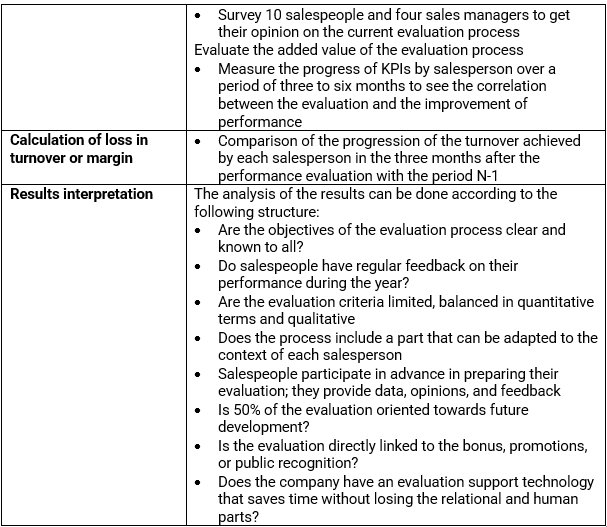

Exercise 12.2

Case Study – Engie
The context:
With a turnover of 82 billion euros, ENGIE is a leading global group in low-carbon energy and services. With 97,000 employees, ENGIE is committed to accelerating the transition to a carbon-neutral world thanks to more energy-efficient and environmentally friendly solutions. This commitment is at the core of ENGIE’s unique vision on the market: the alliance of the molecule and the electron.
The revenue killer and its solution:
ENGIE does not have its own sales force to sell and distribute its energy contracts (gas and electricity) to its individual customers. It has set up a door-to-door sales system using subcontractors. Subcontractors have a monthly contract target to complete and are paid 100% commission on sales made. This commission system, which is financially very attractive for subcontractors, is a key motivator behind their sales practices. After 18 months, the increase in turnover is significant but the impact in terms of image is negative. ENGIE is accused of forced sales and unfair competition, posing a serious risk to its reputation. A project to assess and monitor subcontractors is set up to correct the situation. Commercial and ethical standards are formulated and communicated to subcontractors who must apply them in sales situations. An independent body randomly accompanies subcontractors’ salespeople on sales visits to verify that sales and ethical standards are applied. This case is a counterexample to our vision of eliminating any assessment system. In this context where the objective of the assessment was purely to monitor standards, it had its reason for being.
The results:
The application rate of ethical sales standards increased from 70% to 92% in less than 18 months.
Don’t Forget
Project Studies
Project Study (Part 1) – Introduction
The Head of this Department is to provide a detailed report relating to the Revenue Killers process that has been implemented within their department, together with all key stakeholders, as a result of conducting this workshop, incorporating process: planning; development; implementation; management; and review. Your process should feature the following 12 parts:
• Review the content of course manual 1
• Prepare an oral presentation of 20 minutes maximum based on the content of course manual one that explains:
o What is a revenue killer?
o The different categories of revenue killer
o Why should revenue killers be identified?
o The 10 areas where revenue killers can come from (from customers to motivation)
o Who will be responsible internally, area by area, for identifying revenue killers
• Plan and lead several 30-minutes meetings to inform the following targets internally:
o The Management Committee
o The Sales Department and sales representatives
o The heads of support departments in daily interactions with the sales department (finance, IT, HR and others)
Please include the results of the initial evaluation and assessment.
Project Study (Part 2) – Client Killers
The Head of this Department is to provide a detailed report relating to the Revenue Killers process that has been implemented within their department, together with all key stakeholders, as a result of conducting this workshop, incorporating process: planning; development; implementation; management; and review. Your process should feature the following 12 parts:
• Review the content of course manual 2
Option A – Identification of killer customers in B2C
• Select the number and cities of stores that will be audited to identify killer customers
• Prepare and lead a remote meeting (TEAMS, ZOOM or others) to inform store managers about the objectives, method and expected results of identifying killer customers
• Prepare all the elements to measure the reasons for customers who did not buy when leaving the store. The paper or digital questionnaire with the time, the customer, the purchase intention and the reasons for non-purchase (see course manual 2)
• Prepare all the elements to measure the availability of salespeople. The paper or digital questionnaire with the customer, the time of arrival at the store, the time of contact with the salesperson, the time between the time of arrival and the time of contact with the salesperson
• Prepare all the elements to measure the ability of salespeople to sell quickly and satisfactorily. The paper or digital questionnaire with the customer, the time of contact with the seller, the time of delivery of purchases and the duration of the sale
• Prepare all the elements to evaluate the quality of the purchasing experience during low-traffic hours. Design or use a grid of quality criteria for the shopping experience that must be applied by each salesperson and at each stage of the customer journey in the store:
1. Arrival of the customer in the store
2. Observation of the customer upon arrival
3. First contact with the customer
4. Get the customer to talk about their needs and prior research on the WEB
5. Show or have the customer try the selected products
6. Explain the product benefits of the customer’s research
7. Dare to offer complementary products that the customer would not have thought of
8. Answer all the customer’s questions
9. Encourage the customer to decide
10. Encourage the customer who does not buy to finalize their purchase on the WEB site once they have decided
11. Finalize the customer’s purchase
12. Give the customer their purchases
13. Accompany them to the store door, thank them for their purchase and greet them
• Plan the dates of store visits and carry out the various observations according to what has been prepared
Option B – Identification of killer customers in B2B
Interviews with customers and prospects:
• Prepare the questionnaire intended to collect the opinions of prospects and customers on the quality of the sales approach; the themes to be explored may be the following (to be adapted according to your profession and sales cycle):
o How the sales representatives made contact
o The arguments used to arouse interest
o The sales representative’s prior knowledge of the client’s company
o The questions asked by the sales representative to understand the customer’s profession, challenges and needs
o The adequacy of the commercial offer in response to the challenges and expectations expressed
o The originality of the offer and the ability to propose solutions that the customer would never have thought of
o The quantity of written or oral exchanges
o The quality of written and oral exchanges
o The sales representative’s responsiveness to requests or unforeseen situations
o The evidence provided to reassure and help the customer decide
o The feeling of trust perceived by the customer
o The evaluation of the whole process compared to that of competitors
o The salesperson’s attitude when faced with a refusal
• Test the questionnaire and improve it following the test
• Select a sample of 10 customers:
o Three customers who have been active for more than two years
o Three new customers acquired less than six months ago
o Two prospects working with competitors
o Two prospects who have refused the commercial offer
• Make appointments and conduct the ten interviews face-to-face or remotely
• Record the interviews
• Transcribe and summarize the interviews
Please include the results of the initial evaluation and assessment.
Project Study (Part 3) – Distributor killers
The Head of this Department is to provide a detailed report relating to the Revenue Killers process that has been implemented within their department, together with all key stakeholders, as a result of conducting this workshop, incorporating process: planning; development; implementation; management; and review. Your process should feature the following 12 parts:
Review the content of course manual 3
Assess the quality of the prospecting process for new distributors:
Analyze and evaluate with the help of the Sales Director the different stages of the prospecting process for new distributors:
• Understanding the distributor’s potential resistance to changing partners
• Objective and content of the first meeting with the distributor
• Establishment of a periodic and gradual relationship
• Detection of an opportunity and proposal of a product test on low volumes
• Collection of distributor feedback
• Measurement of results and improvements
Assess the business coaching skills of your salespeople
• Prepare a skills grid to check the salespeople’s business coaching skills and inspire them to help their distributors sell more of your products through improvement. The criteria to be observed may be the following (to be adapted according to the profession, the products and the distribution network)
o Has the salesperson prepared his distributor visit? The salesperson identified the product families that were decreasing and increasing at the distributor.
o The salesperson prepared their visit objectives.
o The salesperson announced their visit objectives.
o The salesperson asked the distributor about their objectives.
o The salesperson asked the distributor about the evolution of their number of customers.
o The salesperson asked the distributor about the potential causes of the decrease or increase in the number of customers.
o The salesperson asked the distributor their objectives for acquiring new customers.
o The salesperson asked the distributor which means or channels they plan to acquire new customers.
o The salesperson asked the distributor about the return on investment for each sales channel.
o The salesperson checked what the distributor knew about the products.
o The salesperson asked if the distributor used their products personally.
o The salesperson asked the distributor if they regularly questioned their customers to find out their expectations.
o The salesperson asked the distributor for their Google customer score.
o The salesperson asked the distributor what their approach was to improve their quality of service after a negative review.
o The salesperson presents the results to date
o The salesperson presents the distributor’s ranking of the network
o The salesperson presents the results by product family
o The salesperson discusses the results of the strategic families as a priority
o The salesperson gets the distributor to talk and identifies the causes of the results obtained
o The salesperson asks the distributor for his ideas for corrective actions.
o The salesperson selects with the distributor simple and quick actions to correct the situation before the next visit
o The salesperson concludes the visit by asking the distributor to summarize the key points of the visit
o The salesperson analyzes the quality of his visit
o The visit objectives have been achieved
o The distributor has committed to a simple and operational action plan
o The salesperson has identified the difficulties to be resolved to help the distributor sell more
• Accompany 5 salespeople on a sales visit to 5 different distributors.
• Record interviews with distributors or take notes
• Transcribe and summarize interviews
• Evaluate practices based on the skills grid
Please include the results of the initial evaluation and assessment.
Project Study (Part 4) – Productivity killers
The Head of this Department is to provide a detailed report relating to the Revenue Killers process that has been implemented within their department, together with all key stakeholders, as a result of conducting this workshop, incorporating process: planning; development; implementation; management; and review. Your process should feature the following 12 parts:
• Review the content of course manual 4
• Prepare a questionnaire to conduct qualitative interviews and collect the opinions and perceptions of salespeople on the points that negatively impact their productivity
• Test and refine the questionnaire to ensure it accurately captures the insights we need to improve sales productivity.
• Observe five salespeople for five days to observe and identify productivity killers in real work situations and, more specifically, in the following areas:
o Multitasking
o Anticipatory organization of the workweek
o Internal meetings
o Visit Report
o Use of the diary
o Lack or complexity of processes
o Sales skills
Analyse the results of discussions and observations to determine:
• What are the recurring and planned tasks?
• What is the total time invested in these tasks?
• Is the time invested fair?
• What are unplanned tasks?
• What is the total time invested in these tasks?
• Is the time spent on unplanned tasks more or less than on planned tasks?
• Which planned and unplanned tasks are directly linked to generating revenue?
• Which of the planned and unplanned tasks do not generate any revenue?
• Which useless tasks are given to salespeople and can be deleted or delegated to other departments?
• What is the time spent and hourly cost of each task?
• How many hours per week can be saved by optimizing all these tasks?
Please include the results of the initial evaluation and assessment.
Project Study (Part 5) – Recruitment killers
The Head of this Department is to provide a detailed report relating to the Revenue Killers process that has been implemented within their department, together with all key stakeholders, as a result of conducting this workshop, incorporating process: planning; development; implementation; management; and review. Your process should feature the following 12 parts:
• Review the content of course manual 5
• List the different stages of the current recruitment process:
o Identification of positions to be filled
o Writing job offers
o Sourcing candidates and different sourcing channels
o Selection of resumes
o Selection interviews (telephone, TEAMS, face-to-face, video)
o Tests and assessments
o Reference checks
o Hiring decision
o Communication with the candidate during all stages of recruitment
• Analyse each stage of the recruitment process based on the seven areas of recruitment killers
• Domain N°1: Your company is hermaphrodite
• Domain N°2: Zero KPIs to measure the performance of your recruitment
• Domain N°3: A rigid and immovable recruitment process
• Domain N°4: Personality tests with no scientific basis
• Domain N°5: A vision of recruiting your salespeople based on myths.
• Domain N°6: An imbalance in your recruitment process
• Domain N°7: A lack or absence of technology in your recruitment process
• Prepare the qualitative interview questionnaire for sales managers
• Conduct qualitative interviews with sales managers to get their vision on the quality of the candidates recruited
• Record the interviews with or take notes
• Transcribe and summarize the interviews
• Prepare the qualitative interview questionnaire for candidates
• Conduct five qualitative interviews with candidates identified as future salespeople and who refused the offer or left the recruitment process
• Record the interviews with or take notes
• Transcribe and summarize the interviews
• Analyse all the documents used during the recruitment process
• Evaluate the performance of the recruitment process based on the following KPIs, which are crucial for measuring our success: Time to hire, cost to hire, retention rate, hiring manager satisfaction, candidate rejection reason, cost of a resignation.
• Analyse all the results to determine:
o Does your company only recruit candidates from your industry?
o Do you have KPIs to measure the effectiveness of your recruitment process?
o Is your recruitment process updated at least twice a year?
o o What are the natural scientific foundations of your personality tests?
o o What are your company’s recruitment myths?
o Is your recruitment process balanced, or does it rely too heavily on qualitative interviews, making up 80% of the process?
o What are the technological gaps that slow down your recruitment process, and how can they be addressed to improve efficiency?
Please include the results of the initial evaluation and assessment.
Project Study (Part 6) – Onboarding killers
The Head of this Department is to provide a detailed report relating to the Revenue Killers process that has been implemented within their department, together with all key stakeholders, as a result of conducting this workshop, incorporating process: planning; development; implementation; management; and review. Your process should feature the following 12 parts:
• Review the content of course manual 6
• List the different stages of the current onboarding journey
• Evaluate the qualitative and quantitative objectives of the onboarding journey
• Compare the turnover results of new salespeople with senior salespeople
• Measure the turnover rate and compare it with industry standards
• Observe internal trainers in training situations for new salespeople
• Have feedback interviews with five new salespeople on onboarding based on the sample questions below:
o How would you describe your overall experience of the onboarding process?
o Were the objectives and responsibilities of your mission communicated from your first day in the company?
o Did you receive all the necessary resources from your first day to start your job effectively?
o To what extent did you feel ready to develop sales after the initial training?
o How do you evaluate the organization and the different stages of the onboarding program?
o How useful was the initial training in understanding the sales strategy, challenges, customers, and competitors?
o Did you have many opportunities to ask questions and clarify doubts during the onboarding?
o Were the sales managers present and helpful during the first month?
o Was there any part of the onboarding process that you found complicated or unnecessary?
o What improvements or changes would you suggest ?
o Did the onboarding help you feel welcomed and integrated into the sales team and the company?
o To what extent did the onboarding process meet your expectations?
o Would you recommend our company to other future salespeople?
• Have feedback interviews with three sales managers on the onboarding of their new salespeople using the sample questions below:
o Did the new salespeople quickly achieve their sales targets after their onboarding?
o Do new salespeople receive sufficient training on the tools and CRM they should use?
o How do new salespeople integrate into the team after onboarding?
o What are the performance gaps between new and existing salespeople?
o Are salespeople sufficiently prepared to handle complex sales situations and adapt to unforeseen events after onboarding?
o What feedback do new salespeople give about the strengths and weaknesses of their onboarding?
o What aspects of the integration journey could be improved so salespeople can achieve their objectives more quickly?
o Does onboarding allow new salespeople to understand the sales strategy, customers, and market challenges?
Please include the results of the initial evaluation and assessment.
Project Study (Part 7) – Sales coaching killers
The Head of this Department is to provide a detailed report relating to the Revenue Killers process that has been implemented within their department, together with all key stakeholders, as a result of conducting this workshop, incorporating process: planning; development; implementation; management; and review. Your process should feature the following 12 parts:
• Review the content of course manual 7
• Evaluate the quantitative aspects of the coaching system:
o What are the coaching objectives set for sales managers?
o How many salespeople can we potentially uplift through our coaching system?
o How many coaching sessions per salesperson per year?
o How long are the coaching sessions?
o What are the objectives set at the end of a coaching session?
o What follow-up is carried out after a coaching session?
• Prepare an observation grid to evaluate the skills of sales managers in an actual situation of coaching their salespeople
• Observation of 5 different sales managers in an actual situation of coaching their salespeople
• Feedback from salespeople on the benefits of sales coaching based on the following sample questions:
o How do you evaluate real-life coaching today to achieve your turnover objectives?
o What is your opinion on the number and duration of coaching sessions?
o What does real-life coaching bring you in addition to the initial training?
o Does the advice received following coaching help you improve your performance?
o Which of the following skills did coaching help you improve:
– Prepare your sales visit quickly and well
– Define your visit objectives
– Get the customer talking
– Dare to sell more
– Argue using the opportunities identified in the customer’s comments
– Negotiate without margin loss
– Achieve your visit objectives
– Adapt to all types of customers and manage the unexpected
– Resolve complex business situations
Please include the results of the initial evaluation and assessment.
Project Study (Part 8) – Sales management killers
The Head of this Department is to provide a detailed report relating to the Revenue Killers process that has been implemented within their department, together with all key stakeholders, as a result of conducting this workshop, incorporating process: planning; development; implementation; management; and review. Your process should feature the following 12 parts:
• Review the content of course manual 8
• List the recurring management actions
• Evaluate these actions:
o Number of actions
o Objectives of each action
o Time spent
o Results of the action
o Mode: face-to-face, remote or other
• Evaluate the management standards or processes common to all sales managers:
o What is the added value of these processes?
o How do they optimize sales productivity
o Are they simple? Easy to understand?
o What can be eliminated or simplified?
o Are they in line with the company’s strategy and market challenges?
• Identification of “wild” management processes developed by sales managers
• Observation of sales managers in their management actions (collective sales meetings, performance review, coaching)
o What is the objective of the action?
o Number and type of participants?
o Duration of the action?
o Results?
o Direct or indirect link of the action with sales development?
• Conduct feedback interviews with 5 salespeople to assess their opinions on current sales management based on the following example questions:
o How clear and consistent is the communication from sales management regarding goals and expectations?
o How involved are you in the planning and goal-setting processes?
o How often do you receive feedback from your manager, and how constructive is it?
o How accessible is your sales manager when you need guidance or support?
o Do you feel your manager advocates for the sales team within the organization?
o How effectively does your manager provide sales training?
o How does your manager handle underperformance, and do they provide clear improvement plans?
o How does your manager celebrate successes, both individual and team-wide?
• Conduct feedback interviews with five sales managers to assess their opinions on current sales management based on the following example questions: Can you describe how you provide feedback and how often you engage in one-on-one coaching sessions with your team members?
o How do you handle underperforming salespeople, and what steps do you take to help them improve?
o How do you foster a collaborative and supportive team environment?
o What is your process for setting sales targets, and how do you involve your team?
o How do you determine the tools and resources your team needs to succeed?
o What steps do you take to remove obstacles hindering your team’s performance?
o Can you give an example of how you’ve handled a situation where your team missed its sales targets?
o How do you maintain open lines of communication with your team and ensure that feedback is effectively given and received?
o How do you involve your team in decision-making processes that affect their work?
o How do you handle feedback from your team, especially if it’s critical of your management style or decisions?
o How do you measure your success as a sales manager?
o How do you ensure that short-term sales goals do not compromise long-term relationships and business objectives?
Please include the results of the initial evaluation and assessment.

Project Study (Part 9) – Reporting killers
The Head of this Department is to provide a detailed report relating to the Revenue Killers process that has been implemented within their department, together with all key stakeholders, as a result of conducting this workshop, incorporating process: planning; development; implementation; management; and review. Your process should feature the following 12 parts:
• Review the content of course manual 9
• Collect and analyse all reporting documents (paper or digital) generated by the finance department
• Identify the objectives of the commercial reporting
• Assess the quantity and usefulness of the KPIs (objectives, ease of obtaining, frequency of measurement)
o Number of annual action plans implemented
o Number of action plans that have helped improve declining KPIs
o Average time between the communication of the reporting and the implementation of each action
• Time spent producing the reporting
• Assess the quality of the presentation of the results reports
• Conduct a 90-minute qualitative interview with the professional from the finance department responsible for commercial reporting to gain insights and understand the current process
• Calculate the time spent by salespeople generating the figures or information needed for reporting
• Have feedback interviews with four salespeople regarding the added value and current weaknesses of the reporting system
• Have feedback interviews with two sales managers to get their opinion on the reporting generated by the finance department (brakes and accelerators) based on the sample questions following:
o Can you provide an example of a strategic decision that was influenced by insights from commercial reports?
o Are the metrics and KPIs tracked in the reports relevant to your commercial objectives?
o Does the reporting allow you to identify issues or opportunities in the market quickly?
o How often do you use the reports to make day-to-day decisions?
o Have you been able to implement changes based on the information from the reports? If so, what was the impact?
o How would you assess the return on investment (ROI) from the commercial reporting?
o Do you believe the value derived from the reports justifies the resources invested in creating them?
o How adaptable is the reporting system to changes in business strategy or market conditions?
o Can the reports be easily customized to meet specific needs or answer ad-hoc queries?
o How often do you request changes or updates to the reports, and how responsive is the system to these needs?
o How satisfied are you with the overall quality of the commercial reports?
o What improvements would you suggest increasing the value of the reporting?
Please include the results of the initial evaluation and assessment.

Project Study (Part 10) – Resource killers
The Head of this Department is to provide a detailed report relating to the Revenue Killers process that has been implemented within their department, together with all key stakeholders, as a result of conducting this workshop, incorporating process: planning; development; implementation; management; and review. Your process should feature the following 12 parts:
• Review the content of course manual 10
• Analyse the productivity of the sales journey:
o Identify the different stages of the sales journey from prospect sourcing to the start of the collaboration with the new customer
o Analyse productivity at each stage:
– What is the task?
– How long does it take to complete the task?
– Is the task automated?
– If the task is not automated, what existing tool can automate the task?
– Take stock of all tasks to be automated
• Compare the company’s sales resources with those of competitors
o Prepare and lead five interviews with two lost prospects and three active customers, the aim of which is to ask them to compare the company’s tools, resources, and innovations with those of its competitors
• Analyse the internal budget decision-making system, a critical aspect that influences the overall budget requested and allocated to the sales department.
o Overall budget requested by the sales department
o Overall budget allocated to the sales department
o Difference between requested budget and allocated budget
o What requests were refused? For what amount? For what reasons?
o Which internal departments have all their budget requests been accepted? For what amount?
Please include the results of the initial evaluation and assessment.

Project Study (Part 11) – Motivation killers
The Head of this Department is to provide a detailed report relating to the Revenue Killers process that has been implemented within their department, together with all key stakeholders, as a result of conducting this workshop, incorporating process: planning; development; implementation; management; and review. Your process should feature the following 12 parts:
• Review the content of course manual 11
• Assess salespeople’s motivation level
o Motivation self-assessment interviews with five salespeople
• Assess performance level changes
o Consistency with which salespeople meet or exceed their sales targets.
o Sales cycle speed
o Time and speed to close a sale
o Number of calls, emails, meetings, and other sales activities.
• Assess the level of sales engagement
o Attitude during team activities
o Number of improvement ideas or innovations proposed
o Sales team turnover rate
o Customer satisfaction rate
o Objective achievement rate
• Analyse the impact of team motivation based on the information collected
o Impact of hostile work environment
o Impact of lack of resources and tools
o Impact of inadequate financial package and reward
o Impact of unclear objectives
o Impact of low level of sales manager leadership
o Impact of Insufficient Career Development
o Impact of an overwhelming workload
o Impact of Inefficient Sales Processes
o Impact of lack of alignment with personal motivation
Please include the results of the initial evaluation and assessment.

Project Study (Part 12) – Evaluation killers
The Head of this Department is to provide a detailed report relating to the Revenue Killers process that has been implemented within their department, together with all key stakeholders, as a result of conducting this workshop, incorporating process: planning; development; implementation; management; and review. Your process should feature the following 12 parts:
• Review the content of course manual 12
• Evaluate the loss of productivity related to the evaluation of salespeople
o Calculate the time spent by the HR department, sales managers, and salespeople for the evaluation
• Evaluate the internal perception of the evaluation process
o Survey 10 salespeople and four sales managers to get their opinion on the current evaluation process
• Evaluate the added value of the evaluation process
o Measure the progress of KPIs by salesperson over a period of three to six months to see the correlation between the evaluation and the improvement of performance
• Analyse the results according to the information collected:
o Are the objectives of the evaluation process clear and known to all?
o Do salespeople receive regular feedback on their performance during the year?
o Are the evaluation criteria limited, balanced quantitatively and qualitatively?
o Does the process provide for a part that can be adapted to the context of each salesperson?
o Salespeople participate upstream in the preparation of their evaluation; they provide data, opinions, and feedback experience?
o Is 50% of the evaluation oriented towards future development?
o Is the evaluation directly linked to the bonus, promotions or public recognition?
o Does the company have an evaluation support technology that saves time without losing the relational and human parts?
Please include the results of the initial evaluation and assessment.
Program Benefits
Sales
- Strategic alignment
- Sales development
- Improved productivity
- Performance culture
- Shorter sales cycle
- Distributors dynamization
- Skills development
- Sales Innovation
- Stronger commitment
- Customer feedback
Sales Management
- Clear roles
- Homogeneous management
- Productivity management
- Rigorous onboarding
- Turnover reduction
- Team motivation
- Workload improvement
- Low cost to hire
- Coaching system
- Performance review
Finance
- Cost saving
- Reporting simplification
- Faster scaling
- Self-financing
- Internal collaboration
- Monitoring solution
- Time saving
- Updated processes
- Faster decision
- Useful investments
Client Telephone Conference (CTC)
If you have any questions or if you would like to arrange a Client Telephone Conference (CTC) to discuss this particular Unique Consulting Service Proposition (UCSP) in more detail, please CLICK HERE.





